Paul van Yperen's Blog, page 441
October 12, 2013
Hans Richter
Hans Richter (1919-2008) was a German film actor, who started as lovable rascal in many Ufa comedies. Between 1931 and 1984, he appeared in more than 130 films.
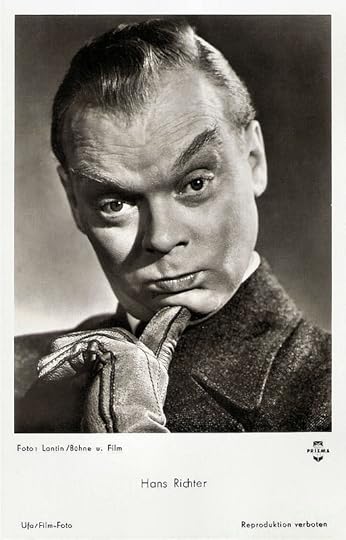
German postcard by Ufa, Berlin-Tempelhof, no. FK 3526. Retail price 25 Pfg. Photo: Lantin / Bühne und Film / Prisma.
A Cheeky Rascal
Hans Richter was born in Nowawes, Germany (now Potsdam) in 1919. He was the son of a singer and a concert master.
At the age of 12 years, he made his film debut as a child actor in the classic Erich Kästner adaptation Emil und die Detektive/Emil and the Detectives (Gerhard Lamprecht, 1931). The script was written by the young Billy Wilder and Emeric Pressburger while author Kästner also attributed to the script.
Richter played one of the Berlin boy detectives, a cheeky rascal, who comes to help Emil (Rolf Wenkhaus) against the man who robbed him from his mother’s money.
With his face, sprinkled with freckles, his protruding ears and snub nose Richter was the ideal choice for lovable school rascals, hotel pages, and newspaper boys.
During the 1930s, he became one of the most important child actors of the Universum Film AG (Ufa).
Richter played one of the pages in the comedy Der Page vom Dalmasse Hotel/The Page from the Dalmasse Hotel (Victor Janson, 1933) starring Dolly Haas .
He appeared in the notorious Nazi-Propaganda film Hitlerjunge Quex/Our Flags Lead Us Forward (Hans Steinhoff, 1933).
He then appeared in Die Englische Heirat/The English Marriage ( Reinhold Schünzel , 1934). In this comedy Renate Müller played a young German woman who is engaged to marry a British aristocrat ( Adolf Wohlbrück ), but has to win over his hostile family. Richter appeared as one of the nephews.
That year he also played a small part in the drama Der schwarze Walfisch/The Black Whale (Fritz Wendhausen, 1934), the German version of Marcel Pagnol’s masterpiece Fanny, starring Emil Jannings .
He also could be seen in the comedy Onkel Bräsig/Uncle Bräsig (Erich Waschneck, 1936) featuring Otto Wernicke, and in Der Mann, der Sherlock Holmes war/Sherlock Holmes (Karl Hartl, 1937) with Heinz Rühmann .
During the war years, he played in the propaganda film Der Fuchs von Glenarvon/The Fox of Glenarvon (Max W. Kimmich, 1940), portraying the years of the Irish fight for independence during World War I, and in the war film Der 5. Juni/5 June (Fritz Kirchhoff, 1942).
He also appeared as a student with Heinz Rühmann in one of the most popular comedies of the era, Die Feuerzangenbowle/The Punch Bowl (Helmut Weiss, 1944).
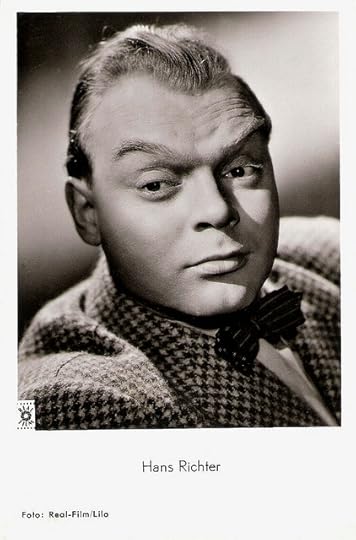
German postcard by Film-Postkarten Verlag, Hamburg-Bergedorf, no. 132. Photo: Real-Film / Lilo.
Chauffeurs, Bus Drivers or Waiters
After graduating from high school in Nowawes in 1943, Hans Richter studied art history and took acting classes with Albert Florath. In 1944 he was drafted into the army and was taken prisoner.
After the war, he performed in cabarets in Munich, but then settled in Hamburg, where he lived until 1960.
In 1949, he finally had a leading role as a clown in the film Artistenblut/Artists blood (Wolfgang Wehrum 1949). It was one of his few serious parts.
Richter played in numerous Heimat films like Schwarzwaldmädel/Black Forest Girl (Hans Deppe, 1950), Grün ist die Heide/The Heath Is Green (Hans Deppe, 1951) and In München steht ein Hofbräuhaus/In Munich stands a Hofbräuhaus (Siegfried Breuer, 1952).
He continued his film career with supporting parts as chauffeurs, bus drivers or waiters in films like the Austrian political satire 1. April 2000/April 1, 2000 (Wolfgang Liebeneiner, 1952), starring Hilde Krahl .
Twice, in Vatertag/Father's Day (Hans Richter, 1955) and Hurrah – Die Firma hat ein Kind/Hurrah - The company has a child (Hans Richter, 1955), he directed himself.
He played a ghost opposite Liselotte Pulver in Das Spukschloß im Spessart/The Haunted Castle (Kurt Hoffmann, 1960), a sequel to the hit Das Wirtshaus im Spessart/The Spessart Inn (Kurt Hoffmann, 1958).
At the 2nd Moscow International Film Festival, the comedy won the Silver Prize.
He was an inspector in the Austrian comedy Die Schwarze Kobra/The Black Cobra (Rudolf Zehetgruber, 1963) starring Adrian Hoven .
He also played in the remake of Die Feuerzangenbowle/The Punch Bowl (Helmut Käutner, 1970), this time as Dr. Brett.
His last major film was the political thriller Section special/Special Section (Costa-Gravas, 1975), situated in occupied France during the WWII.
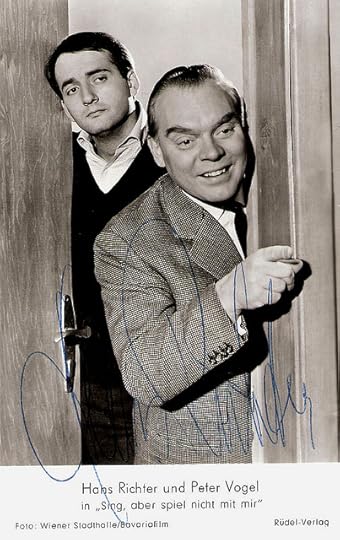
German postcard by Rüdel-Verlag. Photo: Wiener Stadshalle / Bavariafilm. Publicity still for Sing, aber spiel nicht mit mir/Sing, but don't play with me (Kurt Nachmann, 1963) with Peter Vogel.
His Own Theatre Festival
Since the late 1950’s, Hans Richter mainly worked in the theatre.
He acted for several years under the direction of Gustaf Gründgens at the Hamburg Schauspielhaus.
He played in Woyzeck by Georg Büchner, in Bertolt Brecht's play Die heilige Johanna der Schlachthöfe (Saint Joan of the slaughterhouses) and in Waiting for Godot by Samuel Beckett.
In 1974, Hans Richter founded the Heppenheim festival, which henceforth he managed as his own theatre company.
Since 1945, he was married with the publisher and author Dr. Ingeborg Bieber and had two sons, Hans Joachim Richter (1946) and Thomas Richter (1947).
In 1992, Thomas took over the management of the Festival of his father.
In 1983 he was awarded the Bundesverdienstkreuz (Germany’s Cross of Merit) and in 1989 the Filmband in Gold.
Hans Richter died in Heppenheim, Germany in 2008.
Extract of Emil und die Detektive/Emil and the Detectives (1931). Source: BFI Film (YouTube).
Scene from Das Spukschloß im Spessart/The Haunted Castle (1960). Source: Synchro Total (YouTube).
Sources: Film-Zeit.de (German), Filmportal.de (German), Wikipedia (German and English), and .

German postcard by Ufa, Berlin-Tempelhof, no. FK 3526. Retail price 25 Pfg. Photo: Lantin / Bühne und Film / Prisma.
A Cheeky Rascal
Hans Richter was born in Nowawes, Germany (now Potsdam) in 1919. He was the son of a singer and a concert master.
At the age of 12 years, he made his film debut as a child actor in the classic Erich Kästner adaptation Emil und die Detektive/Emil and the Detectives (Gerhard Lamprecht, 1931). The script was written by the young Billy Wilder and Emeric Pressburger while author Kästner also attributed to the script.
Richter played one of the Berlin boy detectives, a cheeky rascal, who comes to help Emil (Rolf Wenkhaus) against the man who robbed him from his mother’s money.
With his face, sprinkled with freckles, his protruding ears and snub nose Richter was the ideal choice for lovable school rascals, hotel pages, and newspaper boys.
During the 1930s, he became one of the most important child actors of the Universum Film AG (Ufa).
Richter played one of the pages in the comedy Der Page vom Dalmasse Hotel/The Page from the Dalmasse Hotel (Victor Janson, 1933) starring Dolly Haas .
He appeared in the notorious Nazi-Propaganda film Hitlerjunge Quex/Our Flags Lead Us Forward (Hans Steinhoff, 1933).
He then appeared in Die Englische Heirat/The English Marriage ( Reinhold Schünzel , 1934). In this comedy Renate Müller played a young German woman who is engaged to marry a British aristocrat ( Adolf Wohlbrück ), but has to win over his hostile family. Richter appeared as one of the nephews.
That year he also played a small part in the drama Der schwarze Walfisch/The Black Whale (Fritz Wendhausen, 1934), the German version of Marcel Pagnol’s masterpiece Fanny, starring Emil Jannings .
He also could be seen in the comedy Onkel Bräsig/Uncle Bräsig (Erich Waschneck, 1936) featuring Otto Wernicke, and in Der Mann, der Sherlock Holmes war/Sherlock Holmes (Karl Hartl, 1937) with Heinz Rühmann .
During the war years, he played in the propaganda film Der Fuchs von Glenarvon/The Fox of Glenarvon (Max W. Kimmich, 1940), portraying the years of the Irish fight for independence during World War I, and in the war film Der 5. Juni/5 June (Fritz Kirchhoff, 1942).
He also appeared as a student with Heinz Rühmann in one of the most popular comedies of the era, Die Feuerzangenbowle/The Punch Bowl (Helmut Weiss, 1944).

German postcard by Film-Postkarten Verlag, Hamburg-Bergedorf, no. 132. Photo: Real-Film / Lilo.
Chauffeurs, Bus Drivers or Waiters
After graduating from high school in Nowawes in 1943, Hans Richter studied art history and took acting classes with Albert Florath. In 1944 he was drafted into the army and was taken prisoner.
After the war, he performed in cabarets in Munich, but then settled in Hamburg, where he lived until 1960.
In 1949, he finally had a leading role as a clown in the film Artistenblut/Artists blood (Wolfgang Wehrum 1949). It was one of his few serious parts.
Richter played in numerous Heimat films like Schwarzwaldmädel/Black Forest Girl (Hans Deppe, 1950), Grün ist die Heide/The Heath Is Green (Hans Deppe, 1951) and In München steht ein Hofbräuhaus/In Munich stands a Hofbräuhaus (Siegfried Breuer, 1952).
He continued his film career with supporting parts as chauffeurs, bus drivers or waiters in films like the Austrian political satire 1. April 2000/April 1, 2000 (Wolfgang Liebeneiner, 1952), starring Hilde Krahl .
Twice, in Vatertag/Father's Day (Hans Richter, 1955) and Hurrah – Die Firma hat ein Kind/Hurrah - The company has a child (Hans Richter, 1955), he directed himself.
He played a ghost opposite Liselotte Pulver in Das Spukschloß im Spessart/The Haunted Castle (Kurt Hoffmann, 1960), a sequel to the hit Das Wirtshaus im Spessart/The Spessart Inn (Kurt Hoffmann, 1958).
At the 2nd Moscow International Film Festival, the comedy won the Silver Prize.
He was an inspector in the Austrian comedy Die Schwarze Kobra/The Black Cobra (Rudolf Zehetgruber, 1963) starring Adrian Hoven .
He also played in the remake of Die Feuerzangenbowle/The Punch Bowl (Helmut Käutner, 1970), this time as Dr. Brett.
His last major film was the political thriller Section special/Special Section (Costa-Gravas, 1975), situated in occupied France during the WWII.

German postcard by Rüdel-Verlag. Photo: Wiener Stadshalle / Bavariafilm. Publicity still for Sing, aber spiel nicht mit mir/Sing, but don't play with me (Kurt Nachmann, 1963) with Peter Vogel.
His Own Theatre Festival
Since the late 1950’s, Hans Richter mainly worked in the theatre.
He acted for several years under the direction of Gustaf Gründgens at the Hamburg Schauspielhaus.
He played in Woyzeck by Georg Büchner, in Bertolt Brecht's play Die heilige Johanna der Schlachthöfe (Saint Joan of the slaughterhouses) and in Waiting for Godot by Samuel Beckett.
In 1974, Hans Richter founded the Heppenheim festival, which henceforth he managed as his own theatre company.
Since 1945, he was married with the publisher and author Dr. Ingeborg Bieber and had two sons, Hans Joachim Richter (1946) and Thomas Richter (1947).
In 1992, Thomas took over the management of the Festival of his father.
In 1983 he was awarded the Bundesverdienstkreuz (Germany’s Cross of Merit) and in 1989 the Filmband in Gold.
Hans Richter died in Heppenheim, Germany in 2008.
Extract of Emil und die Detektive/Emil and the Detectives (1931). Source: BFI Film (YouTube).
Scene from Das Spukschloß im Spessart/The Haunted Castle (1960). Source: Synchro Total (YouTube).
Sources: Film-Zeit.de (German), Filmportal.de (German), Wikipedia (German and English), and .
Published on October 12, 2013 23:00
October 11, 2013
Imported from the USA: Orson Welles
Today is the final day of Le Giornate del Cinema Muto and of our series of silent stars in honour of David Robinson, the great director of this silent film festival in Pordenone, Italy. The last star in our little silent cinema series is Orson Welles. Why? Last Wednesday, Le Giornate del Cinema Muto presented the world premiere of Too Much Johnson (Orson Welles, 1938), filmed two years before the celebrated American director went to Hollywood to make Citizen Kane (1941). As a member of the Mercury Theatre, Welles created this slapstick short starring Joseph Cotten, for the Theatre’s innovative 1938 production of the 19th-century play by William Gillette. Never finished, the film did not screen publicly and took on legendary status when the single known print reportedly burned. Now after 75 years, the silent comedy was recovered in Italy and finally had its screen debut.
American actor, director, writer and producer Orson Welles (1915-1985) worked in theatre, radio and film, both in the US and in Europe. He is remembered for his innovative work in all three media, most notably Caesar (1937), a ground-breaking Broadway adaptation of Julius Caesar and the debut of the Mercury Theatre; The War of the Worlds (1938), one of the most famous broadcasts in the history of radio; and Citizen Kane (1941), ranked as one of the all-time greatest films. His other films include The Magnificent Ambersons (1942), Touch of Evil (1958) and Le Procès/The Trial (1962).

French postcard by Editions du Globe, no. 143. Photo: Sam Lévin.
The Hearts of Age
George Orson Welles was born in Kenosha, Wisconsin, in 1915. He was the second son of Beatrice (née Ives) and Richard Hodgdon Head Welles.
In 1919, his parents separated and moved to Chicago. His father, who made a fortune as the inventor of a popular bicycle lamp, became an alcoholic and stopped working. His brother ‘Dickie’ was institutionalized at an early age because he had learning difficulties. Welles's mother, a beautiful concert pianist, had to support her son and herself.
In 1924, Beatrice died of hepatitis in a Chicago hospital, just after Welles's ninth birthday. He was taken in by Dudley Crafts Watson. At the age of ten Orson ran away from home with Watson's third daughter, Marjorie. They were found a week later, singing and dancing for money on a street corner in Milwaukee.
Welles' father died when Orson was 15. Maurice Bernstein, a physician from Chicago, became his guardian. His school teacher Roger Hill provided Welles with an ad hoc educational environment that proved invaluable to his creative experience, allowing Welles to perform and stage theatrical experiments and productions.
Welles was awarded a scholarship to Harvard University, but he chose instead to travel to Europe. In Ireland, he strode into the Gate Theatre in Dublin and claimed he was a Broadway star.
The manager of Gate, Hilton Edwards, was impressed by his brashness and an impassioned quality in his audition. Welles made his stage debut at the Gate in 1931, appearing in Jew Suss as the Duke. He acted to great acclaim, word of which reached the United States.
On returning to the United States he wrote the immensely successful Everybody's Shakespeare. In 1933, he toured in three off-Broadway productions with Katharine Cornell's company, including two roles in Romeo and Juliet. In 1934, he shot his first film, an eight-minute short titled The Hearts of Age, and he married Chicago actress Virginia Nicholson.
By 1935 Welles was supplementing his earnings in the theatre as a radio actor, working with many actors who would later form the core of his Mercury Theatre.

Gate Theatre in 2012. Cavendish Row, Parnell Square, Dublin 1, Ireland.
The Night That Panicked America
In 1936, the Federal Theatre Project (part of Roosevelt's Works Progress Administration) put unemployed theatre performers and employees to work.
Orson Welles was hired by John Houseman and assigned to direct a play for the Federal Theatre Project's Negro Theatre Unit. His production of Macbeth was set in the Haitian court of King Henri Christophe, with voodoo witch doctors for the three Weird Sisters. The play was received rapturously and later toured the nation.
At 20, Welles was hailed as a prodigy. A few minutes of Welles’ ‘Voodoo Macbeth’ was recorded on film in the documentary We Work Again (1937).
Welles rehearsed Marc Blitzstein's political operetta, The Cradle Will Rock, but because of severe federal cutbacks in the Works Progress projects, the show's premiere at the Maxine Elliott Theatre was cancelled.
In a last-minute move, Welles announced to waiting ticket-holders that the show was being transferred to the Venice, twenty blocks away. Some cast, crew and audience members walked the distance on foot. Lacking the participation of the union members, The Cradle Will Rock began with Blitzstein introducing the show and playing the piano accompaniment on stage with some cast members performing from the audience. This impromptu performance was well received and played at the Venice for two more weeks.
Welles and Houseman then formed the Mercury Theatre, of which Welles became executive producer and whose repertory company eventually included the actors Agnes Moorehead, Joseph Cotten, Dolores del Río, Everett Sloane and Erskine Sanford.
The first Mercury Theatre production was William Shakespeare's tragedy Julius Caesar, set in a contemporary frame of fascist Italy. The production was widely acclaimed.
In the second year of the Mercury Theater, Welles shifted his interests to radio. He adapted, directed and played Hamlet for CBS and Les Misérables for Mutual with great success.
CBS gave the Mercury Theatre a weekly hour-long show to broadcast radio plays based on classic literary works.
In 1938, their adaptation of The War of the Worlds by H. G. Wells brought Welles instant fame. The combination of the news bulletin form of the performance with the between-breaks dial spinning habits of listeners from the rival more popular Edgar Bergen/Charlie McCarthy program was later reported in the media to have created widespread confusion.
Wikipedia : “Panic was reportedly spread among listeners who believed the news reports of a Martian invasion. The myth of the result created by the combination was reported as fact around the world and disparagingly mentioned by Adolf Hitler in a public speech some months later. The 1975 docudrama The Night That Panicked America was based on events centering on the production of, and events that resulted from the program.”
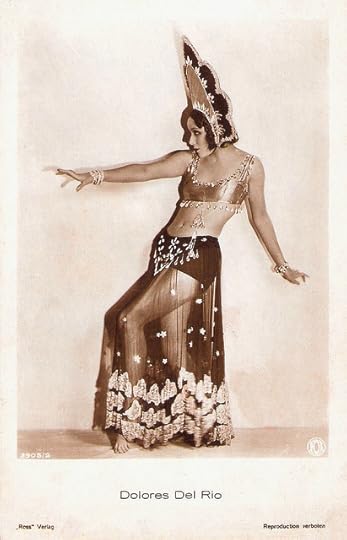
Dolores del Río. German postcard by Ross Verlag, no. 3905/2, 1928-1929. Photo: Fox.
The Attempted Suppression Of Citizen Kane
Orson Welles's growing fame drew Hollywood offers, lures that the independent-minded Welles resisted at first. RKO Radio Pictures president George Schaefer eventually offered him complete artistic control and signed Welles in a two-picture deal, although Welles had a budget limit for his projects.
In Hollywood, Welles toyed with various ideas for his first project. RKO rejected Welles's first two movie proposals, but agreed on the third offer, Citizen Kane (1941), for which Welles co-wrote, produced, directed and performed the lead role.
Co-scriptwriter Joseph Mankiewicz based the original outline on an exposé of the life of William Randolph Hearst, whom he knew socially and came to hate, having once been great friends with Hearst's mistress, Marion Davies.
However, Kane's megalomania was modelled loosely on Robert McCormick, Howard Hughes and Joseph Pulitzer as Welles wanted to create a broad, complex character, intending to show him in the same scenes from several points of view.
On Welles's instruction, John Houseman wrote the opening narration as a pastiche of The March of Time newsreels.
Autobiographical allusions to Welles were worked in, most noticeably in the treatment of Kane's childhood and particularly, regarding his guardianship.
Once the script was complete, Welles attracted cinematographer Gregg Toland, and actors from his Mercury Theatre.
After gossip columnist Hedda Hopper saw a preview screening of Citizen Kane, the attempted suppression of Citizen Kane started. Hearst's media outlets boycotted the film. They exerted enormous pressure on Hollywood, but RKO gave the film a limited release.
The film was well-received critically, and garnered nine Academy Award nominations. Welles was nominated as a producer, director, writer and actor, but won only for Best Original Screenplay, shared with Mankiewicz.
Today, the film is considered by most film critics and historians to be one of the classics in film history.
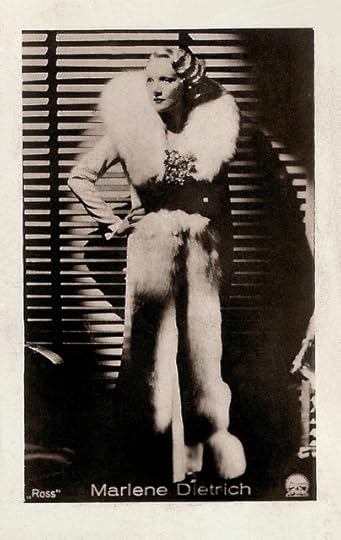
Marlene Dietrich . Small German collector's card by Ross Verlag. Photo: Paramount.
Journey Into Fear
Orson Welles's second film for RKO was The Magnificent Ambersons (1942), adapted from the Pulitzer Prize-winning novel by Booth Tarkington.
At RKO's request, Welles worked also on an adaptation of Eric Ambler's spy thriller, Marlene Dietrich (Norman Foster, 1943), co-written with Joseph Cotten. In addition to acting in the film, Welles was the producer.
Changes throughout RKO caused re-evaluations of both projects. RKO took control of The Magnificent Ambersons, and ordered to edit the film into a ‘commercial’ format. They removed fifty minutes of Welles's footage, re-shot sequences, rearranged the scene order, and added a happy ending.
It resulted in an expensive flop for RKO, although The Magnificent Ambersons received four Academy Award nominations including Best Picture and Best Supporting Actress for Agnes Moorehead.
Welles found no studios interested in him as a director after the disaster of The Magnificent Ambersons and worked on radio.
In 1943, he married Rita Hayworth. They had one child, Rebecca Welles, and divorced five years later in 1948.
In between, Welles found work as an actor in other films. He starred in the film adaptation of Jane Eyre (Robert Stevenson, 1944), trading credit as associate producer for top billing over Joan Fontaine.
He had a cameo in the wartime salute Follow the Boys (A. Edward Sutherland, 1944), in which he performed his magic act ‘sawing’ Marlene Dietrich in half.
In 1946, Sam Spiegel produced The Stranger (Orson Welles, 1946), starring Edward G. Robinson, Loretta Young and Welles. The film follows the hunt for a Nazi war criminal living under an alias in the United States. Although disputes occurred during editing between Spiegel and Welles, the film was a box office success and it helped his standing with the studios.
He then filmed The Lady from Shanghai (Orson Welles, 1947) for Columbia Pictures, in which his then-estranged second wife Rita Hayworth co-starred.
Cohn disliked Welles's rough-cut, and ordered extensive editing and re-shoots. Approximately one hour of Welles's first cut was removed, including much of a climactic confrontation scene in an amusement park funhouse. The film was considered a disaster in America at the time of release, though the closing shootout in a hall of mirrors has since become a touchstone of film noir.
Welles convinced Republic Pictures to let him direct a low-budget version of Macbeth (Orson Welles, 1948). Republic initially trumpeted the film as an important work but decided it did not care for the Scottish accents and held up general release for almost a year after early negative press reaction.
In the late 1970s, a fully restored version of Macbeth was released that followed Welles's original vision.
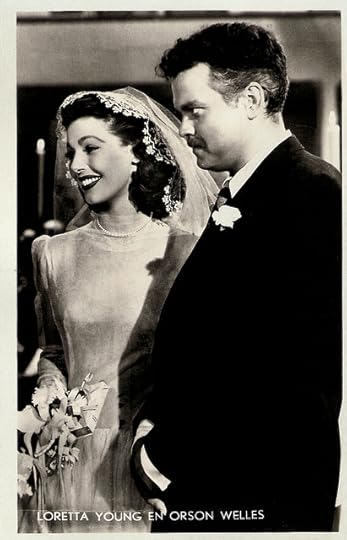
Dutch postcard by S. & v. H. A. Photo: M.P.E.A. Publicity still for The Stranger (Orson Welles, 1946) with Loretta Young.
Harry Lime
Orson Welles left Hollywood for Europe. In Italy he starred as Cagliostro in Black Magic (Gregory Ratoff, 1948) with Akim Tamiroff. His co-star impressed Welles so much that Tamiroff would appear in four of Welles's later productions.
Welles starred as Harry Lime in Carol Reed's The Third Man (1949), alongside Joseph Cotten. The film was an international smash hit.
Welles also appeared as Cesare Borgia in the Italian film Prince of Foxes (Henry King, 1949), and as the Mongol warrior Bayan in The Black Rose (Henry Hathaway, 1950), both with Tyrone Power .
Welles was channelling his money from acting jobs into a self-financed film version of Shakespeare's play Othello. From 1949 to 1951, Welles filmed Othello (1952) on location in Europe and Morocco. Suzanne Cloutier co-starred as Desdemona.
When Othello premiered at the Cannes Film Festival it won the Palme d'Or, but the film did not receive a general release in the United States until 1955. Welles's daughter, Beatrice Welles-Smith, restored Othello in 1992 for a wide re-release.
Welles played the murdered victim in Trent's Last Case (Herbert Wilcox, 1952) and the title role in the 'Lord Mountdrago' segment of Three Cases of Murder (George More O'Ferrall, 1954). Herbert Wilcox also cast Welles as the antagonist in Trouble in the Glen (1954) opposite Margaret Lockwood , and John Huston cast him as Father Mapple in Moby-Dick (1956), starring Gregory Peck.
His next turn as director was Mr. Arkadin (Orson Welles, 1955), filmed in France, Germany, Spain and Italy on a very limited budget.
Welles played a billionaire who hires a man (Robert Arden) to delve into the secrets of his past. The film co-starred Welles's third wife, Paola Mori.
Frustrated by his slow progress in the editing room, producer Louis Dolivet removed Welles from the project and finished the film without him as Confidential Report.
In 1956, Welles returned to Hollywood and guest starred on radio and television shows. His next film role was in Man in the Shadow (Jack Arnold, 1957) for Universal Pictures, starring Jeff Chandler.
Around this time period Welles began to suffer from weight problems that would eventually cause a deterioration in his health.
Welles stayed on at Universal to co-star with Charlton Heston in Touch of Evil (Orson Welles, 1958). Originally only hired as an actor, Welles was promoted to director by Universal at the insistence of Heston.
He reunited with many actors and technicians with whom he had worked in the 1940s including Joseph Cotten, Marlene Dietrich and Akim Tamiroff.
Filming proceeded smoothly, but after the end of production, the studio re-edited the film, re-shot scenes, and shot new exposition scenes to clarify the plot. In 1978, a longer preview version of the film was discovered and released.
Next, Welles filmed his adaptation of Miguel de Cervantes' novel Don Quixote in Mexico, starring Mischa Auer as Quixote and Akim Tamiroff as Sancho Panza. While filming would continue in fits and starts for several years, Welles would never complete the project.
Welles continued acting, notably in The Long, Hot Summer (Marin Ritt, 1958) with Paul Newman, and Compulsion (Richard Fleischer, 1959), but soon he returned to Europe.
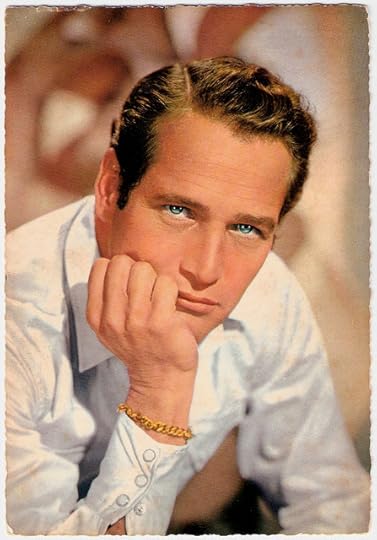
Paul Newman. German postcard by Krüger, no. 902/261.
The Trial
In Italy, Orson Welles directed his own scenes as King Saul in David e Golia/David and Goliath (Ferdinando Baldi, Richard Pottier, 1959).
In Hong Kong he co-starred with Curd Jürgens in Ferry to Hong Kong (Lewis Gilbert, 1959).
In Paris he co-starred in Crack in the Mirror (Richard Fleischer, 1960).
In Yugoslavia he starred in I tartari/The Tartars (Richard Thorpe, 1962) and Bitka na Neretvi/Battle of Neretva (Veljko Bulajić, 1969).
In 1962, Welles directed Le Procès/The Trial (Orson Welles, 1962), based on the novel by Franz Kafka and starring Anthony Perkins as Josef K, Jeanne Moreau and Romy Schneider .
The film failed at the box-office, but during the filming, he met Oja Kodar, who became his muse, star and mistress for the rest of his life.
Welles played a film director in La Ricotta (1963) — Pier Paolo Pasolini's segment of the anthology film Ro.Go.Pa.G.
He continued taking what work he could find acting, narrating or hosting other people's work, and began filming Campanadas a medianoche/Chimes at Midnight (Orson Welles, 1966). Filmed in Spain, it was a condensation of five Shakespeare plays, telling the story of Falstaff (Welles) and his relationship with Prince Hal (Keith Baxter).
Then followed Histoire immortelle/The Immortal Story (Orson Welles, 1968) with Jeanne Moreau , which had a successful run in French theatres.
He appeared as Cardinal Wolsey in A Man for All Seasons (Fred Zinnemann, 1966) for which he won considerable acclaim.
Welles began directing The Deep, based on the novel Dead Calm by Charles Williams and filmed off the shore of Yugoslavia. The cast included Jeanne Moreau , Laurence Harvey and Oja Kodar.
Personally financed by Welles and Kodar, they could not obtain the funds to complete the project, and it was abandoned a few years later after the death of Harvey. The surviving footage was eventually edited and released by the Filmmuseum München.
In 1969, Welles played a supporting role in John Huston's The Kremlin Letter.
Drawn by the numerous offers he received to work in television and films, and upset by a tabloid scandal reporting his affair with Kodar, Welles moved back to America in 1970.
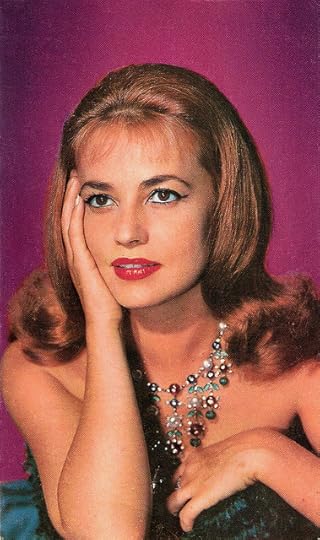
Jeanne Moreau . French postcard by E.D.U.G., no. 275. Offered by Corvisart, Epinal. Photo: Sam Lévin.
The Other Side of the Wind
In Hollywood, Orson Welles continued to self-finance his own film and television projects. While offers to act, narrate and host continued, Welles also found himself in great demand on television talk shows.
His primary focus during his final years was The Other Side of the Wind, an unfinished project that was filmed intermittently between 1970 and 1976. Written by Welles, it is the story of an aging film director (John Huston) looking for funds to complete his final film.
Financed by Iranian backers, ownership of the film fell into a legal quagmire after the Shah of Iran was deposed, and disputes still prevent its release.
Welles portrayed Louis XVIII of France in Waterloo ( Sergei Bondarchuk , 1970), and narrated the historical comedy Start the Revolution Without Me (Bud Yorkin, 1970).
He appeared in La décade prodigieuse/Ten Days' Wonder (Claude Chabrol, 1971), co-starring with Anthony Perkins.
Wikipedia : “That same year, the Academy of Motion Picture Arts and Sciences gave him an honorary award "For superlative artistry and versatility in the creation of motion pictures". Welles pretended to be out of town and sent John Huston to claim the award. Huston criticized the Academy for awarding Welles, even while they refused to give Welles any work.”
Welles played Long John Silver in Treasure Island (John Hough, 1972), an adaptation of the Robert Louis Stevenson novel.
He completed F for Fake (Orson Welles, 1973), a personal essay film about art forger Elmyr de Hory and the biographer Clifford Irving, and his documentary Filming Othello (Orson Welles, 1979).
During the 1980s, Welles worked on such film projects as The Dreamers, based on two stories by Isak Dinesen.
His last film appearance was in Henry Jaglom's Someone to Love (1987), released after his death.
Welles had three daughters: Chris Welles Feder (1938), with Virginia Nicholson; Rebecca Welles Manning (1944–2004), with Rita Hayworth; and Beatrice Welles (1955), with Paola Mori. His only known son, British director Michael Lindsay-Hogg (1940), is from Welles's affair with Irish actress Geraldine Fitzgerald, then the wife of Sir Edward Lindsay-Hogg, 4th baronet.
On 10 October 1985, Orson Welles appeared on his final interview on The Merv Griffin Show. He died several hours later of a heart attack at his home in Los Angeles.
His estranged wife Paola Mori refused to allow most of Welles's friends to attend the funeral, limiting the mourners to just nine: herself, Welles's three daughters, his old teacher Roger Hill and three of Welles's friends, as well as the doctor who had signed Welles's death certificate.
Welles's companion for the last 20 years, Oja Kodar, was not invited, nor were either of his ex-wives.
Welles's ashes were taken to Ronda, Spain, where they were buried in an old well covered by flowers, within the rural property of a long-time friend, retired bullfighter Antonio Ordóñez.
Trailer for Citizen Kane (1941). Source: Agelesstrailers (YouTube).
Trailer for Touch of Evil (1958). Source: Oldhollywoodtrailers (YouTube).
Trailer for Le Procès/The Trial (1962). Source: Alessio Franco (YouTube).
This was the eighth episode of 'Imported from the USA'. Earlier episodes were dedicated to Jayne Mansfield , Josephine Baker , Lex Barker, Anna May Wong, Carroll Baker, Farley Granger, and Louise Brooks.
Sources: (IMDb), Wikipedia, and .
American actor, director, writer and producer Orson Welles (1915-1985) worked in theatre, radio and film, both in the US and in Europe. He is remembered for his innovative work in all three media, most notably Caesar (1937), a ground-breaking Broadway adaptation of Julius Caesar and the debut of the Mercury Theatre; The War of the Worlds (1938), one of the most famous broadcasts in the history of radio; and Citizen Kane (1941), ranked as one of the all-time greatest films. His other films include The Magnificent Ambersons (1942), Touch of Evil (1958) and Le Procès/The Trial (1962).

French postcard by Editions du Globe, no. 143. Photo: Sam Lévin.
The Hearts of Age
George Orson Welles was born in Kenosha, Wisconsin, in 1915. He was the second son of Beatrice (née Ives) and Richard Hodgdon Head Welles.
In 1919, his parents separated and moved to Chicago. His father, who made a fortune as the inventor of a popular bicycle lamp, became an alcoholic and stopped working. His brother ‘Dickie’ was institutionalized at an early age because he had learning difficulties. Welles's mother, a beautiful concert pianist, had to support her son and herself.
In 1924, Beatrice died of hepatitis in a Chicago hospital, just after Welles's ninth birthday. He was taken in by Dudley Crafts Watson. At the age of ten Orson ran away from home with Watson's third daughter, Marjorie. They were found a week later, singing and dancing for money on a street corner in Milwaukee.
Welles' father died when Orson was 15. Maurice Bernstein, a physician from Chicago, became his guardian. His school teacher Roger Hill provided Welles with an ad hoc educational environment that proved invaluable to his creative experience, allowing Welles to perform and stage theatrical experiments and productions.
Welles was awarded a scholarship to Harvard University, but he chose instead to travel to Europe. In Ireland, he strode into the Gate Theatre in Dublin and claimed he was a Broadway star.
The manager of Gate, Hilton Edwards, was impressed by his brashness and an impassioned quality in his audition. Welles made his stage debut at the Gate in 1931, appearing in Jew Suss as the Duke. He acted to great acclaim, word of which reached the United States.
On returning to the United States he wrote the immensely successful Everybody's Shakespeare. In 1933, he toured in three off-Broadway productions with Katharine Cornell's company, including two roles in Romeo and Juliet. In 1934, he shot his first film, an eight-minute short titled The Hearts of Age, and he married Chicago actress Virginia Nicholson.
By 1935 Welles was supplementing his earnings in the theatre as a radio actor, working with many actors who would later form the core of his Mercury Theatre.

Gate Theatre in 2012. Cavendish Row, Parnell Square, Dublin 1, Ireland.
The Night That Panicked America
In 1936, the Federal Theatre Project (part of Roosevelt's Works Progress Administration) put unemployed theatre performers and employees to work.
Orson Welles was hired by John Houseman and assigned to direct a play for the Federal Theatre Project's Negro Theatre Unit. His production of Macbeth was set in the Haitian court of King Henri Christophe, with voodoo witch doctors for the three Weird Sisters. The play was received rapturously and later toured the nation.
At 20, Welles was hailed as a prodigy. A few minutes of Welles’ ‘Voodoo Macbeth’ was recorded on film in the documentary We Work Again (1937).
Welles rehearsed Marc Blitzstein's political operetta, The Cradle Will Rock, but because of severe federal cutbacks in the Works Progress projects, the show's premiere at the Maxine Elliott Theatre was cancelled.
In a last-minute move, Welles announced to waiting ticket-holders that the show was being transferred to the Venice, twenty blocks away. Some cast, crew and audience members walked the distance on foot. Lacking the participation of the union members, The Cradle Will Rock began with Blitzstein introducing the show and playing the piano accompaniment on stage with some cast members performing from the audience. This impromptu performance was well received and played at the Venice for two more weeks.
Welles and Houseman then formed the Mercury Theatre, of which Welles became executive producer and whose repertory company eventually included the actors Agnes Moorehead, Joseph Cotten, Dolores del Río, Everett Sloane and Erskine Sanford.
The first Mercury Theatre production was William Shakespeare's tragedy Julius Caesar, set in a contemporary frame of fascist Italy. The production was widely acclaimed.
In the second year of the Mercury Theater, Welles shifted his interests to radio. He adapted, directed and played Hamlet for CBS and Les Misérables for Mutual with great success.
CBS gave the Mercury Theatre a weekly hour-long show to broadcast radio plays based on classic literary works.
In 1938, their adaptation of The War of the Worlds by H. G. Wells brought Welles instant fame. The combination of the news bulletin form of the performance with the between-breaks dial spinning habits of listeners from the rival more popular Edgar Bergen/Charlie McCarthy program was later reported in the media to have created widespread confusion.
Wikipedia : “Panic was reportedly spread among listeners who believed the news reports of a Martian invasion. The myth of the result created by the combination was reported as fact around the world and disparagingly mentioned by Adolf Hitler in a public speech some months later. The 1975 docudrama The Night That Panicked America was based on events centering on the production of, and events that resulted from the program.”

Dolores del Río. German postcard by Ross Verlag, no. 3905/2, 1928-1929. Photo: Fox.
The Attempted Suppression Of Citizen Kane
Orson Welles's growing fame drew Hollywood offers, lures that the independent-minded Welles resisted at first. RKO Radio Pictures president George Schaefer eventually offered him complete artistic control and signed Welles in a two-picture deal, although Welles had a budget limit for his projects.
In Hollywood, Welles toyed with various ideas for his first project. RKO rejected Welles's first two movie proposals, but agreed on the third offer, Citizen Kane (1941), for which Welles co-wrote, produced, directed and performed the lead role.
Co-scriptwriter Joseph Mankiewicz based the original outline on an exposé of the life of William Randolph Hearst, whom he knew socially and came to hate, having once been great friends with Hearst's mistress, Marion Davies.
However, Kane's megalomania was modelled loosely on Robert McCormick, Howard Hughes and Joseph Pulitzer as Welles wanted to create a broad, complex character, intending to show him in the same scenes from several points of view.
On Welles's instruction, John Houseman wrote the opening narration as a pastiche of The March of Time newsreels.
Autobiographical allusions to Welles were worked in, most noticeably in the treatment of Kane's childhood and particularly, regarding his guardianship.
Once the script was complete, Welles attracted cinematographer Gregg Toland, and actors from his Mercury Theatre.
After gossip columnist Hedda Hopper saw a preview screening of Citizen Kane, the attempted suppression of Citizen Kane started. Hearst's media outlets boycotted the film. They exerted enormous pressure on Hollywood, but RKO gave the film a limited release.
The film was well-received critically, and garnered nine Academy Award nominations. Welles was nominated as a producer, director, writer and actor, but won only for Best Original Screenplay, shared with Mankiewicz.
Today, the film is considered by most film critics and historians to be one of the classics in film history.

Marlene Dietrich . Small German collector's card by Ross Verlag. Photo: Paramount.
Journey Into Fear
Orson Welles's second film for RKO was The Magnificent Ambersons (1942), adapted from the Pulitzer Prize-winning novel by Booth Tarkington.
At RKO's request, Welles worked also on an adaptation of Eric Ambler's spy thriller, Marlene Dietrich (Norman Foster, 1943), co-written with Joseph Cotten. In addition to acting in the film, Welles was the producer.
Changes throughout RKO caused re-evaluations of both projects. RKO took control of The Magnificent Ambersons, and ordered to edit the film into a ‘commercial’ format. They removed fifty minutes of Welles's footage, re-shot sequences, rearranged the scene order, and added a happy ending.
It resulted in an expensive flop for RKO, although The Magnificent Ambersons received four Academy Award nominations including Best Picture and Best Supporting Actress for Agnes Moorehead.
Welles found no studios interested in him as a director after the disaster of The Magnificent Ambersons and worked on radio.
In 1943, he married Rita Hayworth. They had one child, Rebecca Welles, and divorced five years later in 1948.
In between, Welles found work as an actor in other films. He starred in the film adaptation of Jane Eyre (Robert Stevenson, 1944), trading credit as associate producer for top billing over Joan Fontaine.
He had a cameo in the wartime salute Follow the Boys (A. Edward Sutherland, 1944), in which he performed his magic act ‘sawing’ Marlene Dietrich in half.
In 1946, Sam Spiegel produced The Stranger (Orson Welles, 1946), starring Edward G. Robinson, Loretta Young and Welles. The film follows the hunt for a Nazi war criminal living under an alias in the United States. Although disputes occurred during editing between Spiegel and Welles, the film was a box office success and it helped his standing with the studios.
He then filmed The Lady from Shanghai (Orson Welles, 1947) for Columbia Pictures, in which his then-estranged second wife Rita Hayworth co-starred.
Cohn disliked Welles's rough-cut, and ordered extensive editing and re-shoots. Approximately one hour of Welles's first cut was removed, including much of a climactic confrontation scene in an amusement park funhouse. The film was considered a disaster in America at the time of release, though the closing shootout in a hall of mirrors has since become a touchstone of film noir.
Welles convinced Republic Pictures to let him direct a low-budget version of Macbeth (Orson Welles, 1948). Republic initially trumpeted the film as an important work but decided it did not care for the Scottish accents and held up general release for almost a year after early negative press reaction.
In the late 1970s, a fully restored version of Macbeth was released that followed Welles's original vision.

Dutch postcard by S. & v. H. A. Photo: M.P.E.A. Publicity still for The Stranger (Orson Welles, 1946) with Loretta Young.
Harry Lime
Orson Welles left Hollywood for Europe. In Italy he starred as Cagliostro in Black Magic (Gregory Ratoff, 1948) with Akim Tamiroff. His co-star impressed Welles so much that Tamiroff would appear in four of Welles's later productions.
Welles starred as Harry Lime in Carol Reed's The Third Man (1949), alongside Joseph Cotten. The film was an international smash hit.
Welles also appeared as Cesare Borgia in the Italian film Prince of Foxes (Henry King, 1949), and as the Mongol warrior Bayan in The Black Rose (Henry Hathaway, 1950), both with Tyrone Power .
Welles was channelling his money from acting jobs into a self-financed film version of Shakespeare's play Othello. From 1949 to 1951, Welles filmed Othello (1952) on location in Europe and Morocco. Suzanne Cloutier co-starred as Desdemona.
When Othello premiered at the Cannes Film Festival it won the Palme d'Or, but the film did not receive a general release in the United States until 1955. Welles's daughter, Beatrice Welles-Smith, restored Othello in 1992 for a wide re-release.
Welles played the murdered victim in Trent's Last Case (Herbert Wilcox, 1952) and the title role in the 'Lord Mountdrago' segment of Three Cases of Murder (George More O'Ferrall, 1954). Herbert Wilcox also cast Welles as the antagonist in Trouble in the Glen (1954) opposite Margaret Lockwood , and John Huston cast him as Father Mapple in Moby-Dick (1956), starring Gregory Peck.
His next turn as director was Mr. Arkadin (Orson Welles, 1955), filmed in France, Germany, Spain and Italy on a very limited budget.
Welles played a billionaire who hires a man (Robert Arden) to delve into the secrets of his past. The film co-starred Welles's third wife, Paola Mori.
Frustrated by his slow progress in the editing room, producer Louis Dolivet removed Welles from the project and finished the film without him as Confidential Report.
In 1956, Welles returned to Hollywood and guest starred on radio and television shows. His next film role was in Man in the Shadow (Jack Arnold, 1957) for Universal Pictures, starring Jeff Chandler.
Around this time period Welles began to suffer from weight problems that would eventually cause a deterioration in his health.
Welles stayed on at Universal to co-star with Charlton Heston in Touch of Evil (Orson Welles, 1958). Originally only hired as an actor, Welles was promoted to director by Universal at the insistence of Heston.
He reunited with many actors and technicians with whom he had worked in the 1940s including Joseph Cotten, Marlene Dietrich and Akim Tamiroff.
Filming proceeded smoothly, but after the end of production, the studio re-edited the film, re-shot scenes, and shot new exposition scenes to clarify the plot. In 1978, a longer preview version of the film was discovered and released.
Next, Welles filmed his adaptation of Miguel de Cervantes' novel Don Quixote in Mexico, starring Mischa Auer as Quixote and Akim Tamiroff as Sancho Panza. While filming would continue in fits and starts for several years, Welles would never complete the project.
Welles continued acting, notably in The Long, Hot Summer (Marin Ritt, 1958) with Paul Newman, and Compulsion (Richard Fleischer, 1959), but soon he returned to Europe.

Paul Newman. German postcard by Krüger, no. 902/261.
The Trial
In Italy, Orson Welles directed his own scenes as King Saul in David e Golia/David and Goliath (Ferdinando Baldi, Richard Pottier, 1959).
In Hong Kong he co-starred with Curd Jürgens in Ferry to Hong Kong (Lewis Gilbert, 1959).
In Paris he co-starred in Crack in the Mirror (Richard Fleischer, 1960).
In Yugoslavia he starred in I tartari/The Tartars (Richard Thorpe, 1962) and Bitka na Neretvi/Battle of Neretva (Veljko Bulajić, 1969).
In 1962, Welles directed Le Procès/The Trial (Orson Welles, 1962), based on the novel by Franz Kafka and starring Anthony Perkins as Josef K, Jeanne Moreau and Romy Schneider .
The film failed at the box-office, but during the filming, he met Oja Kodar, who became his muse, star and mistress for the rest of his life.
Welles played a film director in La Ricotta (1963) — Pier Paolo Pasolini's segment of the anthology film Ro.Go.Pa.G.
He continued taking what work he could find acting, narrating or hosting other people's work, and began filming Campanadas a medianoche/Chimes at Midnight (Orson Welles, 1966). Filmed in Spain, it was a condensation of five Shakespeare plays, telling the story of Falstaff (Welles) and his relationship with Prince Hal (Keith Baxter).
Then followed Histoire immortelle/The Immortal Story (Orson Welles, 1968) with Jeanne Moreau , which had a successful run in French theatres.
He appeared as Cardinal Wolsey in A Man for All Seasons (Fred Zinnemann, 1966) for which he won considerable acclaim.
Welles began directing The Deep, based on the novel Dead Calm by Charles Williams and filmed off the shore of Yugoslavia. The cast included Jeanne Moreau , Laurence Harvey and Oja Kodar.
Personally financed by Welles and Kodar, they could not obtain the funds to complete the project, and it was abandoned a few years later after the death of Harvey. The surviving footage was eventually edited and released by the Filmmuseum München.
In 1969, Welles played a supporting role in John Huston's The Kremlin Letter.
Drawn by the numerous offers he received to work in television and films, and upset by a tabloid scandal reporting his affair with Kodar, Welles moved back to America in 1970.

Jeanne Moreau . French postcard by E.D.U.G., no. 275. Offered by Corvisart, Epinal. Photo: Sam Lévin.
The Other Side of the Wind
In Hollywood, Orson Welles continued to self-finance his own film and television projects. While offers to act, narrate and host continued, Welles also found himself in great demand on television talk shows.
His primary focus during his final years was The Other Side of the Wind, an unfinished project that was filmed intermittently between 1970 and 1976. Written by Welles, it is the story of an aging film director (John Huston) looking for funds to complete his final film.
Financed by Iranian backers, ownership of the film fell into a legal quagmire after the Shah of Iran was deposed, and disputes still prevent its release.
Welles portrayed Louis XVIII of France in Waterloo ( Sergei Bondarchuk , 1970), and narrated the historical comedy Start the Revolution Without Me (Bud Yorkin, 1970).
He appeared in La décade prodigieuse/Ten Days' Wonder (Claude Chabrol, 1971), co-starring with Anthony Perkins.
Wikipedia : “That same year, the Academy of Motion Picture Arts and Sciences gave him an honorary award "For superlative artistry and versatility in the creation of motion pictures". Welles pretended to be out of town and sent John Huston to claim the award. Huston criticized the Academy for awarding Welles, even while they refused to give Welles any work.”
Welles played Long John Silver in Treasure Island (John Hough, 1972), an adaptation of the Robert Louis Stevenson novel.
He completed F for Fake (Orson Welles, 1973), a personal essay film about art forger Elmyr de Hory and the biographer Clifford Irving, and his documentary Filming Othello (Orson Welles, 1979).
During the 1980s, Welles worked on such film projects as The Dreamers, based on two stories by Isak Dinesen.
His last film appearance was in Henry Jaglom's Someone to Love (1987), released after his death.
Welles had three daughters: Chris Welles Feder (1938), with Virginia Nicholson; Rebecca Welles Manning (1944–2004), with Rita Hayworth; and Beatrice Welles (1955), with Paola Mori. His only known son, British director Michael Lindsay-Hogg (1940), is from Welles's affair with Irish actress Geraldine Fitzgerald, then the wife of Sir Edward Lindsay-Hogg, 4th baronet.
On 10 October 1985, Orson Welles appeared on his final interview on The Merv Griffin Show. He died several hours later of a heart attack at his home in Los Angeles.
His estranged wife Paola Mori refused to allow most of Welles's friends to attend the funeral, limiting the mourners to just nine: herself, Welles's three daughters, his old teacher Roger Hill and three of Welles's friends, as well as the doctor who had signed Welles's death certificate.
Welles's companion for the last 20 years, Oja Kodar, was not invited, nor were either of his ex-wives.
Welles's ashes were taken to Ronda, Spain, where they were buried in an old well covered by flowers, within the rural property of a long-time friend, retired bullfighter Antonio Ordóñez.
Trailer for Citizen Kane (1941). Source: Agelesstrailers (YouTube).
Trailer for Touch of Evil (1958). Source: Oldhollywoodtrailers (YouTube).
Trailer for Le Procès/The Trial (1962). Source: Alessio Franco (YouTube).
This was the eighth episode of 'Imported from the USA'. Earlier episodes were dedicated to Jayne Mansfield , Josephine Baker , Lex Barker, Anna May Wong, Carroll Baker, Farley Granger, and Louise Brooks.
Sources: (IMDb), Wikipedia, and .
Published on October 11, 2013 23:00
October 10, 2013
Gina Relly
Gina Relly (1891-1985) was an actress of the French silent cinema. Her Hollywood adventure was not a success, but she revenged herself with the prestigious production L'empereur des pauvres/The Emperor of the poor (1921).
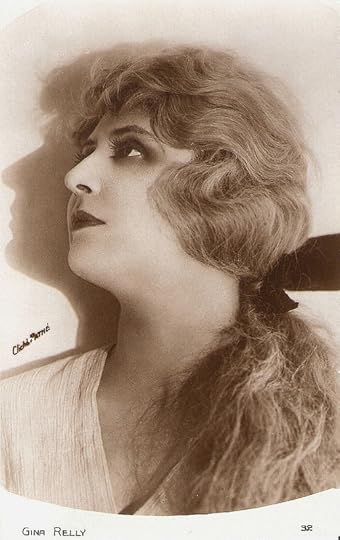
French postcard by Editions Cinémagazine, no. 32. Photo: Cliché Pathé.
The Secret Document
Gina Relly was born Anne-Marie Geneviève Boyer in Thenon, France in 1891.
During the First World War, probably in 1916, she played her first film role, a bit part in René Navarre ’s film Le Document secret/The Secret Document with Navarre himself and Denise Grey in the lead. However, IMDb mentions La dette/The Debt (Charles Burguet, 1912) as her film debut
Her film career, however, only really set off after the First World War. In the Pathé production Perdue/Lost (Georges Monca, 1919) starring René Alexandre , she was one of the leading actresses, together with Marie Fromet (Pathé’s former child actor) and Germaine Rouer .
In the same year, Relly acted in La chimère/The chimera (Lucien Lehmann, 1919), starring Edmond Van Daële as a provincial whose plan to conquer Paris with his journal fails because of schemes. He also loses his mistress but wins a nice countryside girl in the end.
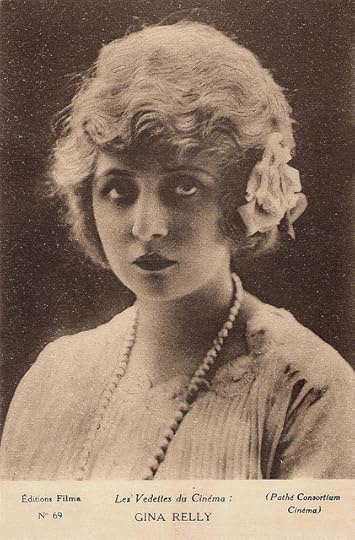
French postcard by Éditions Filma in the series Les Vedettes du Cinéma, no. 69. Photo: Pathé Consortium Cinéma.
Reckless Life In 1920 Gina Relly had the female lead as Jeanne de Rosan in La dette/The Debt by Gaston Roudès, a remake of the earlier film of 1912.
Pierre Magnier plays a count who wants to make up for his reckless life, which has caused one dead person. Chance brings together the son of his victim ( Marcel Vibert ) with the count’s own daughter (Relly).
In the same year Gina Relly also played the female lead in Nine ou la jeune fille au masque (Robert Péguy, 1920), opposite Paul Amiot and Renée Carl.
Relly then had a supporting part in the feature-length comedy Les femmes collantes (Georges Monca, Charles Prince, 1920), starring Charles Prince .
Finally also in 1920, Relly tried her luck in the US, playing the female lead in the Fox production The Face at Your Window (Richard Stanton, 1920), a patriotic, anti-bolshevist production. It didn’t materialize in a Hollywood career, so Relly returned to France.
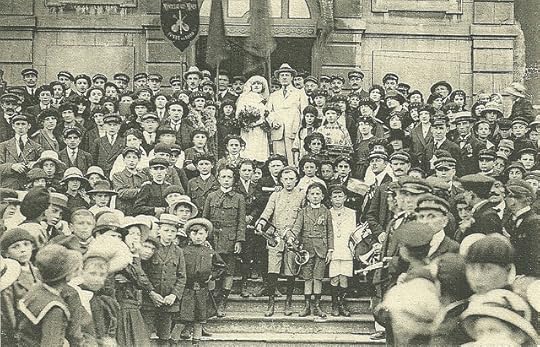
French postcard by M. Le Deley, Paris. Photo: Pathé Consortium Cinema. Gina Relly and Léon Mathot in the French silent film L'empereur des pauvres/The Emperor of the poor (René Leprince, 1921), an adaptation of the novel by Felicien Champsaur.
Prestigious Revenge
Gina Relly perfectly revenged herself for her failed American career with the prestigious production L'empereur des pauvres/The Emperor of the poor (René Leprince, 1921), based on the novel of Félicien Champsaur, and starring Léon Mathot .
The film tells about rich, young and spoiled Marc Anavan (Mathot), who decides to change his life, becomes a vagabond and starts doing good around him. He becomes the peaceful spokesperson for the disinherited, helped by the love of pure, young Sylvette (Relly).
Marc has to face revolution, anarchism and the Great War, before retaking his humanitarian mission. In the end he overcomes all the hardships on his way.
L’empereur des pauvres was released in France in 1922. Other main actors in the film were Henry Krauss, Gilbert Dalleu, Andrée Pascal and Lily Damita . In small parts appeared Charles de Rochefort (as Charlot) and Maurice Schutz (Marc’s father).
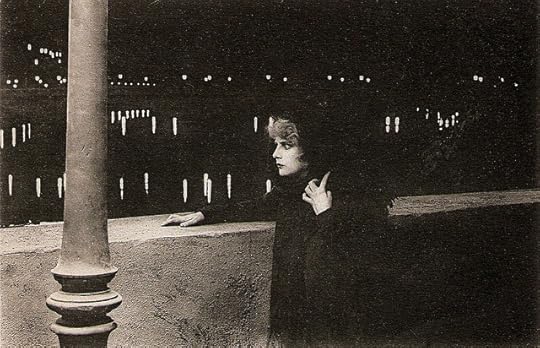
French postcard by M. Le Deley, Paris. Photo: Pathé Consortium Cinéma. Publicity still for L'empereur des pauvres/The Emperor of the poor (René Leprince, 1921).
German Films
In 1922 Relly played in two German films: Der falsche Dimitri (Hanns Steinhof, 1922) starring Alfred Abel as Iwan the Terrible and Eugen Klöpfer as Boris Gudunow, and Sünden von gestern (Robert Wüllner, 1922).
In the same year Relly had the lead in Le Sang des Finoël (Georges Monca, Rose Pansini, 1922) about the last survivor of a family of lumberjacks. Her life is a series of miseries: her adoption by a nice old gentleman fails, her aunts mistreat her, she prefers an infidel painter to a solid young coalman but the artists dumps her. In the end she dies of misery.
In 1923 Relly played with Edouard Mathé opposite the Italian strongman Mario Guaita ‘Ausonia’ in Mes p’tits, mostly shot on location for Laurea Films in Marseille and directed by Charles Keppens and Paul Barlatier.
The story is draped around Ausonia, who raises his two children on his own and is kicked out of a circus. Meanwhile he is falsely accused of murder and his rival (Mathé) manages to steal the man’s lover away. In the end Ausonia is acquitted from the accusation and reunited with his children, he hits the road again.

French postcard by M. Le Deley, Paris. Photo: Pathé Consortium Cinéma. Publicity still for L'empereur des pauvres/The Emperor of the poor (René Leprince, 1921).
Dreaming The Whole Old Testament
In 1924 Gina Relly acted in a second film with Mario Guaita ‘Ausonia’ and Edouard Mathé , La course à l’amour/The race to love (Charles Keppens, Paul Barlatier, 1924). This time it was a romantic comedy, about a girl (Relly) who has three suitors: an old marquis and two young men.
In the same year, Relly had a supporting part in Les deux gosses/The two kids (Louis Mercanton, 1924), about a rich child who is raised together with a poor son of circus acrobats.
In 1926 Relly acted in her last two films: the comedy Eh bien dansez maintenant/Well, Now Let's Dance (Emilien Champetier, 1926), with Henry Baudin and Madeleine Guitty, and the religious drama Le berceau de Dieu/The Cradle of God (Fred LeRoy Granville, 1926).
The latter film starred Léon Mathot as a man who loses faith but finds it again in Jerusalem when meeting a humble Christian girl and dreaming the whole Old Testament – in which an all star cast of the French silent cinema of the 1920s performed. Relly played Bethsabé, the woman king David (Lucien Dalsace) falls in love with.
After this, Relly completely retired from the screen. Gina Relly died in 1985 at the age of 93 in Colombes, France.
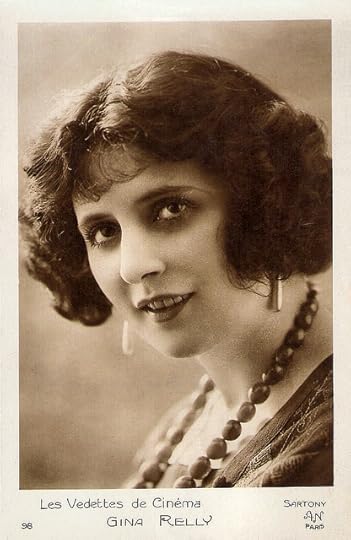
French postcard by A.N., Paris, in the series Les Vedettes de Cinéma, no. 98. Photo: Sartony.
Sources: DVDtoile (French), CinéRessources (French), Filmportal.de and .

French postcard by Editions Cinémagazine, no. 32. Photo: Cliché Pathé.
The Secret Document
Gina Relly was born Anne-Marie Geneviève Boyer in Thenon, France in 1891.
During the First World War, probably in 1916, she played her first film role, a bit part in René Navarre ’s film Le Document secret/The Secret Document with Navarre himself and Denise Grey in the lead. However, IMDb mentions La dette/The Debt (Charles Burguet, 1912) as her film debut
Her film career, however, only really set off after the First World War. In the Pathé production Perdue/Lost (Georges Monca, 1919) starring René Alexandre , she was one of the leading actresses, together with Marie Fromet (Pathé’s former child actor) and Germaine Rouer .
In the same year, Relly acted in La chimère/The chimera (Lucien Lehmann, 1919), starring Edmond Van Daële as a provincial whose plan to conquer Paris with his journal fails because of schemes. He also loses his mistress but wins a nice countryside girl in the end.

French postcard by Éditions Filma in the series Les Vedettes du Cinéma, no. 69. Photo: Pathé Consortium Cinéma.
Reckless Life In 1920 Gina Relly had the female lead as Jeanne de Rosan in La dette/The Debt by Gaston Roudès, a remake of the earlier film of 1912.
Pierre Magnier plays a count who wants to make up for his reckless life, which has caused one dead person. Chance brings together the son of his victim ( Marcel Vibert ) with the count’s own daughter (Relly).
In the same year Gina Relly also played the female lead in Nine ou la jeune fille au masque (Robert Péguy, 1920), opposite Paul Amiot and Renée Carl.
Relly then had a supporting part in the feature-length comedy Les femmes collantes (Georges Monca, Charles Prince, 1920), starring Charles Prince .
Finally also in 1920, Relly tried her luck in the US, playing the female lead in the Fox production The Face at Your Window (Richard Stanton, 1920), a patriotic, anti-bolshevist production. It didn’t materialize in a Hollywood career, so Relly returned to France.

French postcard by M. Le Deley, Paris. Photo: Pathé Consortium Cinema. Gina Relly and Léon Mathot in the French silent film L'empereur des pauvres/The Emperor of the poor (René Leprince, 1921), an adaptation of the novel by Felicien Champsaur.
Prestigious Revenge
Gina Relly perfectly revenged herself for her failed American career with the prestigious production L'empereur des pauvres/The Emperor of the poor (René Leprince, 1921), based on the novel of Félicien Champsaur, and starring Léon Mathot .
The film tells about rich, young and spoiled Marc Anavan (Mathot), who decides to change his life, becomes a vagabond and starts doing good around him. He becomes the peaceful spokesperson for the disinherited, helped by the love of pure, young Sylvette (Relly).
Marc has to face revolution, anarchism and the Great War, before retaking his humanitarian mission. In the end he overcomes all the hardships on his way.
L’empereur des pauvres was released in France in 1922. Other main actors in the film were Henry Krauss, Gilbert Dalleu, Andrée Pascal and Lily Damita . In small parts appeared Charles de Rochefort (as Charlot) and Maurice Schutz (Marc’s father).

French postcard by M. Le Deley, Paris. Photo: Pathé Consortium Cinéma. Publicity still for L'empereur des pauvres/The Emperor of the poor (René Leprince, 1921).
German Films
In 1922 Relly played in two German films: Der falsche Dimitri (Hanns Steinhof, 1922) starring Alfred Abel as Iwan the Terrible and Eugen Klöpfer as Boris Gudunow, and Sünden von gestern (Robert Wüllner, 1922).
In the same year Relly had the lead in Le Sang des Finoël (Georges Monca, Rose Pansini, 1922) about the last survivor of a family of lumberjacks. Her life is a series of miseries: her adoption by a nice old gentleman fails, her aunts mistreat her, she prefers an infidel painter to a solid young coalman but the artists dumps her. In the end she dies of misery.
In 1923 Relly played with Edouard Mathé opposite the Italian strongman Mario Guaita ‘Ausonia’ in Mes p’tits, mostly shot on location for Laurea Films in Marseille and directed by Charles Keppens and Paul Barlatier.
The story is draped around Ausonia, who raises his two children on his own and is kicked out of a circus. Meanwhile he is falsely accused of murder and his rival (Mathé) manages to steal the man’s lover away. In the end Ausonia is acquitted from the accusation and reunited with his children, he hits the road again.

French postcard by M. Le Deley, Paris. Photo: Pathé Consortium Cinéma. Publicity still for L'empereur des pauvres/The Emperor of the poor (René Leprince, 1921).
Dreaming The Whole Old Testament
In 1924 Gina Relly acted in a second film with Mario Guaita ‘Ausonia’ and Edouard Mathé , La course à l’amour/The race to love (Charles Keppens, Paul Barlatier, 1924). This time it was a romantic comedy, about a girl (Relly) who has three suitors: an old marquis and two young men.
In the same year, Relly had a supporting part in Les deux gosses/The two kids (Louis Mercanton, 1924), about a rich child who is raised together with a poor son of circus acrobats.
In 1926 Relly acted in her last two films: the comedy Eh bien dansez maintenant/Well, Now Let's Dance (Emilien Champetier, 1926), with Henry Baudin and Madeleine Guitty, and the religious drama Le berceau de Dieu/The Cradle of God (Fred LeRoy Granville, 1926).
The latter film starred Léon Mathot as a man who loses faith but finds it again in Jerusalem when meeting a humble Christian girl and dreaming the whole Old Testament – in which an all star cast of the French silent cinema of the 1920s performed. Relly played Bethsabé, the woman king David (Lucien Dalsace) falls in love with.
After this, Relly completely retired from the screen. Gina Relly died in 1985 at the age of 93 in Colombes, France.

French postcard by A.N., Paris, in the series Les Vedettes de Cinéma, no. 98. Photo: Sartony.
Sources: DVDtoile (French), CinéRessources (French), Filmportal.de and .
Published on October 10, 2013 23:00
October 9, 2013
Gladys Cooper
British stage and film actress Dame Gladys Cooper (1888-1971) started as a chorus girl and a photographic model. During WWI she became a pin-up fad for the British military. After some 'stiff' performances in her early career, she became a respected stage and film actress in later life. In her 66-year career, she was nominated three times for an Oscar and she won a Golden Globe.
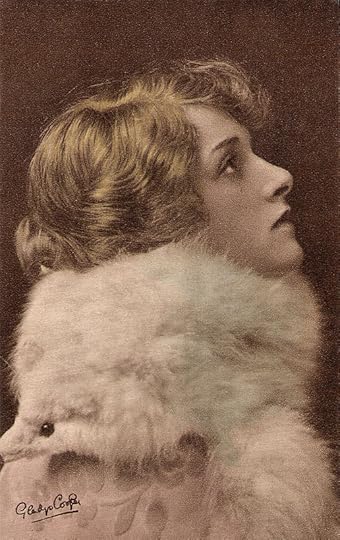
British postcard by Philco, Series no. 1046/4. Photo: Dover St. Studios.
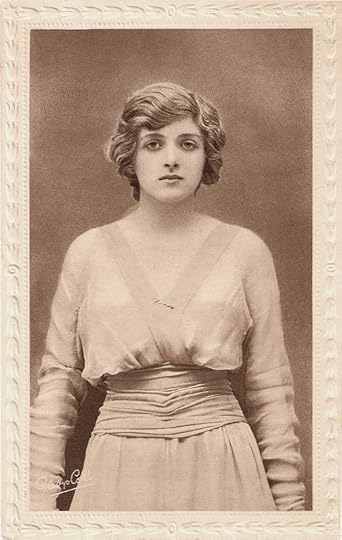
British postcard by Philco, Series no. 1134/1. Photo: Wrather & Buys.
Gaiety Girl
Gladys Constance Cooper was born in London, England, in 1888. She was one of the three daughters of journalist Charles William Frederick Cooper by his marriage to Mabel Barnett.
In 1905 she had her stage debut touring with Seymour Hicks in his musical Bluebell in Fairyland.
In 1907 she took a departure from the legitimate stage to become a member of Frank Curzon's famous Gaiety Girls chorus entertainments at The Gaiety theatre in London, appearing in the successful 1908 musical Havana.
In 1911 she had her breakthrough in Oscar Wilde's The Importance of Being Earnest.
Soon the young beauty became a popular photographic model. During World War I her popularity grew into something of pin-up fad for the British military.
From the craze for post cards with photos of actors - that ensued between about 1890 and 1914 - Cooper became a popular subject of maidenly beauty with scenes as Juliet and many others.
In 1917 she became co-manager, with Frank Curzon, of the London Playhouse Theatre, and ran it on her own between 1927 and 1933.
At the start of her career she was criticized for her too 'wooden' performance, and she only found major critical success in 1922 with The Second Mrs. Thacqueray.
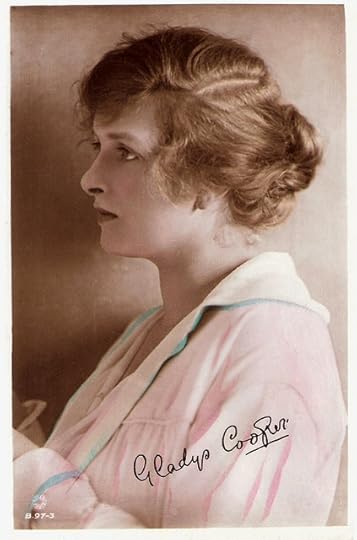
British postcard by Rotary Photo, London.
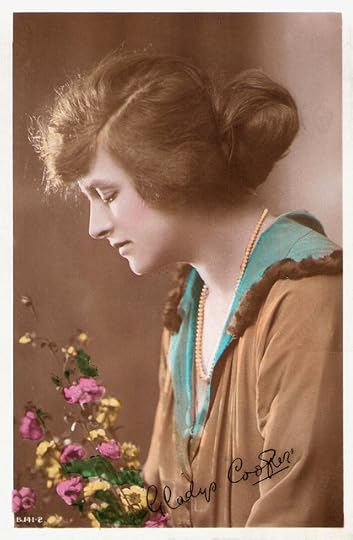
British postcard by Rotary Photo, London.
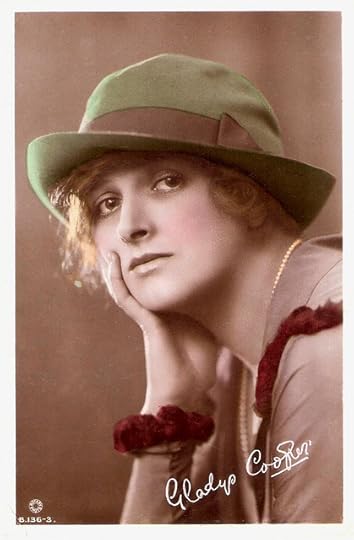
British postcard by Rotary Photo, London, no. B 136-3 (handpainted real photograph). Sent by mail in Great-Britain in 1918.
Hollywood
In 1913 Gladys Cooper started in film. Her debut was in The Eleventh Commandment (1913).
Several silent British films followed such as Danny Donovan, the Gentleman Cracksman (Walter Waller, 1914) with Thomas Meighan, The Sorrows of Satan (Alexander Butler, 1917) and The Bohemian Girl (Harley Knoles, 1922) with Ivor Novello .
In 1934 Cooper made her first sound picture in the UK, The Iron Duke (Victor Saville, 1934) starring George Arliss .
She came to Broadway with The Shining Hour which she had been doing in London. According to William McPeak at IMDb , "she and it were a success, and she followed it with several plays through 1938, including MacBeth. About this time Hollywood scouts caught wind of her, and she began her 30 odd years in American film."
In particular in the 1940s she played memorably in a variety of character roles and was most frequently cast as a disapproving, aristocratic society woman.
Among her best film roles were as Laurence Olivier 's gregarious sister in Rebecca (Alfred Hitchcock, 1940), as Bette Davis's domineering mother in Now, Voyager (Irving Rapper, 1942), and a skeptical nun in The Song of Bernadette (Henry King, 1943).
Her last major film was My Fair Lady (George Cukor, 1964) as Henry Higgins' ( Rex Harrison ) mother.
For Now, Voyager, The Song of Bernadette and My Fair Lady, Cooper got Academy Award Nominations.
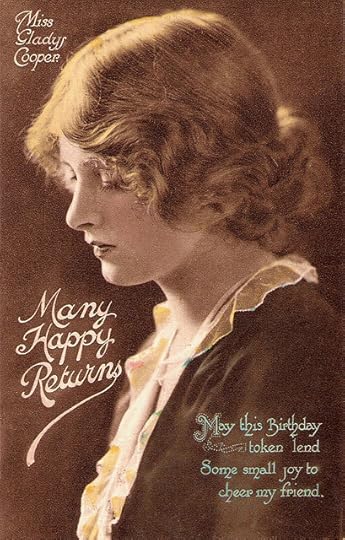
British hand-painted postcard, Series W878/2. Sent by mail in 1919. Photo: Claude Harris Ltd.
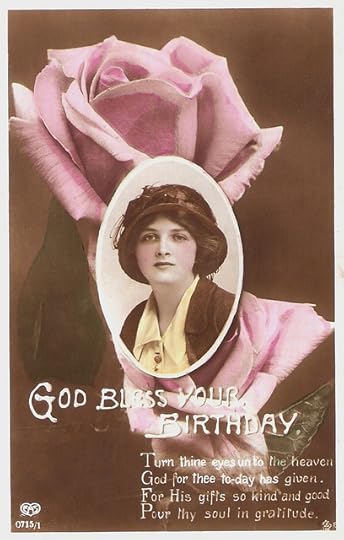
British hand-painted postcard by E.A. Schwerdtfeger & Co. (EAS), London/Berlin, no. 0715/1. Sent by mail in 1914.

British hand-painted postcard by F. W. Woolworth & Co.. Photo: Claude Harris Ltd.
Golden Globe
Gladys Cooper's last major success on the stage was in the role of Mrs. St. Maugham in Enid Bagnold's The Chalk Garden, a role she had created in 1955 in London and in 1956 on Broadway.
Through the 1950s and into the 1960s she did only a few films but she was an especially familiar face on American TV.
Her role as Margaret St. Clair in The Rogues with David Niven and Charles Boyer , got her a Golden Globe in 1962.
She also appeared in three episodes of The Twilight Zone.
In 1967, at nearly 80 years of age, she was made a Dame Commander of the Order of the British Empire (DBE).
Cooper continued to act both in film and on the stage until her death.

British postcard by Rotary Photo, no. 5.63-2.
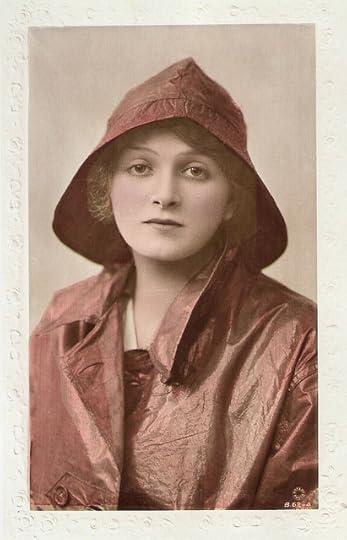
British hand-painted postcard by Rotary Photo, London, no. A.556-6. Sent by mail in 1915. Photo: Horace W. Nicholls.

British postcard by Rotary Photo, no. 5.27-3. Photo: Lallie Charles.
Permanent Resident Alien
Gladys Cooper was married three times; to capt. Herbert Buckmaster (two children, incl. actress Joan Buckmaster, who married actor Robert Morley); to Sir Neville Pearson (one daughter, costume designer Sally Pearson, married to actor Robert Hardy), 1961-1986; and to actor Philip Merivale.
Her stepson from her last marriage was actor John Merivale.
She lived for many years in Santa Monica, California, as a permanent resident alien with her third husband, until his death in 1946 from a heart ailment.
She herself eventually returned to the United Kingdom for her final years.
At the age of 82, Gladys Cooper died of a stroke, in Henley-on-Thames, in 1971.
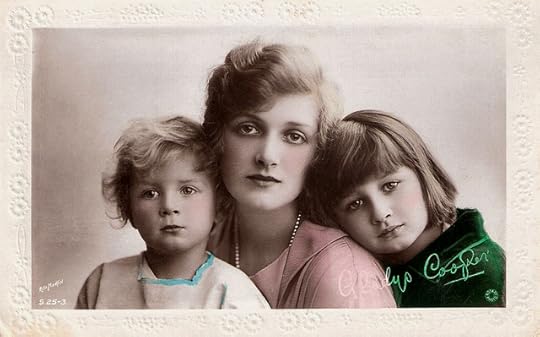
Gladys Cooper with her two eldest children. British hand-painted postcard by Rotary, no. S 25-3. Photo: Rita Martin.

British hand-painted postcard by Rotary Photo, London, no. S. 27-4. Photo: Lallie Charles.
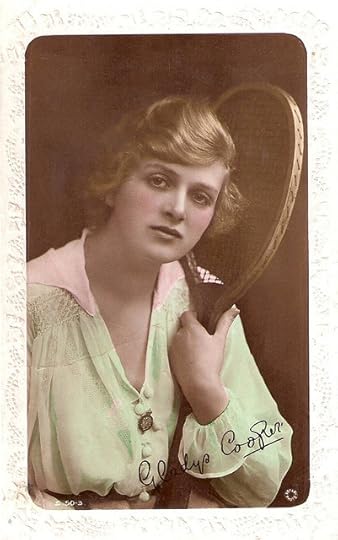
British hand-painted postcard by Rotary Photo, London, no. S. 50.3. Sent by mail in 1919.
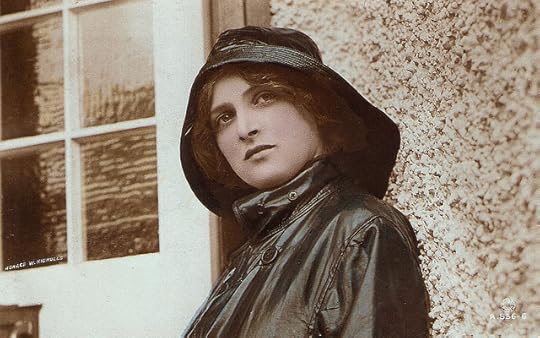
British hand-painted postcard by Rotary Photo, London, no. A.556-6. Sent by mail in 1915. Photo: Horace W. Nicholls.
Sources: (IMDb), Wikipedia, and .

British postcard by Philco, Series no. 1046/4. Photo: Dover St. Studios.

British postcard by Philco, Series no. 1134/1. Photo: Wrather & Buys.
Gaiety Girl
Gladys Constance Cooper was born in London, England, in 1888. She was one of the three daughters of journalist Charles William Frederick Cooper by his marriage to Mabel Barnett.
In 1905 she had her stage debut touring with Seymour Hicks in his musical Bluebell in Fairyland.
In 1907 she took a departure from the legitimate stage to become a member of Frank Curzon's famous Gaiety Girls chorus entertainments at The Gaiety theatre in London, appearing in the successful 1908 musical Havana.
In 1911 she had her breakthrough in Oscar Wilde's The Importance of Being Earnest.
Soon the young beauty became a popular photographic model. During World War I her popularity grew into something of pin-up fad for the British military.
From the craze for post cards with photos of actors - that ensued between about 1890 and 1914 - Cooper became a popular subject of maidenly beauty with scenes as Juliet and many others.
In 1917 she became co-manager, with Frank Curzon, of the London Playhouse Theatre, and ran it on her own between 1927 and 1933.
At the start of her career she was criticized for her too 'wooden' performance, and she only found major critical success in 1922 with The Second Mrs. Thacqueray.

British postcard by Rotary Photo, London.

British postcard by Rotary Photo, London.

British postcard by Rotary Photo, London, no. B 136-3 (handpainted real photograph). Sent by mail in Great-Britain in 1918.
Hollywood
In 1913 Gladys Cooper started in film. Her debut was in The Eleventh Commandment (1913).
Several silent British films followed such as Danny Donovan, the Gentleman Cracksman (Walter Waller, 1914) with Thomas Meighan, The Sorrows of Satan (Alexander Butler, 1917) and The Bohemian Girl (Harley Knoles, 1922) with Ivor Novello .
In 1934 Cooper made her first sound picture in the UK, The Iron Duke (Victor Saville, 1934) starring George Arliss .
She came to Broadway with The Shining Hour which she had been doing in London. According to William McPeak at IMDb , "she and it were a success, and she followed it with several plays through 1938, including MacBeth. About this time Hollywood scouts caught wind of her, and she began her 30 odd years in American film."
In particular in the 1940s she played memorably in a variety of character roles and was most frequently cast as a disapproving, aristocratic society woman.
Among her best film roles were as Laurence Olivier 's gregarious sister in Rebecca (Alfred Hitchcock, 1940), as Bette Davis's domineering mother in Now, Voyager (Irving Rapper, 1942), and a skeptical nun in The Song of Bernadette (Henry King, 1943).
Her last major film was My Fair Lady (George Cukor, 1964) as Henry Higgins' ( Rex Harrison ) mother.
For Now, Voyager, The Song of Bernadette and My Fair Lady, Cooper got Academy Award Nominations.

British hand-painted postcard, Series W878/2. Sent by mail in 1919. Photo: Claude Harris Ltd.

British hand-painted postcard by E.A. Schwerdtfeger & Co. (EAS), London/Berlin, no. 0715/1. Sent by mail in 1914.

British hand-painted postcard by F. W. Woolworth & Co.. Photo: Claude Harris Ltd.
Golden Globe
Gladys Cooper's last major success on the stage was in the role of Mrs. St. Maugham in Enid Bagnold's The Chalk Garden, a role she had created in 1955 in London and in 1956 on Broadway.
Through the 1950s and into the 1960s she did only a few films but she was an especially familiar face on American TV.
Her role as Margaret St. Clair in The Rogues with David Niven and Charles Boyer , got her a Golden Globe in 1962.
She also appeared in three episodes of The Twilight Zone.
In 1967, at nearly 80 years of age, she was made a Dame Commander of the Order of the British Empire (DBE).
Cooper continued to act both in film and on the stage until her death.

British postcard by Rotary Photo, no. 5.63-2.

British hand-painted postcard by Rotary Photo, London, no. A.556-6. Sent by mail in 1915. Photo: Horace W. Nicholls.

British postcard by Rotary Photo, no. 5.27-3. Photo: Lallie Charles.
Permanent Resident Alien
Gladys Cooper was married three times; to capt. Herbert Buckmaster (two children, incl. actress Joan Buckmaster, who married actor Robert Morley); to Sir Neville Pearson (one daughter, costume designer Sally Pearson, married to actor Robert Hardy), 1961-1986; and to actor Philip Merivale.
Her stepson from her last marriage was actor John Merivale.
She lived for many years in Santa Monica, California, as a permanent resident alien with her third husband, until his death in 1946 from a heart ailment.
She herself eventually returned to the United Kingdom for her final years.
At the age of 82, Gladys Cooper died of a stroke, in Henley-on-Thames, in 1971.

Gladys Cooper with her two eldest children. British hand-painted postcard by Rotary, no. S 25-3. Photo: Rita Martin.

British hand-painted postcard by Rotary Photo, London, no. S. 27-4. Photo: Lallie Charles.

British hand-painted postcard by Rotary Photo, London, no. S. 50.3. Sent by mail in 1919.

British hand-painted postcard by Rotary Photo, London, no. A.556-6. Sent by mail in 1915. Photo: Horace W. Nicholls.
Sources: (IMDb), Wikipedia, and .
Published on October 09, 2013 23:00
October 8, 2013
Ernst Hofmann
German actor Ernst Hofmann (1890-1944) was one of the most attractive actors of the German silent cinema in the 1910s. He was the producer and star of Der Knabe in Blau/Emerald of Death (1918), the first film by legendary director Friedrich Wilhelm Murnau.
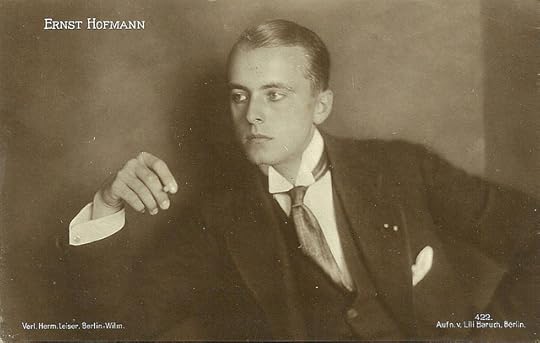
German postcard by Verleih Hermann Leiser, Berlin, no. 422. Photo: Lili Baruch, Berlin.
First Major Success
Ernst Hofmann was born as Ernst Carl Heinrich Hofmann von Schönholtz in Breslau, Germany (now Wrocław, Polen) in 1890. In 1910-1911 he studied art history, and Germanistik und Neue Sprachen (Germanistics and new languages) at the Universität Berlin (University of Berlin). At the same time, he took acting classes at the drama school of the Deutschen Theater (German theater).
Hofmann made his stage debut in 1911 and performed at the Kleinen Theater (Little Theater), the Kammerspielen (Chamber Theatre) and at the Kleinen Schauspielhaus (Little Theater). As Moritz Stiefel in the play Frühlings Erwachen (Spring Awakening), he celebrated his first major success.
At the Deutsches Theater he shared the stage with Conrad Veidt and the later director Friedrich Wilhelm Murnau.
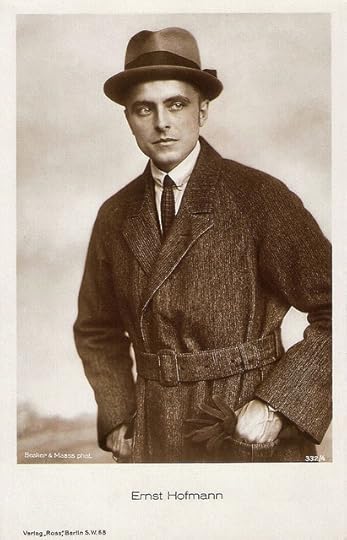
German postcard by Ross Verlag, Berlin, no. 332/4, 1916-1921. Photo: Becker & Maass phot.
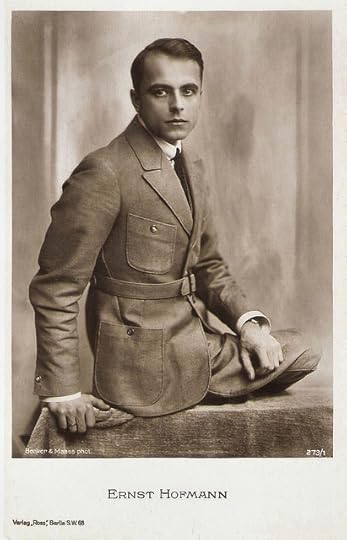
German postcard by Ross Verlag, Berlin, no. 273/1, 1919-1924. Photo: Becker & Maass.
Dreamy Young Boy
Ernst Hofmann's film debut was as the dreamy young boy in Die Insel der Seligen/Island of the Blessed (Max Reinhardt, 1913).
Then he appeared opposite the greatest German film stars of this period, Henny Porten , in the film Komtesse Ursel/Countess Ursel (Curt A. Stark, 1913), and Asta Nielsen in Das Feuer/The Fire (Urban Gad, 1914).
From 1914 on he served for two years in the First World War as a reserve officer with the Field Artillery.
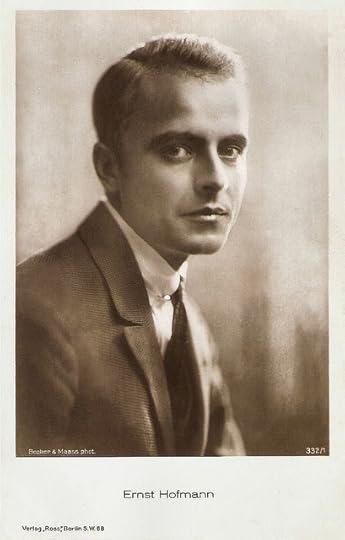
German postcard by Ross Verlag, Berlin, no. 332/1, 1919-1924. Photo: Becker & Maass.
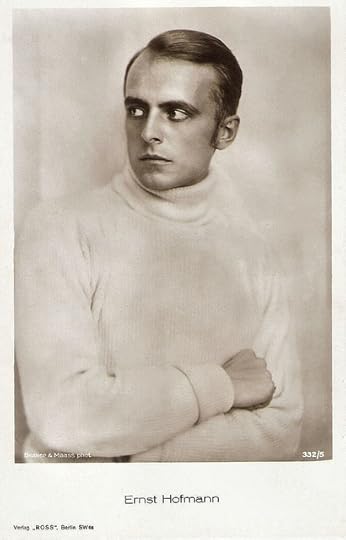
German postcard by Ross Verlag, Berlin, no. 332/5, 1919-1924. Photo: Becker & Maass.
A Women's Idol
In 1916 Ernst Hoffman returned before the cameras and enjoyed several years of considerable popularity as a women's idol. New partners were such stars as Pola Negri in Rosen, die der Sturm entblättert/Roses Stripped by the Storm (Kurt Matull, 1917) and Die toten Augen/The Dead Eyes (Otto Jäger, 1917).
In 1919 he produced Friedrich Wilhelm Murnau's first film Der Knabe in Blau/Emerald of Death (1919) and he also played the lead. F.W. Murnau once stated that he didn't know if this lost film was released or not.
Box-office hits were Satanas (Friedrich Wilhelm Murnau, 1919) with Fritz Kortner , and the serial Herrin der Welt/Queen of the World (Joe May, 1920) starring Mia May . Recently a brief fragment of Satanas has been found again.
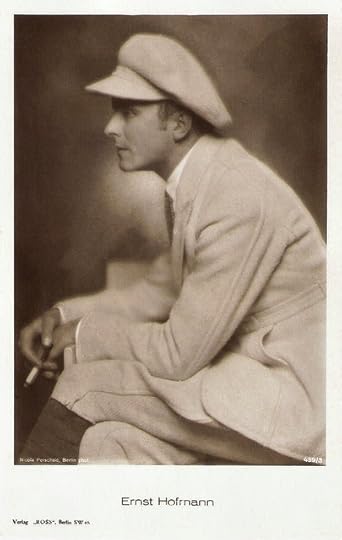
German postcard by Ross Verlag, Berlin, no. 439/3, 1919-1924. Photo: Nicola Perscheid, Berlin.
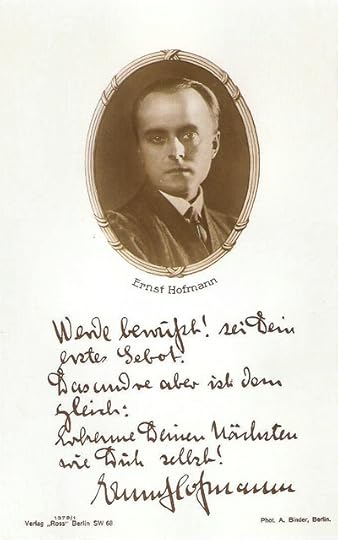
German postcard by Ross Verlag, Berlin, no. 1379/1, 1927-1928. Photo: A. Binder, Berlin. Ross produced several card with these small 'framed' oval photos and autographed messages from the actor, usually related to art, or some witticism.
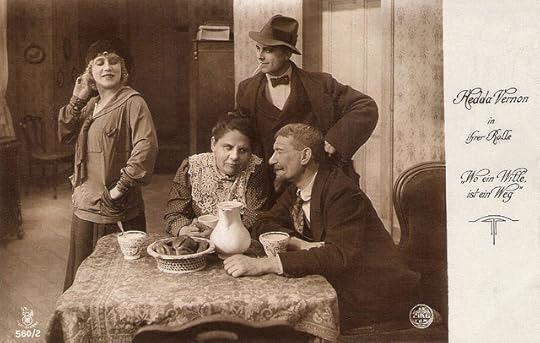
German postcard in the Film Sterne Series by Rotophot, no. 560/2. Photo: Eiko Film. Publicity still for Wo ein Wille, ist ein Weg (Hubert Moest, 1918) with Hedda Vernon and right, back, Ernst Hofmann.
Playing With Fire
Ernst Hofmann became a very busy actor in the 1920s and he took part in many well-known productions.
To his best-known films of this decade belong the sci-fi morality tale Algol (Hans Werckmeister, 1920) with Emil Jannings , Marie Antoinette - Das Leben einer Königin/Marie Antoinette - The Life of a Queen (Rudolf Meinert, 1922) starring diva Diana Karenne , Lydia Sanin ( Friedrich Zelnik , 1922) starring Lya Mara , Die keusche Susanne/The Innocent Susanne (Richard Eichberg, 1926) with Lilian Harvey , and Moral (Willi Wolff, 1928).
When the sound film arrived he finished his film career. He only appeared again in the films Gefahren der Liebe/A Woman Branded (Eugen Thiele, 1931) and Spiel mit dem Feuer/Playing with Fire ( Ralph Arthur Roberts , 1934) starring Paul Hörbiger .
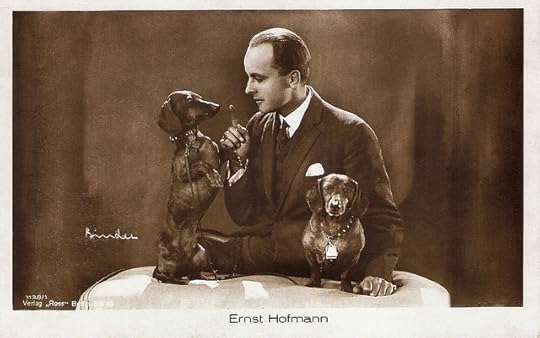
German postcard by Ross Verlag, Berlin, no. 1138/1, 1927-1928. Photo: Alex Binder, Berlin.
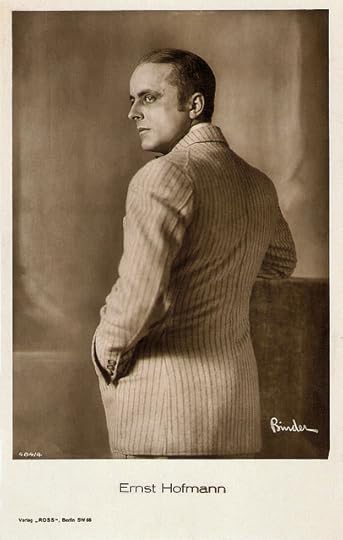
German postcard by Ross Verlag, Berlin, no. 484/4, 1919-1924. Photo: Alex Binder, Berlin.

German postcard by Ross Verlag, no. 582/1, 1919-1924. Photo: Alex Binder, Berlin.
Light Novels and Crime Stories Also on the stage, Ernst Hofmann was seen only rarely.
Under his real name Ernst Hofmann von Schönholtz, he published several light novels and crime stories. He also provided articles for newspapers such as Der Tag (The Day).
Ernst Hofmann died in 1944 in Potsdam, during the battle for Berlin. (According to IMDb and Wikipedia he died in 1945). His wife, Hedda was also an actress.

German postcard by Ross Verlag, no. 1756/3, 1927-1928. Photo: Alex Binder, Berlin.
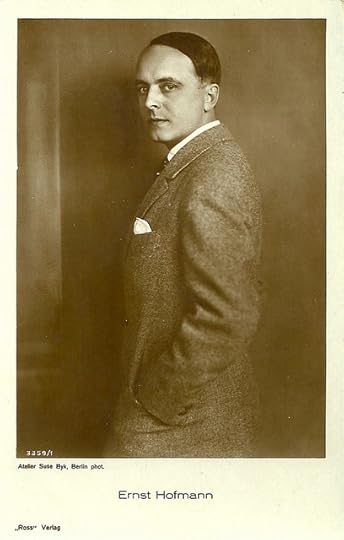
German postcard by Ross Verlag, no. 3359/1, 1928-1929. Photo: Atelier Suse Byk, Berlin.
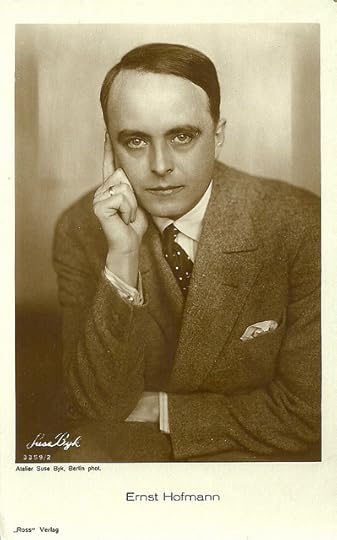
German postcard by Ross Verlag, no. 3359/2, 1928-1929. Photo: Atelier Suse Byk, Berlin.
Sources: Thomas Staedeli (Cyranos), Filmportal.de, Wikipedia (German) and .

German postcard by Verleih Hermann Leiser, Berlin, no. 422. Photo: Lili Baruch, Berlin.
First Major Success
Ernst Hofmann was born as Ernst Carl Heinrich Hofmann von Schönholtz in Breslau, Germany (now Wrocław, Polen) in 1890. In 1910-1911 he studied art history, and Germanistik und Neue Sprachen (Germanistics and new languages) at the Universität Berlin (University of Berlin). At the same time, he took acting classes at the drama school of the Deutschen Theater (German theater).
Hofmann made his stage debut in 1911 and performed at the Kleinen Theater (Little Theater), the Kammerspielen (Chamber Theatre) and at the Kleinen Schauspielhaus (Little Theater). As Moritz Stiefel in the play Frühlings Erwachen (Spring Awakening), he celebrated his first major success.
At the Deutsches Theater he shared the stage with Conrad Veidt and the later director Friedrich Wilhelm Murnau.

German postcard by Ross Verlag, Berlin, no. 332/4, 1916-1921. Photo: Becker & Maass phot.

German postcard by Ross Verlag, Berlin, no. 273/1, 1919-1924. Photo: Becker & Maass.
Dreamy Young Boy
Ernst Hofmann's film debut was as the dreamy young boy in Die Insel der Seligen/Island of the Blessed (Max Reinhardt, 1913).
Then he appeared opposite the greatest German film stars of this period, Henny Porten , in the film Komtesse Ursel/Countess Ursel (Curt A. Stark, 1913), and Asta Nielsen in Das Feuer/The Fire (Urban Gad, 1914).
From 1914 on he served for two years in the First World War as a reserve officer with the Field Artillery.

German postcard by Ross Verlag, Berlin, no. 332/1, 1919-1924. Photo: Becker & Maass.

German postcard by Ross Verlag, Berlin, no. 332/5, 1919-1924. Photo: Becker & Maass.
A Women's Idol
In 1916 Ernst Hoffman returned before the cameras and enjoyed several years of considerable popularity as a women's idol. New partners were such stars as Pola Negri in Rosen, die der Sturm entblättert/Roses Stripped by the Storm (Kurt Matull, 1917) and Die toten Augen/The Dead Eyes (Otto Jäger, 1917).
In 1919 he produced Friedrich Wilhelm Murnau's first film Der Knabe in Blau/Emerald of Death (1919) and he also played the lead. F.W. Murnau once stated that he didn't know if this lost film was released or not.
Box-office hits were Satanas (Friedrich Wilhelm Murnau, 1919) with Fritz Kortner , and the serial Herrin der Welt/Queen of the World (Joe May, 1920) starring Mia May . Recently a brief fragment of Satanas has been found again.

German postcard by Ross Verlag, Berlin, no. 439/3, 1919-1924. Photo: Nicola Perscheid, Berlin.

German postcard by Ross Verlag, Berlin, no. 1379/1, 1927-1928. Photo: A. Binder, Berlin. Ross produced several card with these small 'framed' oval photos and autographed messages from the actor, usually related to art, or some witticism.

German postcard in the Film Sterne Series by Rotophot, no. 560/2. Photo: Eiko Film. Publicity still for Wo ein Wille, ist ein Weg (Hubert Moest, 1918) with Hedda Vernon and right, back, Ernst Hofmann.
Playing With Fire
Ernst Hofmann became a very busy actor in the 1920s and he took part in many well-known productions.
To his best-known films of this decade belong the sci-fi morality tale Algol (Hans Werckmeister, 1920) with Emil Jannings , Marie Antoinette - Das Leben einer Königin/Marie Antoinette - The Life of a Queen (Rudolf Meinert, 1922) starring diva Diana Karenne , Lydia Sanin ( Friedrich Zelnik , 1922) starring Lya Mara , Die keusche Susanne/The Innocent Susanne (Richard Eichberg, 1926) with Lilian Harvey , and Moral (Willi Wolff, 1928).
When the sound film arrived he finished his film career. He only appeared again in the films Gefahren der Liebe/A Woman Branded (Eugen Thiele, 1931) and Spiel mit dem Feuer/Playing with Fire ( Ralph Arthur Roberts , 1934) starring Paul Hörbiger .

German postcard by Ross Verlag, Berlin, no. 1138/1, 1927-1928. Photo: Alex Binder, Berlin.

German postcard by Ross Verlag, Berlin, no. 484/4, 1919-1924. Photo: Alex Binder, Berlin.

German postcard by Ross Verlag, no. 582/1, 1919-1924. Photo: Alex Binder, Berlin.
Light Novels and Crime Stories Also on the stage, Ernst Hofmann was seen only rarely.
Under his real name Ernst Hofmann von Schönholtz, he published several light novels and crime stories. He also provided articles for newspapers such as Der Tag (The Day).
Ernst Hofmann died in 1944 in Potsdam, during the battle for Berlin. (According to IMDb and Wikipedia he died in 1945). His wife, Hedda was also an actress.

German postcard by Ross Verlag, no. 1756/3, 1927-1928. Photo: Alex Binder, Berlin.

German postcard by Ross Verlag, no. 3359/1, 1928-1929. Photo: Atelier Suse Byk, Berlin.

German postcard by Ross Verlag, no. 3359/2, 1928-1929. Photo: Atelier Suse Byk, Berlin.
Sources: Thomas Staedeli (Cyranos), Filmportal.de, Wikipedia (German) and .
Published on October 08, 2013 23:00
October 7, 2013
Vera Karalli
Vera Karalli (1889-1972) was one of Russia's first film stars. She was an actress in the films of pioneer film maker Yevgeni Bauer, and she was also a ballet dancer with the Ballets Russes.
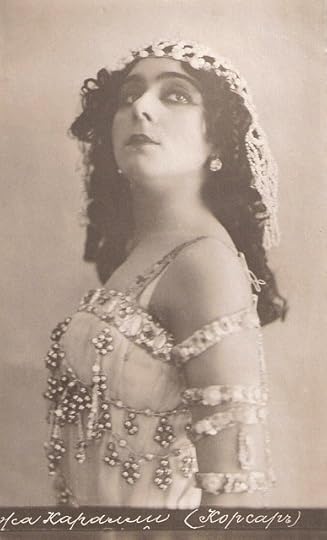
Vintage Russian postcard.
Ballerina
Vera Alexeyevna Karalli (Russian: Вера Алексеевна Каралли) was born in Moscow, in 1889. After the Moscow Theater School, Vera Karalli performed with Sergei Diaghilev's Ballets Russes in 1909. At the Bolshoi Theatre she was promoted soloist after two years and ballerina in 1915.
From 1914 to 1919, she also had a short but intense (16 films) career in the Russian cinema. Her film debut was the drama Ty pomnish' li?/Do You Remember? (Pyotr Chardynin, 1914) opposite the successful actor Ivan Mozzhukhin . The next year she starred in Voyna i mir/War and Peace (Vladimir Gardin, Yakov Protazanov, 1915) based on the famous novel by Leo Tolstoy.
From 1915 on, she also played in the films by Yevgeni Bauer such as in the Turgenyev adaptation Posle smerti/After Death (1915) and the haunting melodrama Umirayushchii Lebed/The Dying Swan (1917). In the last film she is the beautiful Gizella, a mute ballerina murdered by an obsessive artist in order to get her in the right shape of the dying swan.
During the First World War, Karalli was considered one of the most celebrated actresses and dwelled in high circles (as mistress of Grand Duke Dmitri Pavlovich of Russia). She is suspected of being a co-conspirator in the murder of Grigori Rasputin in December 1916. Following the October Revolution, Karalli fled to Western Europe. Her last film in Russia was Mechta i zhizhn/Dream and Easy Life (Aleksandr Uralsky, 1918).
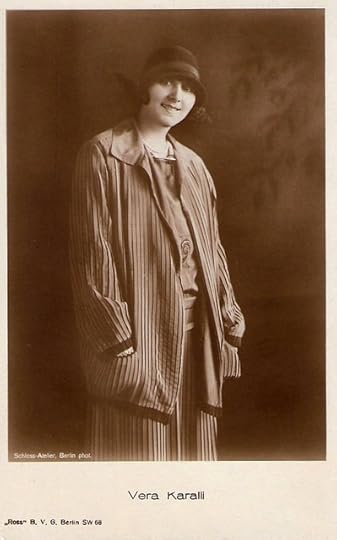
German postcard by Ross Verlag, Berlin. Photo: Schloss-Atelier, Berlin.
The Revenge of a Woman
Vera Karalli played in one French film La nuit du 11 septembre/The Night of September 11 (Bernard-Deschamps, 1919) opposite Severin-Mars .
In Germany she also played in one film, Die Rache einer Frau/The Revenge of a Woman (1921) by Robert Wiene, the director of Das Cabinet des Dr. Caligari. It was based on a story by Barbey d'Aurevilly. The Ross postcard above was probably made for this film.
At that time, she was also named Vera Caroly. In 1919 and 1920 she performed again with the Ballets Russes. In 1920, Karalli participated in a large a charity concert at the Paris Opéra along with opera singer and dancer Maria Kuznetsova amongst others, to raise funds to aid impoverished fellow Russian émigrés.
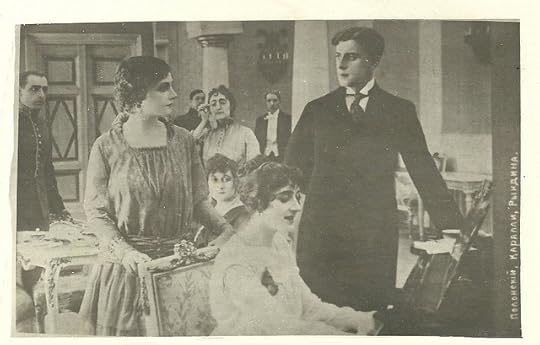
Russian postcard. Collection: Didier Hanson. Photo: publicity still for Vozmezdie/Retribution (Yevgeni Bauer, 1916) with Lidia Ryndina, Vera Karalli and Vitold Polonskywith.
Grand Hotel
In the 1920's, Vera Karalli taught dance in Kaunas in Lithuania, and from 1930 till 1935 she was the ballet mistress of the Rumanian Opera in Bucharest.
From 1938 to 1941 she lived in Paris, where she had a studio. Later she settled in Vienna, and taught there.
Vera Karalli died in Baden, Austria, in 1972. The character of Grusinskaya, played by Greta Garbo in Grand Hotel (Edmund Goulding, 1932), seems to be based on her.
Vera Karalli dances in Umirayushchii Lebed/The Dying Swan (1917). Source: GoldenSilents (YouTube). Music by Camille Saint-Saëns.
Sources: (IMDb), Wikipedia and .

Vintage Russian postcard.
Ballerina
Vera Alexeyevna Karalli (Russian: Вера Алексеевна Каралли) was born in Moscow, in 1889. After the Moscow Theater School, Vera Karalli performed with Sergei Diaghilev's Ballets Russes in 1909. At the Bolshoi Theatre she was promoted soloist after two years and ballerina in 1915.
From 1914 to 1919, she also had a short but intense (16 films) career in the Russian cinema. Her film debut was the drama Ty pomnish' li?/Do You Remember? (Pyotr Chardynin, 1914) opposite the successful actor Ivan Mozzhukhin . The next year she starred in Voyna i mir/War and Peace (Vladimir Gardin, Yakov Protazanov, 1915) based on the famous novel by Leo Tolstoy.
From 1915 on, she also played in the films by Yevgeni Bauer such as in the Turgenyev adaptation Posle smerti/After Death (1915) and the haunting melodrama Umirayushchii Lebed/The Dying Swan (1917). In the last film she is the beautiful Gizella, a mute ballerina murdered by an obsessive artist in order to get her in the right shape of the dying swan.
During the First World War, Karalli was considered one of the most celebrated actresses and dwelled in high circles (as mistress of Grand Duke Dmitri Pavlovich of Russia). She is suspected of being a co-conspirator in the murder of Grigori Rasputin in December 1916. Following the October Revolution, Karalli fled to Western Europe. Her last film in Russia was Mechta i zhizhn/Dream and Easy Life (Aleksandr Uralsky, 1918).

German postcard by Ross Verlag, Berlin. Photo: Schloss-Atelier, Berlin.
The Revenge of a Woman
Vera Karalli played in one French film La nuit du 11 septembre/The Night of September 11 (Bernard-Deschamps, 1919) opposite Severin-Mars .
In Germany she also played in one film, Die Rache einer Frau/The Revenge of a Woman (1921) by Robert Wiene, the director of Das Cabinet des Dr. Caligari. It was based on a story by Barbey d'Aurevilly. The Ross postcard above was probably made for this film.
At that time, she was also named Vera Caroly. In 1919 and 1920 she performed again with the Ballets Russes. In 1920, Karalli participated in a large a charity concert at the Paris Opéra along with opera singer and dancer Maria Kuznetsova amongst others, to raise funds to aid impoverished fellow Russian émigrés.

Russian postcard. Collection: Didier Hanson. Photo: publicity still for Vozmezdie/Retribution (Yevgeni Bauer, 1916) with Lidia Ryndina, Vera Karalli and Vitold Polonskywith.
Grand Hotel
In the 1920's, Vera Karalli taught dance in Kaunas in Lithuania, and from 1930 till 1935 she was the ballet mistress of the Rumanian Opera in Bucharest.
From 1938 to 1941 she lived in Paris, where she had a studio. Later she settled in Vienna, and taught there.
Vera Karalli died in Baden, Austria, in 1972. The character of Grusinskaya, played by Greta Garbo in Grand Hotel (Edmund Goulding, 1932), seems to be based on her.
Vera Karalli dances in Umirayushchii Lebed/The Dying Swan (1917). Source: GoldenSilents (YouTube). Music by Camille Saint-Saëns.
Sources: (IMDb), Wikipedia and .
Published on October 07, 2013 23:00
October 6, 2013
Louis Leubas
Louis Leubas was a French actor who in the 1910s starred in the films of Léonce Perret and Louis Feuillade.
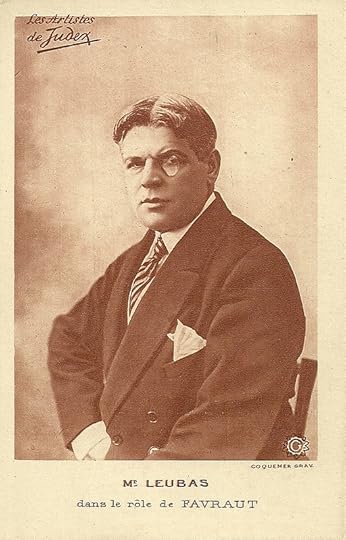
French postcard by Coquemer Gravures, Paris. Photo: Gaumont. Still for La nouvelle mission de Judex/The New Mission of Judex (Louis Feuillade, 1917-1918).
Corrupt Banker
Louis Leubas was born in 1870 (unknown where).
Just before 1900 he started as stage actor at the Théâtre du Vaudeville in Paris. Afterwards he also acted at l'Athénée, with Jules Berry , Marcel Lévesque and Georges Tréville.
Then he returned to the Vaudeville. It was there that film director Léonce Perret discovered him and had him forget the stage and debuted as film actor in Main de fer contre la bande aux gants blancs/The Iron Hand (1912).
Here he already incorporated a banker, precurring his part as the corrupt banker Favraux in Louis Feuillade’s crime serial Judex (1916-1917).
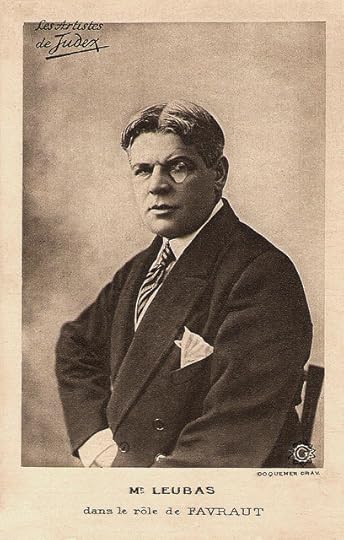
French postcard by Coquemer Gravures, Paris. Photo: Gaumont. Still for La nouvelle mission de Judex/The New Mission of Judex (Louis Feuillade, 1917-1918) with Louis Leubas in the role of Favraut.
Big Mouthed, Bossy Type
In the earlier 1910s, Louis Leubas mostly acted for Léonce Perret as director, with occasional sidesteps in films by Louis Feuillade, Maurice Mariaud, René le Somptier and Jean Durand.
From the mid-1910s on he almost exclusively worked with Louis Feuillade. Leubas was often type casted as the big mouthed, bossy type in dramatic films.
While his part as the head of police in the crime drama Les mystères des roches de Kador/The secret of the rocks of Kador (Léonce Perret, 1912) with Perret and Suzanne Grandais , may not have been so remarkable, Leubas put down a highly memorable performance as the abominably bad guy Edmond le Bachelier (the graduate) in L’Enfant de Paris/The child of Paris (Léonce Perret, 1913).
This dangerous gang leader sells an orphan girl escaped from boarding school as a young slave to a shop. There a young hunchback, Bosco (Maurice Lagrenée), takes care of her. When the Graduate hears her father is still alive, he extorts money from him, captures him, but his gang is caught and the father freed thanks to Bosco. The Graduate himself though escapes with the girl, pursued by Bosco all over France.
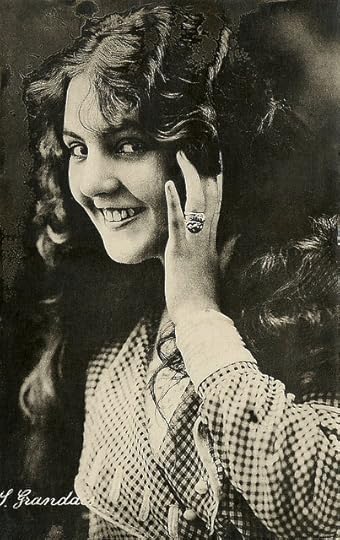
Suzanne Grandais. Vintage postcard. Collection: Didier Hanson.
Les Vampires
With Leonce Perret, Louis Leubas also acted in La force de l’argent/The power of money (1913), the sequel Main de fer et l'évasion du forçat de Croze/Iron Fist and the escape of the convict Croze (1913), La Voix de la patrie/Voice of the Fatherland (1914), Le Roman d’un mousse/The Romance of a foam (1914), L’Enigme de la Riviera/The Enigma of the Riviera (1915), La Fiançée du diable/The Devil's Bride (1916), and lastly Une mariage de raison/A marriage of convenience (1916) in co-direction with Feuillade.
With Louis Feuillade, Leubas already started acting in 1913, in the comedy La Vengeance du sergent de ville/The Revenge of the sergeant of the city. Leubas played the sergeant.
After various individual films by Feuillade, Leubas made his mark again in the crime serial Les Vampires/The Vampires (Louis Feuillade, 1915), in which he played the deaf-mute Father Silence (only in the 3rd episode) and the terrible Satanas, who leads the gang of the Vampires in the 7th and 8th of the 12 episodes, and uses a.o. a paralysing pin in his glove and a bomb in a top hat.
When he is finally imprisoned, he commits suicide by eating a poisoned note. Other actors were a.o. Musidora as the femme fatale Irma Vep, Edouard Mathé as the reporter Philipe Guérande and Marcel Lévesque as Mazamette.
Leubas became a regular member of the casts of practically all of Feuillade’s films until 1919 (23 titles), including the serials Judex (1916-1917), La nouvelle mission de Judex/The New Mission of Judex (1917-1918) – in which the banker Favraux has repented and is on the side of the good guys now, Tih Minh (1918-1919), and Vendémiaire (1918-1919).
Leubas’ last film for Feuillade was L’Homme sans visage (1919), starring René Cresté.
After two more films in 1922, Judith by Georges Monca and La Bâillonnée by Charles Burguet, he quitted acting in film altogether.
Louis Leubas died in Digne, France in 1932.
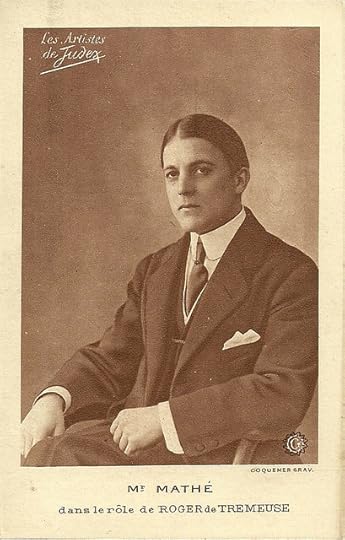
Edouard Mathé . French postcard by Coquemer Gravures, Paris. Photo: Gaumont. Still for La nouvelle mission de Judex (Louis Feuillade, 1917-1918).
Sources: Wikipedia (French and English) and .

French postcard by Coquemer Gravures, Paris. Photo: Gaumont. Still for La nouvelle mission de Judex/The New Mission of Judex (Louis Feuillade, 1917-1918).
Corrupt Banker
Louis Leubas was born in 1870 (unknown where).
Just before 1900 he started as stage actor at the Théâtre du Vaudeville in Paris. Afterwards he also acted at l'Athénée, with Jules Berry , Marcel Lévesque and Georges Tréville.
Then he returned to the Vaudeville. It was there that film director Léonce Perret discovered him and had him forget the stage and debuted as film actor in Main de fer contre la bande aux gants blancs/The Iron Hand (1912).
Here he already incorporated a banker, precurring his part as the corrupt banker Favraux in Louis Feuillade’s crime serial Judex (1916-1917).

French postcard by Coquemer Gravures, Paris. Photo: Gaumont. Still for La nouvelle mission de Judex/The New Mission of Judex (Louis Feuillade, 1917-1918) with Louis Leubas in the role of Favraut.
Big Mouthed, Bossy Type
In the earlier 1910s, Louis Leubas mostly acted for Léonce Perret as director, with occasional sidesteps in films by Louis Feuillade, Maurice Mariaud, René le Somptier and Jean Durand.
From the mid-1910s on he almost exclusively worked with Louis Feuillade. Leubas was often type casted as the big mouthed, bossy type in dramatic films.
While his part as the head of police in the crime drama Les mystères des roches de Kador/The secret of the rocks of Kador (Léonce Perret, 1912) with Perret and Suzanne Grandais , may not have been so remarkable, Leubas put down a highly memorable performance as the abominably bad guy Edmond le Bachelier (the graduate) in L’Enfant de Paris/The child of Paris (Léonce Perret, 1913).
This dangerous gang leader sells an orphan girl escaped from boarding school as a young slave to a shop. There a young hunchback, Bosco (Maurice Lagrenée), takes care of her. When the Graduate hears her father is still alive, he extorts money from him, captures him, but his gang is caught and the father freed thanks to Bosco. The Graduate himself though escapes with the girl, pursued by Bosco all over France.

Suzanne Grandais. Vintage postcard. Collection: Didier Hanson.
Les Vampires
With Leonce Perret, Louis Leubas also acted in La force de l’argent/The power of money (1913), the sequel Main de fer et l'évasion du forçat de Croze/Iron Fist and the escape of the convict Croze (1913), La Voix de la patrie/Voice of the Fatherland (1914), Le Roman d’un mousse/The Romance of a foam (1914), L’Enigme de la Riviera/The Enigma of the Riviera (1915), La Fiançée du diable/The Devil's Bride (1916), and lastly Une mariage de raison/A marriage of convenience (1916) in co-direction with Feuillade.
With Louis Feuillade, Leubas already started acting in 1913, in the comedy La Vengeance du sergent de ville/The Revenge of the sergeant of the city. Leubas played the sergeant.
After various individual films by Feuillade, Leubas made his mark again in the crime serial Les Vampires/The Vampires (Louis Feuillade, 1915), in which he played the deaf-mute Father Silence (only in the 3rd episode) and the terrible Satanas, who leads the gang of the Vampires in the 7th and 8th of the 12 episodes, and uses a.o. a paralysing pin in his glove and a bomb in a top hat.
When he is finally imprisoned, he commits suicide by eating a poisoned note. Other actors were a.o. Musidora as the femme fatale Irma Vep, Edouard Mathé as the reporter Philipe Guérande and Marcel Lévesque as Mazamette.
Leubas became a regular member of the casts of practically all of Feuillade’s films until 1919 (23 titles), including the serials Judex (1916-1917), La nouvelle mission de Judex/The New Mission of Judex (1917-1918) – in which the banker Favraux has repented and is on the side of the good guys now, Tih Minh (1918-1919), and Vendémiaire (1918-1919).
Leubas’ last film for Feuillade was L’Homme sans visage (1919), starring René Cresté.
After two more films in 1922, Judith by Georges Monca and La Bâillonnée by Charles Burguet, he quitted acting in film altogether.
Louis Leubas died in Digne, France in 1932.

Edouard Mathé . French postcard by Coquemer Gravures, Paris. Photo: Gaumont. Still for La nouvelle mission de Judex (Louis Feuillade, 1917-1918).
Sources: Wikipedia (French and English) and .
Published on October 06, 2013 23:00
October 5, 2013
I promessi sposi (1913)
One of the films presented at the
Le Giornate del Cinema Muto
is I promessi sposi/The Betrothed (Eleuterio Rodolfi, 1913). The early silent production of the Ambrosio company was welcomed in the US as ‘entirely worthy to be enrolled in the list of the world’s moving picture classics’. It is one of the many film adaptations of I promessi sposi by Alessandro Manzoni. This Italian historical novel belongs to the most famous and widely read books of the Italian language.

Italian postcard by IPA/CT, no. 1665. Photo: Film Soc. An. Ambrosio, Torino. Caption: Tornate, con sicurezza e con pace, ai pensieri d'una volta. (Return, safely and peacefully, to the thoughts of long ago).
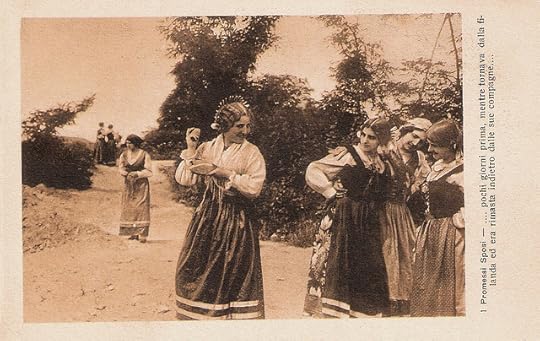
Italian postcard by IPA/CT. Photo: Film Soc. An. Ambrosio, Torino. Caption: ... pochi giorni prima, mentre tornava dalla filanda ed era rimasta indietro dalle sue compagne.... (...a few days before, while returning from the cotton mill, and left behind by her companions...).
For The Sake Of Euphony
The idea for the novel came to Alessandro Manzoni (1783 – 1873) in 1821, from something he saw in a book he took on holiday with him to Brusuglio. This was an edict from the year 1627, which specified penalties for any priest who refused to perform a marriage. More material came from Giuseppe Ripamonti's Milanese Chronicles.
Manzoni’s first version, Fermo e Lucia, was written between April 1821 and September 1823. It was heavily revised, and finished in August 1825. Corrections and proof-checking took two years.
The original title, Gli sposi promessi, was changed for the sake of euphony shortly before its publication in three volumes in 1827.
In the early 19th century, there was still some controversy as to what form the standard literary language of Italy should take.
Manzoni was firmly in favor of the dialect of Florence and, after washing his vocabulary on the banks of the Arno (as he put it), he revised the novel for its republication in 1842.
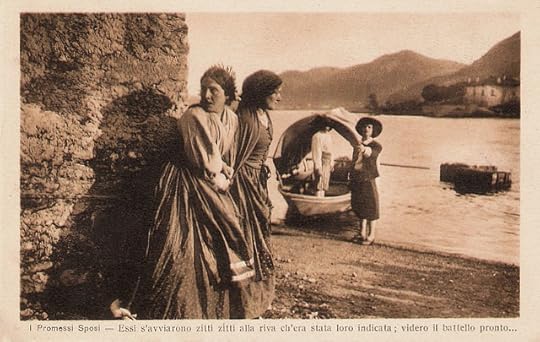
Italian postcard by IPA/CT, no. 1654. Photo: Film Soc. An. Ambrosio, Torino. Caption: Essi s'avviarono zitti zitti alla riva ch'era stata loro indicata; videro il battello pronto... (Very quietly, they walked to the shore which had been indicated to them, and they saw the boat ready for them ...).
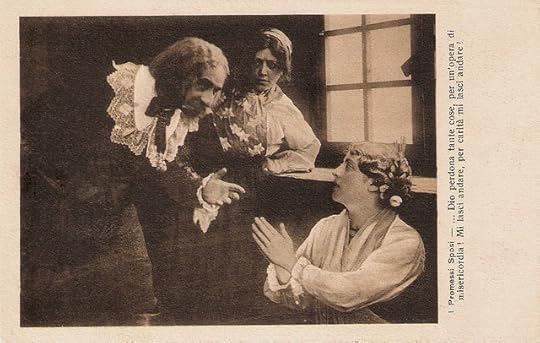
Italian postcard by IPA/CT, no. 1658. Photo: Film Soc. An. Ambrosio, Torino. Caption: ... Dio perdona tante cose, per un'opera di misericordia! Mi lasci andare, per carità mi lasci andare! (... God forgives so many things, for an act of compassion! Let me go, for heaven's sake let me go!).
A Turbulent Period
I Promessi Sposi was inspired by Walter Scott's Ivanhoe and was the first Italian historical novel. It deals with a variety of themes, from the cowardly, hypocritical nature of a priest (Don Abbondio) and the heroic sainthood of others (Padre Cristoforo, Federico Borromeo), to the unwavering strength of love (the relationship between Renzo and Lucia and the struggle of these betrothed to finally meet again and get married), and offers some keen insights into the meanderings of the human mind.
The middle of the 19th century was a turbulent period in Italy (it was the time of the Risorgimento, the Italian unification) and the literature was used as a means to express opinions about the state, society and religion.
I promessi sposi is considered the most representative document from the time of the Risorgimento and Romanticism. Moreover, it is considered one of the highlights of Italian literature and virtually every high school student in Italy read the book at school.
Regarding the structure is the first modern novel in Italian literary history and also has a major influence on the national Italian language. The book describes the Italy of the seventeenth century, during the Spanish occupation of the country. This can be seen as a message to the Austrians, who at the time of publication of the book Italy prevailed. Famous is also the description of the plague which broke out around 1630 in Milan.
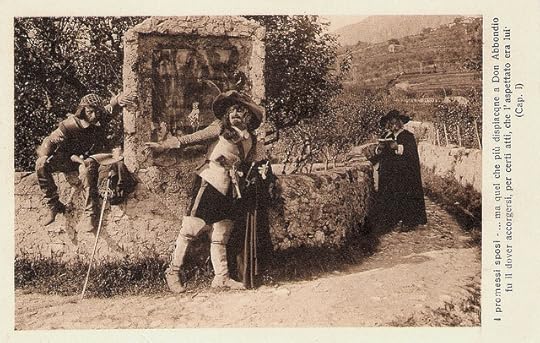
Italian postcard by Film Soc. An. Ambrosio, Torino, no. 1642. Caption: ...ma quel che pìu dispiacqne a Don Abbondio fu il dover accorgersi, per certi atti, che l'aspettato era lui. (... but what would most displease Don Abbondio, was that he had to discover by certain acts, that he was the one they were awaiting for...) (Chapter 1).
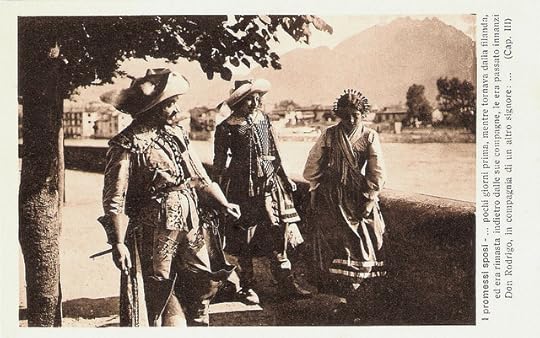
Italian postcard by Film Soc. An. Ambrosio, Torino, no. 1649. Caption: ...pochi giorni prima, mentre tornava dalla filanda, ed era rimasta indietro dalla sue compagne, le era passato innanzi Don Rodrigo, in compagnia di un altro signore.... (... a few days before, while returning from the mill, and left behind by her companions, before her passed Don Rodrigo, in the company of another gentleman...) (Chapter 3).
Wikipedia plot summary Chapters 1-8:
Lorenzo Tramaglino, or Renzo is a young silk-weaver of humble origins. He is engaged to Lucia Mondella is a pious and kind young woman. They live in a village near Lake Como in 1628.
The parish priest, Don Abbondio, is walking home on the previous evening when he is met by a pair of ‘bravoes’ (thugs) who tell him he is not to perform the marriage of Renzo and Lucia, as the local baron (Don Rodrigo) forbids it. The next day, Renzo is amazed when he turns up at Don Abbondio's home to hear that the marriage is to be postponed (he didn't have the courage to tell the truth). A long argument ensues and Renzo succeeds in extracting from the priest the name of Don Rodrigo.
It turns out that Don Rodrigo has his eye on Lucia. Lucia's mother, Agnese, advises Renzo to ask the advice of Dr. Azzeccagarbugli (Dr. Quibble-weaver), a lawyer in the town of Lecco. Dr Azzeccagarbugli is at first sympathetic, showing Renzo a recent edict on the subject of priests who refuse to marry, but when he hears the name of Don Rodrigo he panics and drives Renzo away.
Lucia sends a message to Fra Cristoforo (Friar Christopher), a respected Capuchin friar at the monastery of Pescarenico, asking him to come as soon as he can. At dawn, Fra Cristoforo comes to Lucia's cottage and hears the story. He immediately leaves for Don Rodrigo's mansion, where he finds the baron at a meal with his cousin Count Attilio, along with four guests, including the mayor and Dr Azzeccagarbugli. When Don Rodrigo is taken aside by the friar, he explodes with anger at his presumption and sends him away, but not before an old servant has a chance to offer him help.
Meanwhile, Agnese comes up with a plan. In those days, it was possible for two people to marry by declaring themselves married before a priest and in the presence of two amenable witnesses. Renzo runs to his friend Tonio and offers him 25 lire if he agrees to help. When Fra Cristoforo returns with the bad news, they decide to put their plan into action.
The next morning, Lucia and Agnese are visited by beggars who are, in fact, Don Rodrigo's men in disguise. They are examining the house in order to plan an assault. Late at night, Agnese distracts Don Abbondio's servant Perpetua while Tonio and his brother Gervaso enter Don Abbondio's study, ostensibly to pay a debt. They are followed indoors secretly by Lucia and Renzo. When they try to carry out their plan, the priest throws the tablecloth in Lucia's face and drops the lamp. They struggle in the darkness.
In the meantime, Don Rodrigo's men invade Lucia's house, but nobody is there. A boy named Menico arrives with a message of warning from Fra Cristoforo and they seize him. When they hear the alarm being raised by the sacristan, who is calling for help on the part of Don Abbondio who raised the alarm of invaders in his home, they assume they have been betrayed and flee in confusion.
Menico sees Agnese, Lucia and Renzo in the street and warns them not to return home. They go to the monastery, where Fra Cristoforo gives Renzo a letter of introduction to a certain friar at Milan, and another letter to the two women, to organise a refuge at a convent in the nearby city of Monza.
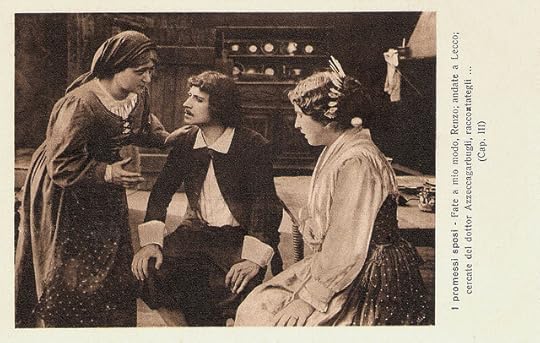
Italian postcard by Film Soc. An. Ambrosio, Torino, no. 1645. Caption: Fate a mio modo, Renzo; andate a Lecco; cercate del dottor Azzeccagarbugli, raccontategli... (Do it my way, Renzo; go to Lecco,find Dr Quibble-weaver, tell him ...) (Chapter 3).
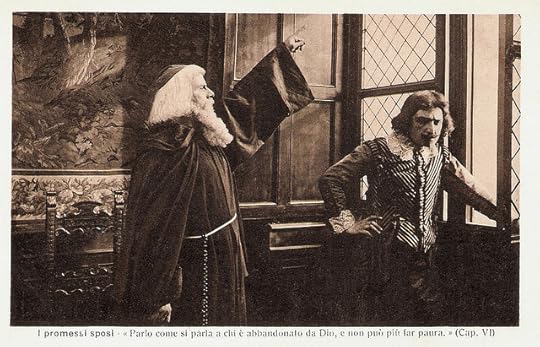
Italian postcard by Film Soc. An. Ambrosio, Torino, no. 1650. Caption: Parlo come si parla a chi è abbandonato da Dio, e non può più far paura. (I speak as one ought to speak to him who is abandoned by God, and can no longer frighten.) (Chapter 7).
Chapters 9-17: the Nun of Monza and Renzo in Milan
Lucia is entrusted to the nun Gertrude, a strange and unpredictable noblewoman whose story is told in these chapters. A child of the most important family of the area, her father decided to send her to the cloisters for no other reason than to simplify his affairs: he wished to keep his properties united for his first-born, heir to the family's title and riches. As she grew up, she sensed that she was being forced by her parents into a life which would comport but little with her personality. However, fear of scandal, as well as maneuvers and menaces from her father, induced Gertrude to lie to her interviewers in order to enter the convent of Monza, where she was received as la Signora (the lady).
Later, she fell under the spell of a young man of no scruples, associated with the worst baron of that time, the Innominato (the Unnamed). La Monaca di Monza (the Nun of Monza) was based on a historical character. Renzo arrives in famine-stricken Milan and goes to the monastery, but the friar he is seeking is absent and so he wanders further into the city. A bakery in the Corsia de' Servi, El prestin di scansc (Bakery of the Crutches), is destroyed by a rabble, which then goes to the house of the Commissioner of Supply in order to lynch him. He is saved in the nick of time by Ferrer, the Grand Chancellor, who arrives in a coach and announces he is taking the Commissioner to prison.
Renzo becomes prominent as he helps Ferrer make his way through the crowd. After witnessing these scenes, Renzo joins in a lively discussion and reveals views which attract the notice of a police agent in search of a scapegoat. The agent tries to lead Renzo directly to ´the best inn´ (the prison) but Renzo is tired and stops at one nearby where, after being plied with drink, he reveals his full name and address.
The next morning, he is awakened by a notary and two bailiffs, who handcuff him and start to take him away. In the street Renzo announces loudly that he is being punished for his heroism the day before and, with the aid of sympathetic onlookers, he effects his escape. Leaving the city by the same gate through which he entered, he sets off for Bergamo, knowing that his cousin Bortolo lives in a village nearby. Once there, he will be beyond the reach of the authorities of Milan (under Spanish domination), as Bergamo is territory of the Most Serene Republic of Venice.
At an inn in Gorgonzola, he overhears a conversation which makes it clear to him how much trouble he is in and so he walks all night until he reaches the River Adda. After a short sleep in a hut, he crosses the river at dawn in the boat of a fisherman and makes his way to his cousin's house, where he is welcomed as a silk-weaver under the pseudonym of Antonio Rivolta. The same day, orders for Renzo's arrest reach the town of Lecco, to the delight of Don Rodrigo.

Italian postcard by IPA/CT, no. 1653. Photo: Film Soc. An. Ambrosio, Torino. Caption: Figliuoli! ringraziate il Signore, che v'ha scampati da un gran pericolo. Forse in questo momento...! (My children! Thank the Lord that he has saved you from a great danger. Perhaps at this moment ...!) (Chapter 8).
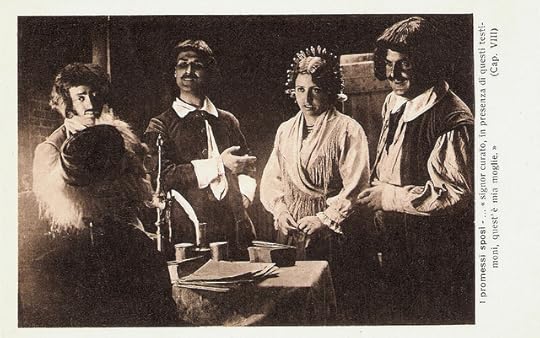
Italian postcard by Film Soc. An. Ambrosio, Torino, no. 1647. Caption: signor curato, in presenza di questi testimoni, quest'è mia moglie. (Father, in the presence of these witnesses, this is my wife..) (Chapter 8).
Chapters 18-24: Lucia and the Unnamed
News of Renzo's disgrace comes to the convent, but later Lucia is informed that Renzo is safe with his cousin. Their reassurance is short-lived: when they receive no word from Fra Cristoforo for a long time, Agnese travels to Pescarenico, where she learns that he has been ordered by a superior to the town of Rimini. In fact, this has been engineered by Don Rodrigo and Count Attilio, who have leaned on a mutual uncle of the Secret Council, who has leaned on the Father Provincial.
Meanwhile, Don Rodrigo has organized a plot to kidnap Lucia from the convent. This involves a very great robber baron whose name has not been recorded, and who hence is called l'Innominato, the Unnamed.
Gertrude, blackmailed by Egidio, a male neighbour (and acquaintance of l'Innominato) whose attentions she has returned, persuades Lucia to run an errand which will take her outside the convent for a short while. In the street Lucia is seized and bundled into a coach.
After a nightmarish journey, Lucia arrives at the castle of the Unnamed, where she is locked up in a chamber. The Unnamed is troubled by the sight of her, and spends a horrible night in which memories of his past and the uncertainty of his future almost drive him to suicide.
Meanwhile, Lucia spends a similarly restless night, during which she vows to take the veil if she is delivered from her predicament. Towards the morning, on looking out of his window, the Unnamed sees throngs of people walking past. They are going to listen to the famous Archbishop of Milan, Cardinal Federigo Borromeo.
On impulse, the Unnamed leaves his castle in order to meet this man. This meeting prompts a ´miraculous´ conversion which marks the turning-point of the novel. The Unnamed announces to his men that his reign of terror is over. He decides to take Lucia back to her native land under his own protection, and with the help of the archbishop the deed is done.

Italian postcard by Film Soc. An. Ambrosio, Torino, no. 1659. Caption: ...lasciate ch'io stringa cotesta mano che riparera tanti torti. (...permit me to press this hand which will repair so many wrongs....) (Chapter 23).
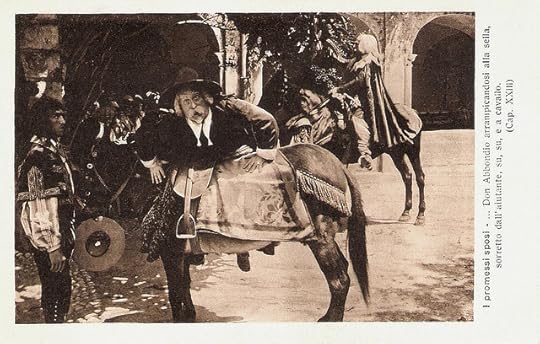
Italian postcard by Film Soc. An. Ambrosio, Torino, no. 1662. Caption: Don Abbondio arrampicandosi alla sella, sorretto dall' aiutante, su, su, e a cavallo. (Don Abbondio climbed onto the saddle, helped by his aid, slowly, slowly, he mounted the horse.) (Chapter 23).
Chapters 25-38: Fall of Don Rodrigo, Famine and War, Plague and Conclusion
The astonishing course of events leads to an atmosphere in which Don Rodrigo can be defied openly and his fortunes take a turn for the worse. Don Abbondio is reprimanded by the archbishop. Lucia, miserable about her vow to renounce Renzo, still frets about him. He is now the subject of diplomatic conflict between Milan and Bergamo. Her life is not improved when a wealthy busybody, Donna Prassede, insists on taking her into her household and admonishing her for getting mixed up with a good-for-nothing like Renzo.
The government of Milan is unable to keep bread prices down by decree and the city is swamped by beggars. The lazzaretto is filled with the hungry and sick. Meanwhile the Thirty Years War brings more calamities. In 1629, German armies under Count Rambaldo di Collalto descend into Italy, looting and destroying. Agnese, Don Abbondio and Perpetua take refuge in the well-defended territory of the Unnamed.
In their absence, their village is wrecked by the mercenaries. Then there are chapters with an account of the plague of 1630, largely based on Giuseppe Ripamonti's De peste quae fuit anno 1630 (published in 1640). Manzoni's full version of this, Storia della Colonna Infame, was finished in 1829, but was not published until it was included as an appendix to the revised edition of 1842.
The end of August 1630 sees the death in Milan of the original villains of the story. Renzo, troubled by Agnese's letters and recovering from plague, returns to his native village to find that many of the inhabitants are dead and that his house and vineyard have been destroyed. The warrant, and Don Rodrigo, are forgotten.
Tonio tells him that Lucia is in Milan. On his arrival in Milan, Renzo is astonished at the state of the city. His highland clothes invite suspicion that he is an 'anointer'; that is, a foreign agent deliberately spreading plague in some way. He learns that Lucia is now languishing at the lazzaretto, along with 16,000 other victims of the plague.
But in fact, Lucia is already recuperating. Renzo and Lucia are reunited by Fra Cristoforo, but only after Renzo first visits and forgives the dying Don Rodrigo. The friar absolves her of her vow of celibacy. Renzo walks through a rainstorm to see Agnese at the village of Pasturo. When they all return to their native village, Lucia and Renzo are finally married by Don Abbondio and the couple make a fresh start at a silk-mill at the gates of Bergamo.
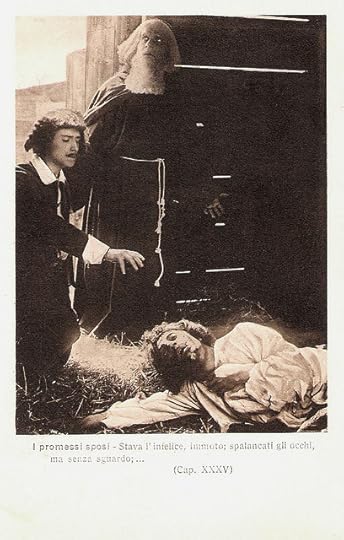
Italian postcard by Film Soc. An. Ambrosio, Torino, no. 1664. Caption: Stava l'infelice, immoto; spalancati gli occhi, ma senza sguardo;... (There the miserable was, motionless; his eyes were wide open, but unseeing; ... .) (Chapter 35).
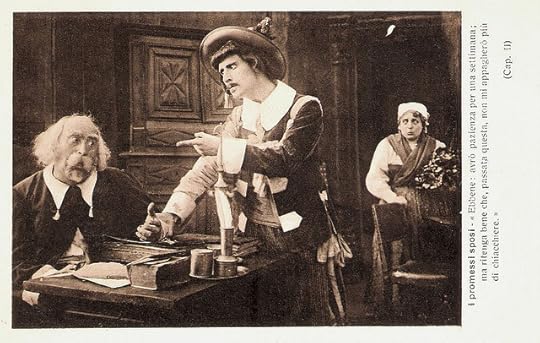
Italian postcard by Film Soc. An. Ambrosio, Torino, no. 1643. Caption: Ebbene: avrò pazienza per una settimana; ma ritenga bene che, passata questa, non mi appagherò più di chiacchiere. (Alright, I will have patience for one week. But remember, when this week has passed I will not stand this nonsense anymore.) (Chapter 2).
Ambrosio
The postcards in this post were all produced for the Ambrosio version, I promessi sposi (Eleuterio Rodolfi, 1913), which premiered in September 1913. Ambrosio was one of the major production houses of the early Italian cinema. It was particularly renowned for quality literary adaptations, such as the super epic Gli ultimi giorni di Pompei/The Last Days of Pompeii (Arturo Ambrosio, Luigi Maggi, 1908) and seven films based on the novels of Gabriele D’Annunzio in 1911 and 1912.
Their version starred Gigetta Morano as Lucia and Mario Voller-Buzzi as Renzo. The other actors included Ersilia Scalpellini (Agnese), Bianca Schinini (Perpetua), Umberto Scalpellini (Don Abbondio), Eugenia Tettoni (the Nun of Monza), Antonio Grisanti (the Innominato), Cesare Zocchi (Fra Cristoforo), Luigi Chiesa (Don Abbondio) and Edoardo Rivalta (Cardinal Borromeo).
When the film was shown in the US in 1913, W. Stephen Bush wrote in The Moving Picture World : ”Something of the charm of Manzoni’s genius gets on the screen and casts a spell on the spectator. It is very evident that this was a labor of love with the Ambrosio company. To begin with, they have gone to the trouble of taking various scenes of the story on the various spots where Manzoni has located them, and we get glimpses of Lake Como set like a gem in one of the most beautiful landscapes of the world. The charm in the story lies in the fact that it deals with the adventures of a young couple from the ranks of the plain people of Italy.
Their simple honesty is set in striking contrast with the corruption and magnificence of the noble rulers of the country. (…) The producer has improved to the utmost every opportunity for spectacular work. The insurrection and the bread riots in Milan and later the fearful scenes in the deserted streets when the plague wept over the city, are portrayed with imposing skill and fidelity to life and history. The Betroyed by the Ambrosio Company is entirely worthy to be enrolled in the list of the world’s moving picture classics.”
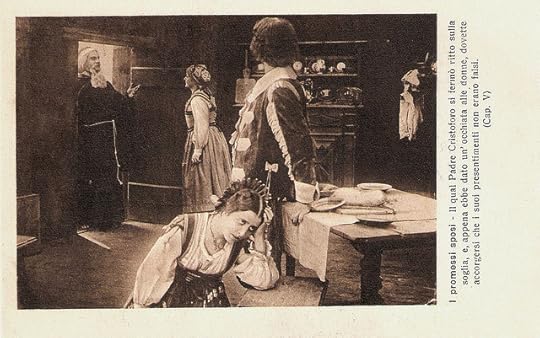
Italian postcard by Film Soc. An. Ambrosio, Torino, no. 1646. Caption: Il qual Padre Cristoforo si fermò ritto sulla soglia, e, appena ebbe dato un'occhiata alle donne, dovette accorgersi che i suoi presentimenti non erano falsi. (Then Father Christopher stood in the doorway, and, as soon as he looked at the women, he had to realize that his premonitions were not false.) (Chapter 5).
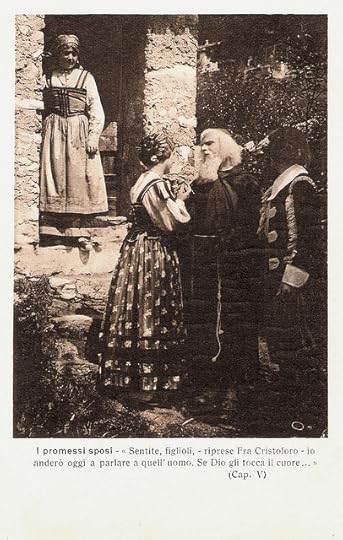
Italian postcard by Film Soc. An. Ambrosio, Torino, no. 1652. Caption: Sentite, figlioli, - riprese Fra Cristoforo - io anderò oggi a parlare a quell' uomo. Se Dio gli tocca il cuore... (Listen, children, - father Cristoforo answered - I will go and speak to that man today. If God touches his heart ....) (Chapter 5).
Opera, Film and TV
I promessi sposi was made into an opera of the same name by Amilcare Ponchielli in 1856 and by Errico Petrella in 1869.
There have been many film versions, all made in Italy. The first silent adaptation was I Promessi Sposi (Mario Mareis, 1908).
In 1913 there were two competing versions: film company Pasquali from Torino (Turin) made the one version, I promessi sposi (Ubaldo Maria Del Colle, 1913), and the other version I promessi sposi (Eleuterio Rodolfi, 1913) was produced by film company Ambrosio from the same city. Turin was the capital of the early Italian film industry.
Nine years later followed another silent adaptation: I promessi sposi (Mario Bonnard, 1922). The first sound version was I promessi sposi/The Spirit and the Flesh (Mario Camerini, 1941) starring Gino Cervi as Renzo. Then there was a Spanish-Italian version I Promessi Sposi (Mario Maffei, 1964), starring Gil Vidal and Maria Silva as Renzo and Lucia.
There were also various television versions. In 1967 Nino Castelnuovo starred as Renzo in the TV series I promessi sposi (Sandro Bolchi, 1967). Later followed the Italian-German-Yugoslavian TV series I promessi sposi (Salvatore Nocita, 1989) with an all-star cast including Danny Quinn, Alberto Sordi , Franco Nero , Helmut Berger and Burt Lancaster, and the TV film Renzo e Lucia/Renzo and Lucia (Francesca Archibugi, 2004) with Stefania Sandrelli as Agnese, Laura Morante as the Nun of Monza and Gottfried John as the Innominato.
There were also some parodies. Director Nanni Moretti made the comic Come parli, frate?/As you talk, brother (Nanni Moretti, 1974) and there was the TV miniseries I promessi Sposi (Massimo Lopez, Anna Marchesini, Tullio Solenghi, 1990) with Giuliano Gemma as El Gringo.
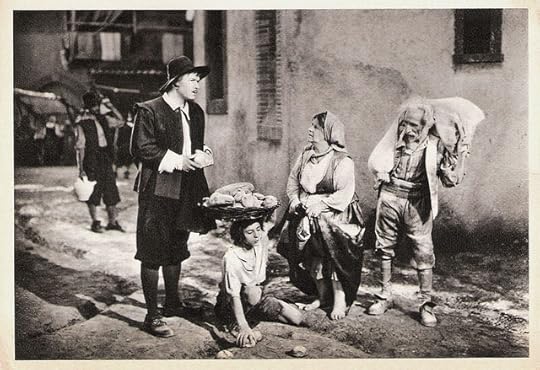
Italian postcard by S.A. Grafitalia, Milano (Milan), no. 10. Photo: Film Lux. Publicity still for I Promessi Sposi/The Spirit and the Flesh (Mario Camerini, 1941) starring Gino Cervi .
Sources: Aldo Bernardini/Vittorio Martinelli (Il Cinema Muto Italiano 1913), Gino Moliterno (The A to Z of Italian Cinema), Wikipedia, and IMDb.

Italian postcard by IPA/CT, no. 1665. Photo: Film Soc. An. Ambrosio, Torino. Caption: Tornate, con sicurezza e con pace, ai pensieri d'una volta. (Return, safely and peacefully, to the thoughts of long ago).

Italian postcard by IPA/CT. Photo: Film Soc. An. Ambrosio, Torino. Caption: ... pochi giorni prima, mentre tornava dalla filanda ed era rimasta indietro dalle sue compagne.... (...a few days before, while returning from the cotton mill, and left behind by her companions...).
For The Sake Of Euphony
The idea for the novel came to Alessandro Manzoni (1783 – 1873) in 1821, from something he saw in a book he took on holiday with him to Brusuglio. This was an edict from the year 1627, which specified penalties for any priest who refused to perform a marriage. More material came from Giuseppe Ripamonti's Milanese Chronicles.
Manzoni’s first version, Fermo e Lucia, was written between April 1821 and September 1823. It was heavily revised, and finished in August 1825. Corrections and proof-checking took two years.
The original title, Gli sposi promessi, was changed for the sake of euphony shortly before its publication in three volumes in 1827.
In the early 19th century, there was still some controversy as to what form the standard literary language of Italy should take.
Manzoni was firmly in favor of the dialect of Florence and, after washing his vocabulary on the banks of the Arno (as he put it), he revised the novel for its republication in 1842.

Italian postcard by IPA/CT, no. 1654. Photo: Film Soc. An. Ambrosio, Torino. Caption: Essi s'avviarono zitti zitti alla riva ch'era stata loro indicata; videro il battello pronto... (Very quietly, they walked to the shore which had been indicated to them, and they saw the boat ready for them ...).

Italian postcard by IPA/CT, no. 1658. Photo: Film Soc. An. Ambrosio, Torino. Caption: ... Dio perdona tante cose, per un'opera di misericordia! Mi lasci andare, per carità mi lasci andare! (... God forgives so many things, for an act of compassion! Let me go, for heaven's sake let me go!).
A Turbulent Period
I Promessi Sposi was inspired by Walter Scott's Ivanhoe and was the first Italian historical novel. It deals with a variety of themes, from the cowardly, hypocritical nature of a priest (Don Abbondio) and the heroic sainthood of others (Padre Cristoforo, Federico Borromeo), to the unwavering strength of love (the relationship between Renzo and Lucia and the struggle of these betrothed to finally meet again and get married), and offers some keen insights into the meanderings of the human mind.
The middle of the 19th century was a turbulent period in Italy (it was the time of the Risorgimento, the Italian unification) and the literature was used as a means to express opinions about the state, society and religion.
I promessi sposi is considered the most representative document from the time of the Risorgimento and Romanticism. Moreover, it is considered one of the highlights of Italian literature and virtually every high school student in Italy read the book at school.
Regarding the structure is the first modern novel in Italian literary history and also has a major influence on the national Italian language. The book describes the Italy of the seventeenth century, during the Spanish occupation of the country. This can be seen as a message to the Austrians, who at the time of publication of the book Italy prevailed. Famous is also the description of the plague which broke out around 1630 in Milan.

Italian postcard by Film Soc. An. Ambrosio, Torino, no. 1642. Caption: ...ma quel che pìu dispiacqne a Don Abbondio fu il dover accorgersi, per certi atti, che l'aspettato era lui. (... but what would most displease Don Abbondio, was that he had to discover by certain acts, that he was the one they were awaiting for...) (Chapter 1).

Italian postcard by Film Soc. An. Ambrosio, Torino, no. 1649. Caption: ...pochi giorni prima, mentre tornava dalla filanda, ed era rimasta indietro dalla sue compagne, le era passato innanzi Don Rodrigo, in compagnia di un altro signore.... (... a few days before, while returning from the mill, and left behind by her companions, before her passed Don Rodrigo, in the company of another gentleman...) (Chapter 3).
Wikipedia plot summary Chapters 1-8:
Lorenzo Tramaglino, or Renzo is a young silk-weaver of humble origins. He is engaged to Lucia Mondella is a pious and kind young woman. They live in a village near Lake Como in 1628.
The parish priest, Don Abbondio, is walking home on the previous evening when he is met by a pair of ‘bravoes’ (thugs) who tell him he is not to perform the marriage of Renzo and Lucia, as the local baron (Don Rodrigo) forbids it. The next day, Renzo is amazed when he turns up at Don Abbondio's home to hear that the marriage is to be postponed (he didn't have the courage to tell the truth). A long argument ensues and Renzo succeeds in extracting from the priest the name of Don Rodrigo.
It turns out that Don Rodrigo has his eye on Lucia. Lucia's mother, Agnese, advises Renzo to ask the advice of Dr. Azzeccagarbugli (Dr. Quibble-weaver), a lawyer in the town of Lecco. Dr Azzeccagarbugli is at first sympathetic, showing Renzo a recent edict on the subject of priests who refuse to marry, but when he hears the name of Don Rodrigo he panics and drives Renzo away.
Lucia sends a message to Fra Cristoforo (Friar Christopher), a respected Capuchin friar at the monastery of Pescarenico, asking him to come as soon as he can. At dawn, Fra Cristoforo comes to Lucia's cottage and hears the story. He immediately leaves for Don Rodrigo's mansion, where he finds the baron at a meal with his cousin Count Attilio, along with four guests, including the mayor and Dr Azzeccagarbugli. When Don Rodrigo is taken aside by the friar, he explodes with anger at his presumption and sends him away, but not before an old servant has a chance to offer him help.
Meanwhile, Agnese comes up with a plan. In those days, it was possible for two people to marry by declaring themselves married before a priest and in the presence of two amenable witnesses. Renzo runs to his friend Tonio and offers him 25 lire if he agrees to help. When Fra Cristoforo returns with the bad news, they decide to put their plan into action.
The next morning, Lucia and Agnese are visited by beggars who are, in fact, Don Rodrigo's men in disguise. They are examining the house in order to plan an assault. Late at night, Agnese distracts Don Abbondio's servant Perpetua while Tonio and his brother Gervaso enter Don Abbondio's study, ostensibly to pay a debt. They are followed indoors secretly by Lucia and Renzo. When they try to carry out their plan, the priest throws the tablecloth in Lucia's face and drops the lamp. They struggle in the darkness.
In the meantime, Don Rodrigo's men invade Lucia's house, but nobody is there. A boy named Menico arrives with a message of warning from Fra Cristoforo and they seize him. When they hear the alarm being raised by the sacristan, who is calling for help on the part of Don Abbondio who raised the alarm of invaders in his home, they assume they have been betrayed and flee in confusion.
Menico sees Agnese, Lucia and Renzo in the street and warns them not to return home. They go to the monastery, where Fra Cristoforo gives Renzo a letter of introduction to a certain friar at Milan, and another letter to the two women, to organise a refuge at a convent in the nearby city of Monza.

Italian postcard by Film Soc. An. Ambrosio, Torino, no. 1645. Caption: Fate a mio modo, Renzo; andate a Lecco; cercate del dottor Azzeccagarbugli, raccontategli... (Do it my way, Renzo; go to Lecco,find Dr Quibble-weaver, tell him ...) (Chapter 3).

Italian postcard by Film Soc. An. Ambrosio, Torino, no. 1650. Caption: Parlo come si parla a chi è abbandonato da Dio, e non può più far paura. (I speak as one ought to speak to him who is abandoned by God, and can no longer frighten.) (Chapter 7).
Chapters 9-17: the Nun of Monza and Renzo in Milan
Lucia is entrusted to the nun Gertrude, a strange and unpredictable noblewoman whose story is told in these chapters. A child of the most important family of the area, her father decided to send her to the cloisters for no other reason than to simplify his affairs: he wished to keep his properties united for his first-born, heir to the family's title and riches. As she grew up, she sensed that she was being forced by her parents into a life which would comport but little with her personality. However, fear of scandal, as well as maneuvers and menaces from her father, induced Gertrude to lie to her interviewers in order to enter the convent of Monza, where she was received as la Signora (the lady).
Later, she fell under the spell of a young man of no scruples, associated with the worst baron of that time, the Innominato (the Unnamed). La Monaca di Monza (the Nun of Monza) was based on a historical character. Renzo arrives in famine-stricken Milan and goes to the monastery, but the friar he is seeking is absent and so he wanders further into the city. A bakery in the Corsia de' Servi, El prestin di scansc (Bakery of the Crutches), is destroyed by a rabble, which then goes to the house of the Commissioner of Supply in order to lynch him. He is saved in the nick of time by Ferrer, the Grand Chancellor, who arrives in a coach and announces he is taking the Commissioner to prison.
Renzo becomes prominent as he helps Ferrer make his way through the crowd. After witnessing these scenes, Renzo joins in a lively discussion and reveals views which attract the notice of a police agent in search of a scapegoat. The agent tries to lead Renzo directly to ´the best inn´ (the prison) but Renzo is tired and stops at one nearby where, after being plied with drink, he reveals his full name and address.
The next morning, he is awakened by a notary and two bailiffs, who handcuff him and start to take him away. In the street Renzo announces loudly that he is being punished for his heroism the day before and, with the aid of sympathetic onlookers, he effects his escape. Leaving the city by the same gate through which he entered, he sets off for Bergamo, knowing that his cousin Bortolo lives in a village nearby. Once there, he will be beyond the reach of the authorities of Milan (under Spanish domination), as Bergamo is territory of the Most Serene Republic of Venice.
At an inn in Gorgonzola, he overhears a conversation which makes it clear to him how much trouble he is in and so he walks all night until he reaches the River Adda. After a short sleep in a hut, he crosses the river at dawn in the boat of a fisherman and makes his way to his cousin's house, where he is welcomed as a silk-weaver under the pseudonym of Antonio Rivolta. The same day, orders for Renzo's arrest reach the town of Lecco, to the delight of Don Rodrigo.

Italian postcard by IPA/CT, no. 1653. Photo: Film Soc. An. Ambrosio, Torino. Caption: Figliuoli! ringraziate il Signore, che v'ha scampati da un gran pericolo. Forse in questo momento...! (My children! Thank the Lord that he has saved you from a great danger. Perhaps at this moment ...!) (Chapter 8).

Italian postcard by Film Soc. An. Ambrosio, Torino, no. 1647. Caption: signor curato, in presenza di questi testimoni, quest'è mia moglie. (Father, in the presence of these witnesses, this is my wife..) (Chapter 8).
Chapters 18-24: Lucia and the Unnamed
News of Renzo's disgrace comes to the convent, but later Lucia is informed that Renzo is safe with his cousin. Their reassurance is short-lived: when they receive no word from Fra Cristoforo for a long time, Agnese travels to Pescarenico, where she learns that he has been ordered by a superior to the town of Rimini. In fact, this has been engineered by Don Rodrigo and Count Attilio, who have leaned on a mutual uncle of the Secret Council, who has leaned on the Father Provincial.
Meanwhile, Don Rodrigo has organized a plot to kidnap Lucia from the convent. This involves a very great robber baron whose name has not been recorded, and who hence is called l'Innominato, the Unnamed.
Gertrude, blackmailed by Egidio, a male neighbour (and acquaintance of l'Innominato) whose attentions she has returned, persuades Lucia to run an errand which will take her outside the convent for a short while. In the street Lucia is seized and bundled into a coach.
After a nightmarish journey, Lucia arrives at the castle of the Unnamed, where she is locked up in a chamber. The Unnamed is troubled by the sight of her, and spends a horrible night in which memories of his past and the uncertainty of his future almost drive him to suicide.
Meanwhile, Lucia spends a similarly restless night, during which she vows to take the veil if she is delivered from her predicament. Towards the morning, on looking out of his window, the Unnamed sees throngs of people walking past. They are going to listen to the famous Archbishop of Milan, Cardinal Federigo Borromeo.
On impulse, the Unnamed leaves his castle in order to meet this man. This meeting prompts a ´miraculous´ conversion which marks the turning-point of the novel. The Unnamed announces to his men that his reign of terror is over. He decides to take Lucia back to her native land under his own protection, and with the help of the archbishop the deed is done.

Italian postcard by Film Soc. An. Ambrosio, Torino, no. 1659. Caption: ...lasciate ch'io stringa cotesta mano che riparera tanti torti. (...permit me to press this hand which will repair so many wrongs....) (Chapter 23).

Italian postcard by Film Soc. An. Ambrosio, Torino, no. 1662. Caption: Don Abbondio arrampicandosi alla sella, sorretto dall' aiutante, su, su, e a cavallo. (Don Abbondio climbed onto the saddle, helped by his aid, slowly, slowly, he mounted the horse.) (Chapter 23).
Chapters 25-38: Fall of Don Rodrigo, Famine and War, Plague and Conclusion
The astonishing course of events leads to an atmosphere in which Don Rodrigo can be defied openly and his fortunes take a turn for the worse. Don Abbondio is reprimanded by the archbishop. Lucia, miserable about her vow to renounce Renzo, still frets about him. He is now the subject of diplomatic conflict between Milan and Bergamo. Her life is not improved when a wealthy busybody, Donna Prassede, insists on taking her into her household and admonishing her for getting mixed up with a good-for-nothing like Renzo.
The government of Milan is unable to keep bread prices down by decree and the city is swamped by beggars. The lazzaretto is filled with the hungry and sick. Meanwhile the Thirty Years War brings more calamities. In 1629, German armies under Count Rambaldo di Collalto descend into Italy, looting and destroying. Agnese, Don Abbondio and Perpetua take refuge in the well-defended territory of the Unnamed.
In their absence, their village is wrecked by the mercenaries. Then there are chapters with an account of the plague of 1630, largely based on Giuseppe Ripamonti's De peste quae fuit anno 1630 (published in 1640). Manzoni's full version of this, Storia della Colonna Infame, was finished in 1829, but was not published until it was included as an appendix to the revised edition of 1842.
The end of August 1630 sees the death in Milan of the original villains of the story. Renzo, troubled by Agnese's letters and recovering from plague, returns to his native village to find that many of the inhabitants are dead and that his house and vineyard have been destroyed. The warrant, and Don Rodrigo, are forgotten.
Tonio tells him that Lucia is in Milan. On his arrival in Milan, Renzo is astonished at the state of the city. His highland clothes invite suspicion that he is an 'anointer'; that is, a foreign agent deliberately spreading plague in some way. He learns that Lucia is now languishing at the lazzaretto, along with 16,000 other victims of the plague.
But in fact, Lucia is already recuperating. Renzo and Lucia are reunited by Fra Cristoforo, but only after Renzo first visits and forgives the dying Don Rodrigo. The friar absolves her of her vow of celibacy. Renzo walks through a rainstorm to see Agnese at the village of Pasturo. When they all return to their native village, Lucia and Renzo are finally married by Don Abbondio and the couple make a fresh start at a silk-mill at the gates of Bergamo.

Italian postcard by Film Soc. An. Ambrosio, Torino, no. 1664. Caption: Stava l'infelice, immoto; spalancati gli occhi, ma senza sguardo;... (There the miserable was, motionless; his eyes were wide open, but unseeing; ... .) (Chapter 35).

Italian postcard by Film Soc. An. Ambrosio, Torino, no. 1643. Caption: Ebbene: avrò pazienza per una settimana; ma ritenga bene che, passata questa, non mi appagherò più di chiacchiere. (Alright, I will have patience for one week. But remember, when this week has passed I will not stand this nonsense anymore.) (Chapter 2).
Ambrosio
The postcards in this post were all produced for the Ambrosio version, I promessi sposi (Eleuterio Rodolfi, 1913), which premiered in September 1913. Ambrosio was one of the major production houses of the early Italian cinema. It was particularly renowned for quality literary adaptations, such as the super epic Gli ultimi giorni di Pompei/The Last Days of Pompeii (Arturo Ambrosio, Luigi Maggi, 1908) and seven films based on the novels of Gabriele D’Annunzio in 1911 and 1912.
Their version starred Gigetta Morano as Lucia and Mario Voller-Buzzi as Renzo. The other actors included Ersilia Scalpellini (Agnese), Bianca Schinini (Perpetua), Umberto Scalpellini (Don Abbondio), Eugenia Tettoni (the Nun of Monza), Antonio Grisanti (the Innominato), Cesare Zocchi (Fra Cristoforo), Luigi Chiesa (Don Abbondio) and Edoardo Rivalta (Cardinal Borromeo).
When the film was shown in the US in 1913, W. Stephen Bush wrote in The Moving Picture World : ”Something of the charm of Manzoni’s genius gets on the screen and casts a spell on the spectator. It is very evident that this was a labor of love with the Ambrosio company. To begin with, they have gone to the trouble of taking various scenes of the story on the various spots where Manzoni has located them, and we get glimpses of Lake Como set like a gem in one of the most beautiful landscapes of the world. The charm in the story lies in the fact that it deals with the adventures of a young couple from the ranks of the plain people of Italy.
Their simple honesty is set in striking contrast with the corruption and magnificence of the noble rulers of the country. (…) The producer has improved to the utmost every opportunity for spectacular work. The insurrection and the bread riots in Milan and later the fearful scenes in the deserted streets when the plague wept over the city, are portrayed with imposing skill and fidelity to life and history. The Betroyed by the Ambrosio Company is entirely worthy to be enrolled in the list of the world’s moving picture classics.”

Italian postcard by Film Soc. An. Ambrosio, Torino, no. 1646. Caption: Il qual Padre Cristoforo si fermò ritto sulla soglia, e, appena ebbe dato un'occhiata alle donne, dovette accorgersi che i suoi presentimenti non erano falsi. (Then Father Christopher stood in the doorway, and, as soon as he looked at the women, he had to realize that his premonitions were not false.) (Chapter 5).

Italian postcard by Film Soc. An. Ambrosio, Torino, no. 1652. Caption: Sentite, figlioli, - riprese Fra Cristoforo - io anderò oggi a parlare a quell' uomo. Se Dio gli tocca il cuore... (Listen, children, - father Cristoforo answered - I will go and speak to that man today. If God touches his heart ....) (Chapter 5).
Opera, Film and TV
I promessi sposi was made into an opera of the same name by Amilcare Ponchielli in 1856 and by Errico Petrella in 1869.
There have been many film versions, all made in Italy. The first silent adaptation was I Promessi Sposi (Mario Mareis, 1908).
In 1913 there were two competing versions: film company Pasquali from Torino (Turin) made the one version, I promessi sposi (Ubaldo Maria Del Colle, 1913), and the other version I promessi sposi (Eleuterio Rodolfi, 1913) was produced by film company Ambrosio from the same city. Turin was the capital of the early Italian film industry.
Nine years later followed another silent adaptation: I promessi sposi (Mario Bonnard, 1922). The first sound version was I promessi sposi/The Spirit and the Flesh (Mario Camerini, 1941) starring Gino Cervi as Renzo. Then there was a Spanish-Italian version I Promessi Sposi (Mario Maffei, 1964), starring Gil Vidal and Maria Silva as Renzo and Lucia.
There were also various television versions. In 1967 Nino Castelnuovo starred as Renzo in the TV series I promessi sposi (Sandro Bolchi, 1967). Later followed the Italian-German-Yugoslavian TV series I promessi sposi (Salvatore Nocita, 1989) with an all-star cast including Danny Quinn, Alberto Sordi , Franco Nero , Helmut Berger and Burt Lancaster, and the TV film Renzo e Lucia/Renzo and Lucia (Francesca Archibugi, 2004) with Stefania Sandrelli as Agnese, Laura Morante as the Nun of Monza and Gottfried John as the Innominato.
There were also some parodies. Director Nanni Moretti made the comic Come parli, frate?/As you talk, brother (Nanni Moretti, 1974) and there was the TV miniseries I promessi Sposi (Massimo Lopez, Anna Marchesini, Tullio Solenghi, 1990) with Giuliano Gemma as El Gringo.

Italian postcard by S.A. Grafitalia, Milano (Milan), no. 10. Photo: Film Lux. Publicity still for I Promessi Sposi/The Spirit and the Flesh (Mario Camerini, 1941) starring Gino Cervi .
Sources: Aldo Bernardini/Vittorio Martinelli (Il Cinema Muto Italiano 1913), Gino Moliterno (The A to Z of Italian Cinema), Wikipedia, and IMDb.
Published on October 05, 2013 23:00
October 4, 2013
Imported from the USA: Louise Brooks
Today starts the world’s leading international silent-film festival,
Le Giornate del Cinema Muto
, presented annually in northern Italy in the city of Pordenone. In the local Cinema Verdi, you can view old silent films like Harold Lloyd's classic The Freshman (Sam Taylor, 1925) with a brand new score composed and conducted by Carl Davis, but also a recent silent film as the Spanish production Blancanieves/Snowwhite (Pablo Berger, 2012). In honour of the festival's great director, David Robinson, EFSP presents you only silent stars during Le Giornate del Cinema Muto 2013 (5-12 October).
Louise Brooks (1906-1985) is one of the stars who are highlighted during Le Giornate del Cinema Muto 2013 and she is also next in our series 'Imported from the USA'. The legendary dancer and film actress set the trend of the bobbed haircut and personified the 'flapper', the rebellious young woman of the 1920s. Brooks played the lead in three European silent film classics: Die Büchse der Pandora/Pandora's Box (1929), Tagebuch einer Verlorenen/Diary of a Lost Girl (1929), and Prix de Beauté/Miss Europe (1930).
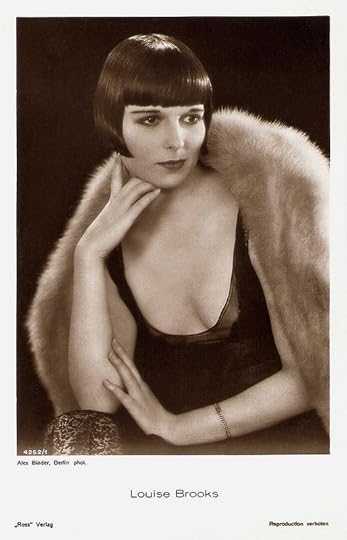
German postcard by Ross Verlag, no. 4252/1, 1929-1930. Photo: Alex Binder, Berlin.
Paramount
Mary Louise Brooks was born in the Midwestern town of Cherryvale, Kansas, in 1906. She was the daughter of Leonard Porter Brooks, a lawyer, who was usually too busy with his practice to discipline his children, and Myra Rude. Rude was a talented pianist who played the latest Debussy and Ravel for her children, inspiring them with a love of books and music. None of this protected her nine-year old daughter Louise from sexual abuse at the hands of a neighbourhood predator. This event had a major influence on Brooks' life and career.
Brooks began her entertainment career as a dancer, joining the Denishawn modern dance company in Los Angeles (whose members included Ruth St. Denis, Ted Shawn and Martha Graham) in 1922. St. Denis abruptly fired Brooks from the troupe in 1924. Brooks became a chorus girl in George White's Scandals, followed by an appearance as a featured dancer in the 1925 edition of the Ziegfeld Follies on Broadway.
As a result of her work in the Follies, she came to the attention of Paramount Pictures producer Walter Wanger, who signed her to a five-year contract with the studio in 1925. Brooks made her screen debut in an uncredited role in the silent The Street of Forgotten Men (Herbert Brenon, 1925). Over the next few years, she played the female lead in silent light comedies and flapper films, like It's the Old Army Game (Eddie Sutherland, 1926) opposite W. C. Fields.
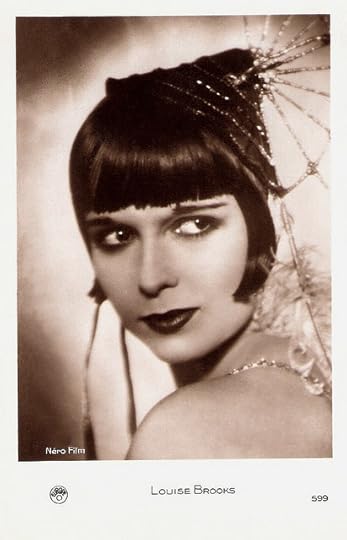
French postcard by Europe, no. 599. Photo: Néro Film.
Haunting, Provocative Performances
Louise Brooks was noticed in Europe for her pivotal vamp role in the buddy film A Girl in Every Port (Howard Hawks, 1928). That year, she also made the early sound film drama Beggars of Life (William Wellman, 1928). Brooks played an abused country girl on the run who meets two hoboes (Richard Arlen and Wallace Beery).
By this time in her life, she was mixing with the rich and famous, and was a regular guest of William Randolph Hearst and his mistress, Marion Davies, at San Simeon. Her distinctive bob haircut helped start a trend; many women styled their hair in imitation of her and fellow film star Colleen Moore.
Soon after Beggars Of Life, Brooks refused to stay on at Paramount after being denied a promised raise. She left for Europe to make films for G. W. Pabst, the prominent Austrian Expressionist director. In Germany, she starred as Lulu in Die Büchse der Pandora/Pandora's Box (Georg Wilhelm Pabst, 1929). The film is based on two plays by Frank Wedekind (Erdgeist and Die Büchse der Pandora) and Brooks plays the central figure. This film is notable for its frank treatment of modern sexual mores, including one of the first screen portrayals of a lesbian.
Brooks then starred in Pabst’s controversial social drama Tagebuch einer Verlorenen/Diary of a Lost Girl (Georg Wilhelm Pabst, 1929), based on the book by Margarete Böhme. In France she filmed Prix de Beauté/Miss Europe (Augusto Genina, 1930).
Hal Erickson at AllMovie : “Her haunting, provocative performances in Pabst's Pandora's Box (1928) and Diary of a Lost Girl (1929) not only established her as a screen personality of the first rank, but also fostered a Louise Brooks ‘cult’ which continued to flourish. (...) Not as highly regarded as Louise Brooks' German films for G. W. Pabst, Prix de Beaute nonetheless succeeds in terms of visual dynamics and the naturalness of the star's performance.”
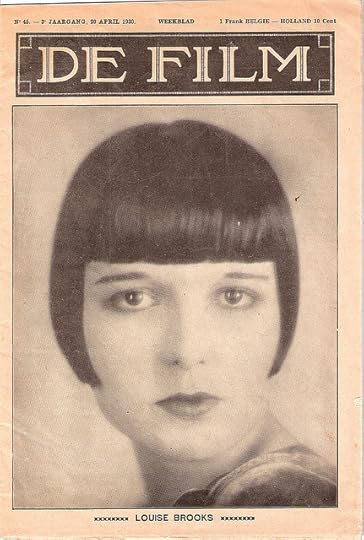
Cover of De Film, 20 April 1930. De Film was a Belgium film magazine.
Lulu in Hollywood
When Louise Brooks returned to Hollywood in 1931, she was cast in two mainstream films: God's Gift to Women (Michael Curtiz, 1931) and It Pays to Advertise (Frank Tuttle, 1931). Her performances in these films, however, were largely ignored, and few other job offers were forthcoming. She turned down the female lead opposite James Cagney in Public Enemy (William Wellman, 1931) which marked the end of her film career.
Furthermore she was only cast in bit parts and roles in B pictures and short films. At 32, Brooks retired from the screen after completing one last film, the John Wayne western Overland Stage Raiders (George Sherman, 1938). She then briefly returned to Wichita, where she was raised. After an unsuccessful attempt at operating a dance studio, she returned East and, after brief stints as a radio actor and a gossip columnist, worked as a salesgirl in a Saks Fifth Avenue store in New York City for a few years, then eked out a living as a courtesan with a few select wealthy men as clients.
In the early 1950s French film historians rediscovered her films, proclaiming her as an actress who surpassed even Marlene Dietrich and Greta Garbo as a film icon, much to her amusement. It rehabilitated her reputation in the US. With the help of James Card, film curator for the George Eastman House, she became a writer of well-researched and well-balanced articles on film history. She published her witty, extremely candid autobiography, Lulu in Hollywood, in 1982.
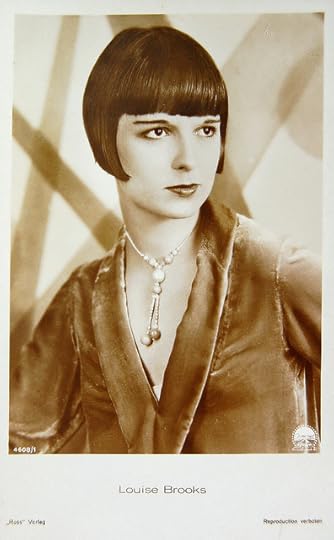
German postcard by Ross Verlag, no. 4608/1, 1929-1930. Photo: Paramount. Collection: Anni Raasu (Shme @ Flickr).
Speculation
Louise Brooks was married twice. In 1926, she had married director Eddie Sutherland, but they divorced in 1928 because of her relationship with George Preston Marshall, owner of a chain of laundries and future owner of the Washington Redskins football team.
In 1933, she married Chicago millionaire Deering Davis, but abruptly left him after only five months of marriage. The couple officially divorced in 1938.
Brooks enjoyed fostering speculation about her sexuality, cultivating friendships with lesbian and bisexual women, but eschewing relationships.
In 1985, Louise Brooks was found dead of a heart attack in her home in Rochester. She was 78 years old, and had appeared in only 25 films.
Scene from Die Büchse der Pandora/Pandora's Box (1929). Lulu dances with Countess Augusta Geschwitz (Alice Roberts), one of cinema's earliest representations of lesbian desire. Source: ButchInProgress (YouTube).
This was the seventh episode of 'Imported from the USA'. Earlier episodes were dedicated to Jayne Mansfield , Josephine Baker , Lex Barker, Anna May Wong, Carroll Baker and Farley Granger.
Sources: Hal Erickson (AllMovie), (IMDb), Wikipedia, and .
Louise Brooks (1906-1985) is one of the stars who are highlighted during Le Giornate del Cinema Muto 2013 and she is also next in our series 'Imported from the USA'. The legendary dancer and film actress set the trend of the bobbed haircut and personified the 'flapper', the rebellious young woman of the 1920s. Brooks played the lead in three European silent film classics: Die Büchse der Pandora/Pandora's Box (1929), Tagebuch einer Verlorenen/Diary of a Lost Girl (1929), and Prix de Beauté/Miss Europe (1930).

German postcard by Ross Verlag, no. 4252/1, 1929-1930. Photo: Alex Binder, Berlin.
Paramount
Mary Louise Brooks was born in the Midwestern town of Cherryvale, Kansas, in 1906. She was the daughter of Leonard Porter Brooks, a lawyer, who was usually too busy with his practice to discipline his children, and Myra Rude. Rude was a talented pianist who played the latest Debussy and Ravel for her children, inspiring them with a love of books and music. None of this protected her nine-year old daughter Louise from sexual abuse at the hands of a neighbourhood predator. This event had a major influence on Brooks' life and career.
Brooks began her entertainment career as a dancer, joining the Denishawn modern dance company in Los Angeles (whose members included Ruth St. Denis, Ted Shawn and Martha Graham) in 1922. St. Denis abruptly fired Brooks from the troupe in 1924. Brooks became a chorus girl in George White's Scandals, followed by an appearance as a featured dancer in the 1925 edition of the Ziegfeld Follies on Broadway.
As a result of her work in the Follies, she came to the attention of Paramount Pictures producer Walter Wanger, who signed her to a five-year contract with the studio in 1925. Brooks made her screen debut in an uncredited role in the silent The Street of Forgotten Men (Herbert Brenon, 1925). Over the next few years, she played the female lead in silent light comedies and flapper films, like It's the Old Army Game (Eddie Sutherland, 1926) opposite W. C. Fields.

French postcard by Europe, no. 599. Photo: Néro Film.
Haunting, Provocative Performances
Louise Brooks was noticed in Europe for her pivotal vamp role in the buddy film A Girl in Every Port (Howard Hawks, 1928). That year, she also made the early sound film drama Beggars of Life (William Wellman, 1928). Brooks played an abused country girl on the run who meets two hoboes (Richard Arlen and Wallace Beery).
By this time in her life, she was mixing with the rich and famous, and was a regular guest of William Randolph Hearst and his mistress, Marion Davies, at San Simeon. Her distinctive bob haircut helped start a trend; many women styled their hair in imitation of her and fellow film star Colleen Moore.
Soon after Beggars Of Life, Brooks refused to stay on at Paramount after being denied a promised raise. She left for Europe to make films for G. W. Pabst, the prominent Austrian Expressionist director. In Germany, she starred as Lulu in Die Büchse der Pandora/Pandora's Box (Georg Wilhelm Pabst, 1929). The film is based on two plays by Frank Wedekind (Erdgeist and Die Büchse der Pandora) and Brooks plays the central figure. This film is notable for its frank treatment of modern sexual mores, including one of the first screen portrayals of a lesbian.
Brooks then starred in Pabst’s controversial social drama Tagebuch einer Verlorenen/Diary of a Lost Girl (Georg Wilhelm Pabst, 1929), based on the book by Margarete Böhme. In France she filmed Prix de Beauté/Miss Europe (Augusto Genina, 1930).
Hal Erickson at AllMovie : “Her haunting, provocative performances in Pabst's Pandora's Box (1928) and Diary of a Lost Girl (1929) not only established her as a screen personality of the first rank, but also fostered a Louise Brooks ‘cult’ which continued to flourish. (...) Not as highly regarded as Louise Brooks' German films for G. W. Pabst, Prix de Beaute nonetheless succeeds in terms of visual dynamics and the naturalness of the star's performance.”

Cover of De Film, 20 April 1930. De Film was a Belgium film magazine.
Lulu in Hollywood
When Louise Brooks returned to Hollywood in 1931, she was cast in two mainstream films: God's Gift to Women (Michael Curtiz, 1931) and It Pays to Advertise (Frank Tuttle, 1931). Her performances in these films, however, were largely ignored, and few other job offers were forthcoming. She turned down the female lead opposite James Cagney in Public Enemy (William Wellman, 1931) which marked the end of her film career.
Furthermore she was only cast in bit parts and roles in B pictures and short films. At 32, Brooks retired from the screen after completing one last film, the John Wayne western Overland Stage Raiders (George Sherman, 1938). She then briefly returned to Wichita, where she was raised. After an unsuccessful attempt at operating a dance studio, she returned East and, after brief stints as a radio actor and a gossip columnist, worked as a salesgirl in a Saks Fifth Avenue store in New York City for a few years, then eked out a living as a courtesan with a few select wealthy men as clients.
In the early 1950s French film historians rediscovered her films, proclaiming her as an actress who surpassed even Marlene Dietrich and Greta Garbo as a film icon, much to her amusement. It rehabilitated her reputation in the US. With the help of James Card, film curator for the George Eastman House, she became a writer of well-researched and well-balanced articles on film history. She published her witty, extremely candid autobiography, Lulu in Hollywood, in 1982.

German postcard by Ross Verlag, no. 4608/1, 1929-1930. Photo: Paramount. Collection: Anni Raasu (Shme @ Flickr).
Speculation
Louise Brooks was married twice. In 1926, she had married director Eddie Sutherland, but they divorced in 1928 because of her relationship with George Preston Marshall, owner of a chain of laundries and future owner of the Washington Redskins football team.
In 1933, she married Chicago millionaire Deering Davis, but abruptly left him after only five months of marriage. The couple officially divorced in 1938.
Brooks enjoyed fostering speculation about her sexuality, cultivating friendships with lesbian and bisexual women, but eschewing relationships.
In 1985, Louise Brooks was found dead of a heart attack in her home in Rochester. She was 78 years old, and had appeared in only 25 films.
Scene from Die Büchse der Pandora/Pandora's Box (1929). Lulu dances with Countess Augusta Geschwitz (Alice Roberts), one of cinema's earliest representations of lesbian desire. Source: ButchInProgress (YouTube).
This was the seventh episode of 'Imported from the USA'. Earlier episodes were dedicated to Jayne Mansfield , Josephine Baker , Lex Barker, Anna May Wong, Carroll Baker and Farley Granger.
Sources: Hal Erickson (AllMovie), (IMDb), Wikipedia, and .
Published on October 04, 2013 23:00
October 3, 2013
Jan van Dommelen
Jan van Dommelen (1878-1942) was a Dutch film actor of the silent era. He appeared in 44 films between 1911 and 1939.
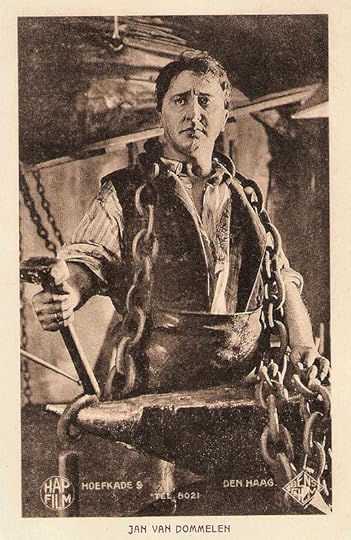
Dutch postcard by E & B. Photo by HAP Film / Bens Film, Den Haag. Publicity still for the film Schakels/Connections (Maurits Binger, 1920), based on a play by Herman Heijermans.
The actor plays a blacksmith called Pancras Duif (Dove), who struggles to raise his family. After 25 years, he is old and widower, and has managed to raise a successful business, now run by his son Henry ( Adelqui Migliar ). His other son Tony (Frits Bouwmeester), however, who is a spendthrift, disagrees on his father's new relationship with his maid Marian (Annie Bos), so he tries to blacken her. Schakels is a lost film.
Nihilists
Johannes Sebastianus Engelbertus (Jan) van Dommelen was born in Amsterdam, the Netherlands in 1878. He was the son of prolific actor Carolus Christiaan (Charles) van Dommelen and Anna van Duijl. Of his nine siblings, three others also became well known actors, Frits van Dommelen (1867-1932), Caroline van Dommelen (1874-1957) an Louis van Dommelen (1885-1970).
Jan started to study at the Amsterdam Theatre School in 1891 and after his graduation he joined the Koninklijke Vereeniging Het Nederlandsch Tooneel (the Royal Dutch Stage Company).
In 1911 he started to appear in silent shorts for Filmfabriek F.A. Nöggerath, like in the drama Ontrouw/Infidelity (Louis Chrispijn Jr., 1911) with his sister Caroline van Dommelen, and De bannelingen/The Exiles (Caroline van Dommelen, Léon Boedels, 1911) about a 19th century group of nihilists which wants to improve the horrible conditions for prisoners in Russia.
Nöggerath's film production collapsed in 1913, but luckily Van Dommelen found employment at the new film studio Hollandia in Haarlem, run by former printer Maurits Binger.
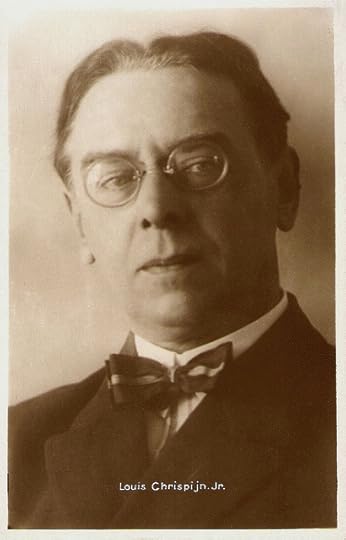
Louis Chrispijn Jr. Dutch postcard by Weenenk & Snel, Den Haag. Photo: Willem Coret.
Found Again
At Hollandia, Jan van Dommelen first played Willem the Silent/William of Orange/William I of the Netherlands in the Dutch silent historical drama Nederland en Oranje aka Oranje en Nederland/The Netherlands and The House of Orange (Louis H. Chrispijn,1913). The film features nineteen short pieces with themes from Dutch national history and was made to celebrate the Dutch Kingdom. Much of the segments are tableau vivants, with much eye for accuracy when it comes to appearance.
For years Van Dommelen was a regular at Hollandia, which would become the most important Dutch film studio of the silent period. He played both a priest ad the protagonist's alcoholic father in Silvia Silombra (Louis H. Chrispijn, 1913), starring Julia Cuypers, and a painter in the Far West in Liefde waakt/An Artist's Model (Louis H. Chrispijn, 1914) starring Annie Bos.
Other titles were Krates (Louis H. Chrispijn, 1913), Zijn viool/De Stradivarius/His Violin (Maurits Binger; 1914) starring violin player Boris Lensky, De bloemen die de ziel vertroosten/The flowers which comfort the soul (Louis H. Chrispijn, 1914), Heilig recht/Sacred right (Louis H. Chrispijn, 1914), and Luchtkastelen/Castles in the sky (Louis H. Chrispijn, 1914).
Most of these films got lost but Weergevonden/Found Again (Louis H. Chrispijn, 1914) with Enny de Leeuwe, has literally been found again. Van Dommelen here performed a non-Jewish doctor, rejected by the Jewish father (played by Chrispijn himself). The film was largely shot in old Amsterdam, partly in Haarlem.
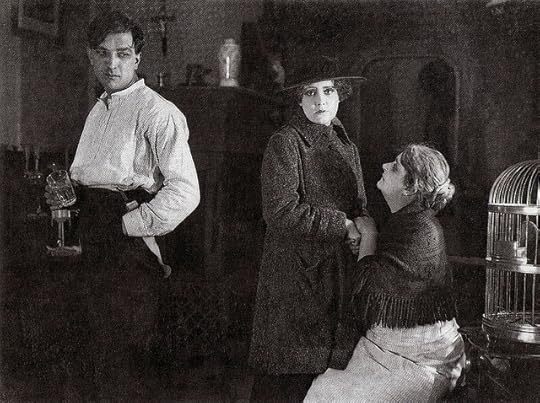
Adelqui Migliar and Annie Bos. Publicity still. Source: Immagine. Nuova Serie N. 16, 1990-1991.
Large-Scale Project Jan van Dommelen also directed films, like the silent comedy Toffe Jongens onder de Mobilisatie/Cool boys under the mobilization (Jan van Dommelen, 1914) starring Annie Bos, and referring to the mobilization during the First World War.
One of his biggest films was De Vloek van het Testament/The Fatal Woman (Maurits Binger, Louis H. Chrispijn, 1914) about a testimony found in an old wooden desk. It even was shown in the US.
Another ambitious Hollandia production was the crime film Het geheim van den vuurtoren/The Secret of the Lighthouse (Maurits Binger, 1916) which was also sold to France, where it was titled Le Secret du Phare. It was a large-scale project because it required the construction of a 20 meter high ruined lighthouse, and a 15 metre long pier of the coast of Zandvoort. The film starred such famous Dutch actors as Willem van der Veer, Annie Bos and Coen Hissink.

Esther de Boer-van Rijk in her Kniertje costume for Op hoop van zegen/The Good Hope. Dutch postcard by Foto-Industrie De Voorkeur, Amsterdam, no 22927. Photo: Leenheer.
One of the Best Silent Dutch Films
Other Hollandia productions in which Jan van Dommelen appeared were the - still surviving - drama Het geheim van Delft/The Secret of Delft (Maurits Binger, 1917) with Annie Bos and Lily Bouwmeester, Madame Pinkette & Co (Maurits Binger, 1917) with Bos and Adelqui Migliar , and De Kroon der Schande/The Crown of Shame (Maurits Binger, 1918) with Willem van der Veer.
He also appeared in the silent film adaptation of the classic play Op hoop van zegen/The Good Hope (Maurits Binger, 1918) starring Esther de Boer-van Rijk and Annie Bos.
And he competed with Adelqui Migliar for the love of Carmen (Annie Bos) in the romantic drama Een Carmen van het Noorden/A Carmen of the North (Maurits Binger/ Hans Nesna, 1919). This film survives too and has been shown with newly made scores. The film is considered one of the best silent Dutch films, that's why it is part of the Canon of Dutch Films, established in 2007, and existing of 16 films. In 2009 a remake of the film was made by Jelle Nesna, grandson of Hans Nesna. The film is a hip-hop version of the original film and stars Tycho Gernandt. From the version with Van Dommelen only an American export version still exists, so it has a happy end.
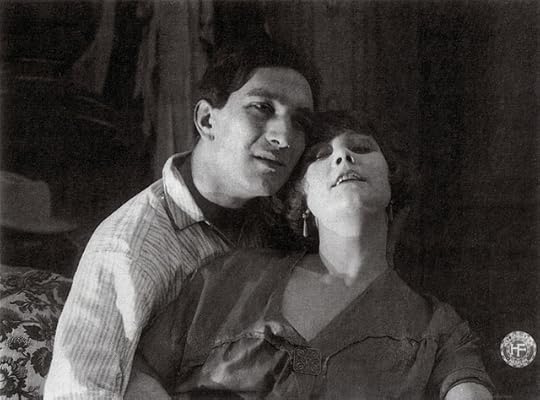
Adelqui Migliar and Annie Bos in Een Carmen van het Noorden/A Carmen of the North (Maurits Binger/ Hans Nesna, 1919). Publicity still. Source: Immagine. Nuova Serie N. 16, 1990-1991.
Bulldog Drummond
Jan van Dommelen played the lead role in Schakels/Connections (Maurits Binger, 1920) based on a play by Herman Heijermans.
He then had a small part in the British-Dutch coproduction Bulldog Drummond (Oscar Apfel, 1922), the first film adaptation of the Bulldog Drummond fictional character, produced by Maurits Binger.
He then played Beth’s husband in the folk drama Bleeke Bet/Pale Beth (Alex Benno, 1923) featuring Alida van Gijtenbeek as Beth, and also with Beppie de Vries, Heintje Davids and Johan Elsensohn .
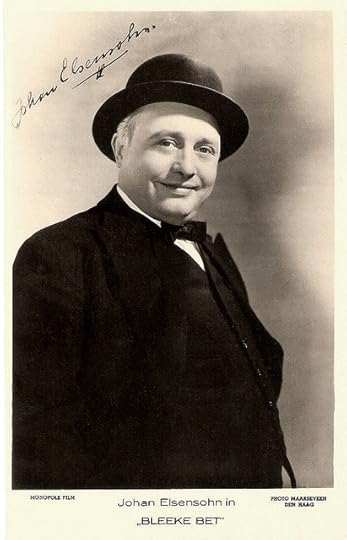
Johan Elsensohn . Dutch postcard by M.B. & Z. (M. Bonnist & Zonen, Amsterdam). Photo: Dick van Maarseveen, Den Haag/Monopole Film. Publicity still for the sound version of Bleeke Bet (1934). Collection: Egbert Barten.
Experimental Sound Film
Arnoud Tiele at IMDb : “In 1927 he funded an experimental sound film out of his own pocket, Het heksenlied. The idea was to let an orchestra play, while Van Dommelen recited his text from behind the curtains, while the film images rolled. The experiment failed because in the mean time, ordinary sound films were already produced. The sound film meant virtually the end for the career of Jan van Dommelen”.
After the introduction of sound film, he only appeared in minor parts in films like the comedy De Familie van mijn Vrouw/My Wife's Family (Jaap Speijer, 1935) starring Johan Kaart , the military comedy De Big van het Regiment/The Mascot of the Company (Max Nosseck, 1937) with Frits van Dongen , and finally Boefje/Wilton's Zoo (Detlef Sierck aka Douglas Sirk, 1939) featuring Annie van Ees .
Jan van Dommelen died in 1942 in Santpoort, the Netherlands. He was 64. He had been married twice: from 1904 to 1910 with Margaretha Josina Josephine Anjelier with whom he had a daughter, and in 1918 he married Johanna de Vries. They stayed together till his death and had two children.
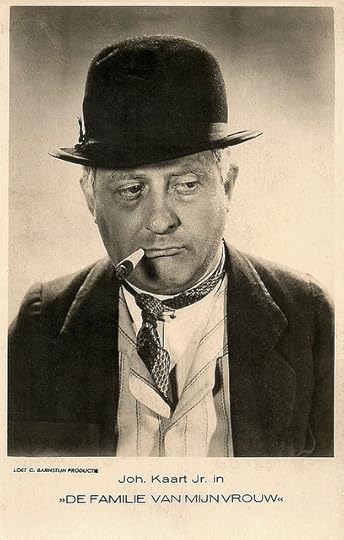
Johan Kaart Jr. in the Dutch comedy De familie van mijn vrouw/My Wife's Family (Jaap Speyer, 1935). Dutch postcard. M.B. & Z. Photo: Loet C. Barnstijn Productie.
Sources: Geoffrey Donaldson (Historici.nl) (Dutch), (IMDb), Film in Nederland (Dutch), Wikipedia (English and Dutch) and .

Dutch postcard by E & B. Photo by HAP Film / Bens Film, Den Haag. Publicity still for the film Schakels/Connections (Maurits Binger, 1920), based on a play by Herman Heijermans.
The actor plays a blacksmith called Pancras Duif (Dove), who struggles to raise his family. After 25 years, he is old and widower, and has managed to raise a successful business, now run by his son Henry ( Adelqui Migliar ). His other son Tony (Frits Bouwmeester), however, who is a spendthrift, disagrees on his father's new relationship with his maid Marian (Annie Bos), so he tries to blacken her. Schakels is a lost film.
Nihilists
Johannes Sebastianus Engelbertus (Jan) van Dommelen was born in Amsterdam, the Netherlands in 1878. He was the son of prolific actor Carolus Christiaan (Charles) van Dommelen and Anna van Duijl. Of his nine siblings, three others also became well known actors, Frits van Dommelen (1867-1932), Caroline van Dommelen (1874-1957) an Louis van Dommelen (1885-1970).
Jan started to study at the Amsterdam Theatre School in 1891 and after his graduation he joined the Koninklijke Vereeniging Het Nederlandsch Tooneel (the Royal Dutch Stage Company).
In 1911 he started to appear in silent shorts for Filmfabriek F.A. Nöggerath, like in the drama Ontrouw/Infidelity (Louis Chrispijn Jr., 1911) with his sister Caroline van Dommelen, and De bannelingen/The Exiles (Caroline van Dommelen, Léon Boedels, 1911) about a 19th century group of nihilists which wants to improve the horrible conditions for prisoners in Russia.
Nöggerath's film production collapsed in 1913, but luckily Van Dommelen found employment at the new film studio Hollandia in Haarlem, run by former printer Maurits Binger.

Louis Chrispijn Jr. Dutch postcard by Weenenk & Snel, Den Haag. Photo: Willem Coret.
Found Again
At Hollandia, Jan van Dommelen first played Willem the Silent/William of Orange/William I of the Netherlands in the Dutch silent historical drama Nederland en Oranje aka Oranje en Nederland/The Netherlands and The House of Orange (Louis H. Chrispijn,1913). The film features nineteen short pieces with themes from Dutch national history and was made to celebrate the Dutch Kingdom. Much of the segments are tableau vivants, with much eye for accuracy when it comes to appearance.
For years Van Dommelen was a regular at Hollandia, which would become the most important Dutch film studio of the silent period. He played both a priest ad the protagonist's alcoholic father in Silvia Silombra (Louis H. Chrispijn, 1913), starring Julia Cuypers, and a painter in the Far West in Liefde waakt/An Artist's Model (Louis H. Chrispijn, 1914) starring Annie Bos.
Other titles were Krates (Louis H. Chrispijn, 1913), Zijn viool/De Stradivarius/His Violin (Maurits Binger; 1914) starring violin player Boris Lensky, De bloemen die de ziel vertroosten/The flowers which comfort the soul (Louis H. Chrispijn, 1914), Heilig recht/Sacred right (Louis H. Chrispijn, 1914), and Luchtkastelen/Castles in the sky (Louis H. Chrispijn, 1914).
Most of these films got lost but Weergevonden/Found Again (Louis H. Chrispijn, 1914) with Enny de Leeuwe, has literally been found again. Van Dommelen here performed a non-Jewish doctor, rejected by the Jewish father (played by Chrispijn himself). The film was largely shot in old Amsterdam, partly in Haarlem.

Adelqui Migliar and Annie Bos. Publicity still. Source: Immagine. Nuova Serie N. 16, 1990-1991.
Large-Scale Project Jan van Dommelen also directed films, like the silent comedy Toffe Jongens onder de Mobilisatie/Cool boys under the mobilization (Jan van Dommelen, 1914) starring Annie Bos, and referring to the mobilization during the First World War.
One of his biggest films was De Vloek van het Testament/The Fatal Woman (Maurits Binger, Louis H. Chrispijn, 1914) about a testimony found in an old wooden desk. It even was shown in the US.
Another ambitious Hollandia production was the crime film Het geheim van den vuurtoren/The Secret of the Lighthouse (Maurits Binger, 1916) which was also sold to France, where it was titled Le Secret du Phare. It was a large-scale project because it required the construction of a 20 meter high ruined lighthouse, and a 15 metre long pier of the coast of Zandvoort. The film starred such famous Dutch actors as Willem van der Veer, Annie Bos and Coen Hissink.

Esther de Boer-van Rijk in her Kniertje costume for Op hoop van zegen/The Good Hope. Dutch postcard by Foto-Industrie De Voorkeur, Amsterdam, no 22927. Photo: Leenheer.
One of the Best Silent Dutch Films
Other Hollandia productions in which Jan van Dommelen appeared were the - still surviving - drama Het geheim van Delft/The Secret of Delft (Maurits Binger, 1917) with Annie Bos and Lily Bouwmeester, Madame Pinkette & Co (Maurits Binger, 1917) with Bos and Adelqui Migliar , and De Kroon der Schande/The Crown of Shame (Maurits Binger, 1918) with Willem van der Veer.
He also appeared in the silent film adaptation of the classic play Op hoop van zegen/The Good Hope (Maurits Binger, 1918) starring Esther de Boer-van Rijk and Annie Bos.
And he competed with Adelqui Migliar for the love of Carmen (Annie Bos) in the romantic drama Een Carmen van het Noorden/A Carmen of the North (Maurits Binger/ Hans Nesna, 1919). This film survives too and has been shown with newly made scores. The film is considered one of the best silent Dutch films, that's why it is part of the Canon of Dutch Films, established in 2007, and existing of 16 films. In 2009 a remake of the film was made by Jelle Nesna, grandson of Hans Nesna. The film is a hip-hop version of the original film and stars Tycho Gernandt. From the version with Van Dommelen only an American export version still exists, so it has a happy end.

Adelqui Migliar and Annie Bos in Een Carmen van het Noorden/A Carmen of the North (Maurits Binger/ Hans Nesna, 1919). Publicity still. Source: Immagine. Nuova Serie N. 16, 1990-1991.
Bulldog Drummond
Jan van Dommelen played the lead role in Schakels/Connections (Maurits Binger, 1920) based on a play by Herman Heijermans.
He then had a small part in the British-Dutch coproduction Bulldog Drummond (Oscar Apfel, 1922), the first film adaptation of the Bulldog Drummond fictional character, produced by Maurits Binger.
He then played Beth’s husband in the folk drama Bleeke Bet/Pale Beth (Alex Benno, 1923) featuring Alida van Gijtenbeek as Beth, and also with Beppie de Vries, Heintje Davids and Johan Elsensohn .

Johan Elsensohn . Dutch postcard by M.B. & Z. (M. Bonnist & Zonen, Amsterdam). Photo: Dick van Maarseveen, Den Haag/Monopole Film. Publicity still for the sound version of Bleeke Bet (1934). Collection: Egbert Barten.
Experimental Sound Film
Arnoud Tiele at IMDb : “In 1927 he funded an experimental sound film out of his own pocket, Het heksenlied. The idea was to let an orchestra play, while Van Dommelen recited his text from behind the curtains, while the film images rolled. The experiment failed because in the mean time, ordinary sound films were already produced. The sound film meant virtually the end for the career of Jan van Dommelen”.
After the introduction of sound film, he only appeared in minor parts in films like the comedy De Familie van mijn Vrouw/My Wife's Family (Jaap Speijer, 1935) starring Johan Kaart , the military comedy De Big van het Regiment/The Mascot of the Company (Max Nosseck, 1937) with Frits van Dongen , and finally Boefje/Wilton's Zoo (Detlef Sierck aka Douglas Sirk, 1939) featuring Annie van Ees .
Jan van Dommelen died in 1942 in Santpoort, the Netherlands. He was 64. He had been married twice: from 1904 to 1910 with Margaretha Josina Josephine Anjelier with whom he had a daughter, and in 1918 he married Johanna de Vries. They stayed together till his death and had two children.

Johan Kaart Jr. in the Dutch comedy De familie van mijn vrouw/My Wife's Family (Jaap Speyer, 1935). Dutch postcard. M.B. & Z. Photo: Loet C. Barnstijn Productie.
Sources: Geoffrey Donaldson (Historici.nl) (Dutch), (IMDb), Film in Nederland (Dutch), Wikipedia (English and Dutch) and .
Published on October 03, 2013 23:00
Paul van Yperen's Blog
- Paul van Yperen's profile
- 13 followers
Paul van Yperen isn't a Goodreads Author
(yet),
but they
do have a blog,
so here are some recent posts imported from
their feed.



